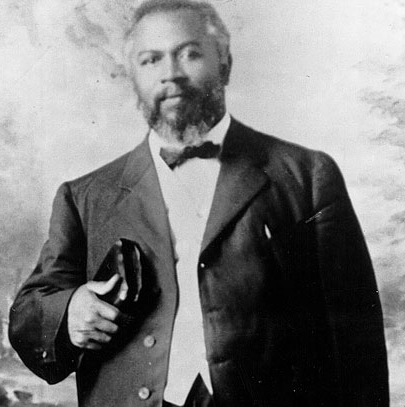
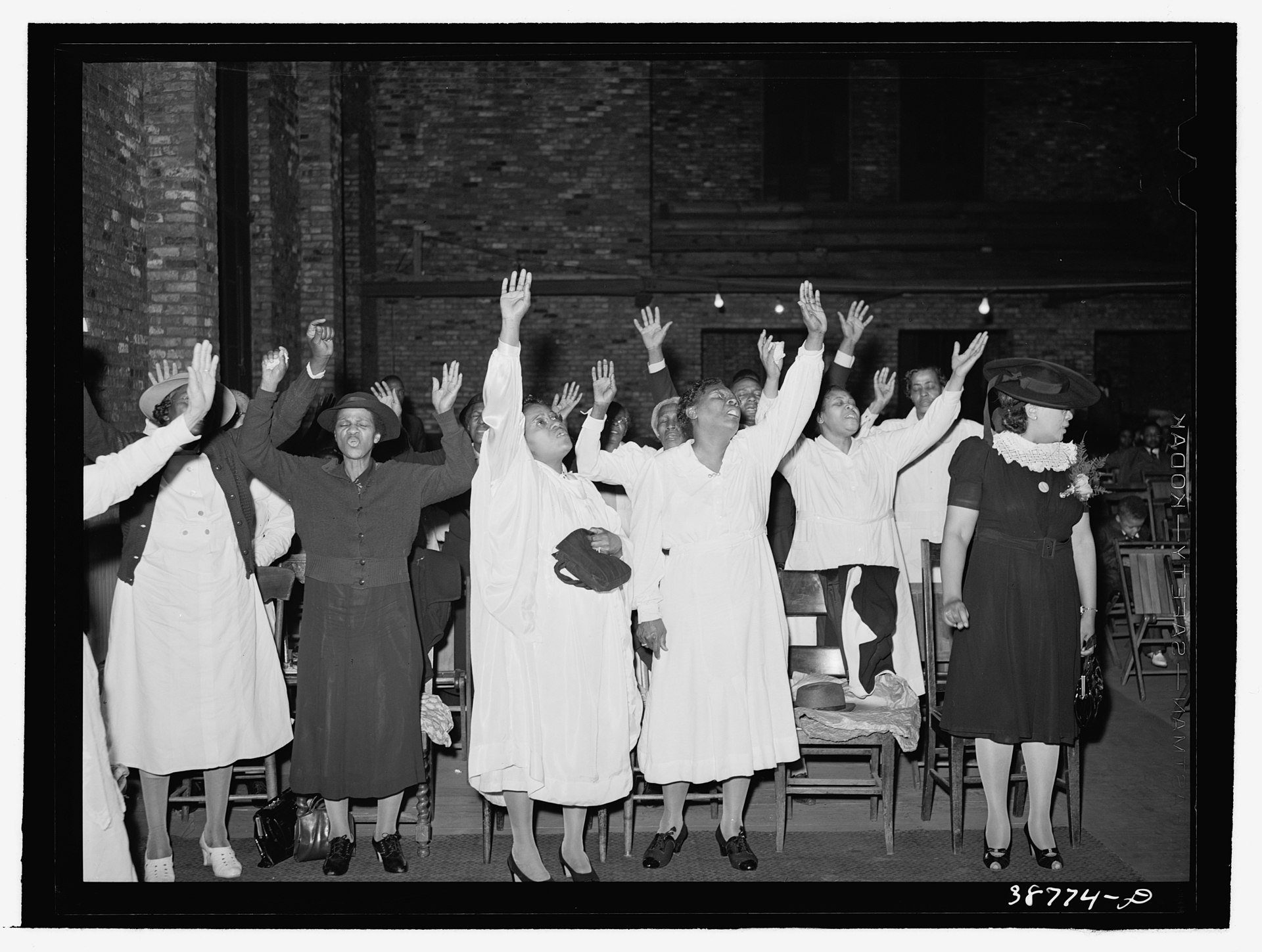
ペンテコステ派/ペンテコステ運動
Pentecostalism
William
Seymour, leader of the Azusa Street Revival / Women in a Pentecostal
worship service
☆ ペンテコステ派、または古典的ペンテコステ派は、プロテスタントのキリスト教の幅広い福音派の一派[1][2][3] で、聖霊の洗礼による神との直接的な体験を重視する運動だ。[1] 「ペンテコステ派」という用語は、使徒行伝(使徒行伝2章1節から31節)に記述されている、イエス・キリストの弟子たちがエルサレムで七週の祭りを祝っ ていた際に、使徒たちや他の信者たちに聖霊が降臨した出来事を記念する「ペンテコステ」に由来する。 他の形態の福音主義プロテスタントと同様[5]、ペンテコステ派は、聖書の無誤性と「新生」の必要性を信奉している。新生とは、個人が自分の罪を悔い改 め、「イエス・キリストを自分の個人的な主であり救い主である」と受け入れることだ。ペンテコステ派は、「聖霊のバプテスマ」と水によるバプテスマの両方 を信じることで、キリスト教徒が「聖霊に満たされ、力を与えられた人生」を送ることができると信じている点で、他のプロテスタントと区別される。この力に は、異言や神の癒しなどの霊的賜物の使用が含まれる。[1] 聖書の権威、霊的賜物、奇跡へのコミットメントから、ペンテコステ派は自らの運動を、初期教会の使徒時代に見られた同じ種類の霊的力と教義を反映したもの と見なしている。このため、一部のペンテコステ派は、自らの運動を「使徒的」または「フル・ゴスペル」と表現することもある。[1] 聖潔ペンテコステ派は、キリスト教の復興運動とキリストの再臨の迫り来る期待に活気づけられたウェスレー聖潔運動の信者たちの中から、20 世紀初頭に誕生した。[6] 彼らは、自分たちが終末の時代に生きていると信じ、神がキリスト教教会を霊的に刷新し、霊的な賜物の回復と世界への伝道を実現すると期待していた。 1900年、アメリカの伝道者兼信仰治療家であるチャールズ・パーハムは、異言を話すことが聖霊のバプテスマの聖書的な証拠であると教え始めた。ウェス レー派のホーリネス派の説教者ウィリアム・J・シーモアと共に、彼はこれが「第三の恵みの業」であると教えた。[7] セイモアがカリフォルニア州ロサンゼルスで設立し指導した3年間に及ぶアズサ・ストリート・リバイバルは、アメリカ合衆国および世界中にペンテコステ派の 拡大をもたらした。訪問者はペンテコステ派の体験を故郷の教会に持ち帰ったり、宣教地に召されたと感じたりした。ほぼすべてのペンテコステ派教派はアズ サ・ストリートに起源をたどるが、この運動は複数の分裂と論争を経験してきた。初期の論争は、完全聖化教義への挑戦に焦点を当てていましたが、後には聖三 位一体教義への挑戦に移りました。その結果、ペンテコステ派は、三つの明確な恵みの業を肯定する「ホーリネス・ペンテコステ派」と、三位一体派と非三位一 体派に分かれた「フィニッシュド・ワーク・ペンテコステ派」に分割され、後者は「オネネス・ペンテコステ派」を生み出した。[8][9]
| Pentecostalism or
classical Pentecostalism is a movement within the broader Evangelical
wing of Protestant Christianity[1][2][3] that emphasizes direct
personal experience of God through baptism with the Holy Spirit.[1] The
term Pentecostal is derived from Pentecost, an event that commemorates
the descent of the Holy Spirit upon the Apostles and other followers of
Jesus Christ while they were in Jerusalem celebrating the Feast of
Weeks, as described in the Acts of the Apostles (Acts 2:1–31).[4] Like other forms of evangelical Protestantism,[5] Pentecostalism adheres to the inerrancy of the Bible and the necessity of the New Birth: an individual repenting of their sin and "accepting Jesus Christ as their personal Lord and Savior". It is distinguished by belief in both the "baptism in the Holy Spirit" and baptism by water, that enables a Christian to "live a Spirit-filled and empowered life". This empowerment includes the use of spiritual gifts: such as speaking in tongues and divine healing.[1] Because of their commitment to biblical authority, spiritual gifts, and the miraculous, Pentecostals see their movement as reflecting the same kind of spiritual power and teachings that were found in the Apostolic Age of the Early Church. For this reason, some Pentecostals also use the term "Apostolic" or "Full Gospel" to describe their movement.[1] Holiness Pentecostalism emerged in the early 20th century among adherents of the Wesleyan-Holiness movement, who were energized by Christian revivalism and expectation of the imminent Second Coming of Christ.[6] Believing that they were living in the end times, they expected God to spiritually renew the Christian Church and bring to pass the restoration of spiritual gifts and the evangelization of the world. In 1900, Charles Parham, an American evangelist and faith healer, began teaching that speaking in tongues was the Biblical evidence of Spirit baptism. Along with William J. Seymour, a Wesleyan-Holiness preacher, he taught that this was the third work of grace.[7] The three-year-long Azusa Street Revival, founded and led by Seymour in Los Angeles, California, resulted in the growth of Pentecostalism throughout the United States and the rest of the world. Visitors carried the Pentecostal experience back to their home churches or felt called to the mission field. While virtually all Pentecostal denominations trace their origins to Azusa Street, the movement has had several divisions and controversies. Early disputes centered on challenges to the doctrine of entire sanctification, and later on, the Holy Trinity. As a result, the Pentecostal movement is divided between Holiness Pentecostals who affirm three definite works of grace,[6] and Finished Work Pentecostals who are partitioned into trinitarian and non-trinitarian branches, the latter giving rise to Oneness Pentecostalism.[8][9] Comprising over 700 denominations and many independent churches, Pentecostalism is highly decentralized.[10] No central authority exists, but many denominations are affiliated with the Pentecostal World Fellowship. With over 279 million classical Pentecostals worldwide, the movement is growing in many parts of the world, especially the Global South and Third World countries.[10][11][12][13][14] Since the 1960s, Pentecostalism has increasingly gained acceptance from other Christian traditions, and Pentecostal beliefs concerning the baptism of the Holy Spirit and spiritual gifts have been embraced by non-Pentecostal Christians in Protestant and Catholic churches through their adherence to the Charismatic movement. Together, worldwide Pentecostal and Charismatic Christianity numbers over 644 million adherents.[15] While the movement originally attracted mostly lower classes in the global South, there is a new appeal to middle classes.[16][17][18] Middle-class congregations tend to have fewer members.[19][20][21] Pentecostalism is believed to be the fastest-growing religious movement in the world.[22] |
ペンテコステ派、または古典的ペンテコステ派は、プロテスタントのキリ
スト教の幅広い福音派の一派[1][2][3] で、聖霊の洗礼による神との直接的な体験を重視する運動だ。[1]
「ペンテコステ派」という用語は、使徒行伝(使徒行伝2章1節から31節)に記述されている、イエス・キリストの弟子たちがエルサレムで七週の祭りを祝っ
ていた際に、使徒たちや他の信者たちに聖霊が降臨した出来事を記念する「ペンテコステ」に由来する。 他の形態の福音主義プロテスタントと同様[5]、ペンテコステ派は、聖書の無誤性と「新生」の必要性を信奉している。新生とは、個人が自分の罪を悔い改 め、「イエス・キリストを自分の個人的な主であり救い主である」と受け入れることだ。ペンテコステ派は、「聖霊のバプテスマ」と水によるバプテスマの両方 を信じることで、キリスト教徒が「聖霊に満たされ、力を与えられた人生」を送ることができると信じている点で、他のプロテスタントと区別される。この力に は、異言や神の癒しなどの霊的賜物の使用が含まれる。[1] 聖書の権威、霊的賜物、奇跡へのコミットメントから、ペンテコステ派は自らの運動を、初期教会の使徒時代に見られた同じ種類の霊的力と教義を反映したもの と見なしている。このため、一部のペンテコステ派は、自らの運動を「使徒的」または「フル・ゴスペル」と表現することもある。[1] 聖潔ペンテコステ派は、キリスト教の復興運動とキリストの再臨の迫り来る期待に活気づけられたウェスレー聖潔運動の信者たちの中から、20 世紀初頭に誕生した。[6] 彼らは、自分たちが終末の時代に生きていると信じ、神がキリスト教教会を霊的に刷新し、霊的な賜物の回復と世界への伝道を実現すると期待していた。 1900年、アメリカの伝道者兼信仰治療家であるチャールズ・パーハムは、異言を話すことが聖霊のバプテスマの聖書的な証拠であると教え始めた。ウェス レー派のホーリネス派の説教者ウィリアム・J・シーモアと共に、彼はこれが「第三の恵みの業」であると教えた。[7] セイモアがカリフォルニア州ロサンゼルスで設立し指導した3年間に及ぶアズサ・ストリート・リバイバルは、アメリカ合衆国および世界中にペンテコステ派の 拡大をもたらした。訪問者はペンテコステ派の体験を故郷の教会に持ち帰ったり、宣教地に召されたと感じたりした。ほぼすべてのペンテコステ派教派はアズ サ・ストリートに起源をたどるが、この運動は複数の分裂と論争を経験してきた。初期の論争は、完全聖化教義への挑戦に焦点を当てていましたが、後には聖三 位一体教義への挑戦に移りました。その結果、ペンテコステ派は、三つの明確な恵みの業を肯定する「ホーリネス・ペンテコステ派」と、三位一体派と非三位一 体派に分かれた「フィニッシュド・ワーク・ペンテコステ派」に分割され、後者は「オネネス・ペンテコステ派」を生み出した。[8][9] 700以上の教派と多くの独立教会で構成されるペンテコステ派は、非常に分散化している[10]。中央の権威は存在しないが、多くの教派はペンテコステ派 世界連盟に加盟している。世界中に2億7900万人以上の古典的ペンテコステ派が存在し、この運動は世界の多くの地域、特にグローバル・サウスや第三世界 諸国で成長している[10][11]。[12][13][14] 1960年代以降、ペンテコステ派は他のキリスト教伝統から徐々に受け入れられるようになり、ペンテコステ派の聖霊の洗礼と霊的賜物に関する信仰は、プロ テスタントやカトリック教会におけるカリスマ運動への参加を通じて、非ペンテコステ派のキリスト教徒にも受け入れられるようになった。世界中のペンテコス テ派とカリスマ派キリスト教徒の総数は6億4,400万人を超える。[15] 当初、この運動は主にグローバル・サウス(南半球の途上国)の低所得層を惹きつけたが、現在では中間層にも新たな魅力が生まれている。[16][17] [18] 中間層の教会は信徒数が少ない傾向にある。[19][20][21] ペンテコステ派は、世界で最も急速に成長している宗教運動とされている。[22] |
| History Background Early Pentecostals have considered the movement a latter-day restoration of the church's apostolic power, and historians such as Cecil M. Robeck Jr. and Edith Blumhofer write that the movement emerged from late 19th-century radical evangelical revival movements in America and in Great Britain.[23][24] Within this radical evangelicalism, expressed most strongly in the Wesleyan–holiness and Higher Life movements, themes of restorationism, premillennialism, faith healing, and greater attention on the person and work of the Holy Spirit were central to emerging Pentecostalism.[25] Believing that the second coming of Christ was imminent, these Christians expected an endtime revival of apostolic power, spiritual gifts, and miracle-working.[26] Figures such as Dwight L. Moody and R. A. Torrey began to speak of an experience available to all Christians which would empower believers to evangelize the world, often termed baptism with the Holy Spirit.[27] Certain Christian leaders and movements had important influences on early Pentecostals. The essentially universal belief in the continuation of all the spiritual gifts in the Keswick and Higher Life movements constituted a crucial historical background for the rise of Pentecostalism.[28] Albert Benjamin Simpson (1843–1919) and his Christian and Missionary Alliance (founded in 1887) was very influential in the early years of Pentecostalism, especially on the development of the Assemblies of God. Another early influence on Pentecostals was John Alexander Dowie (1847–1907) and his Christian Catholic Apostolic Church (founded in 1896). Pentecostals embraced the teachings of Simpson, Dowie, Adoniram Judson Gordon (1836–1895) and Maria Woodworth-Etter (1844–1924; she later joined the Pentecostal movement) on healing.[29] Edward Irving's Catholic Apostolic Church (founded c. 1831) also displayed many characteristics later found in the Pentecostal revival.[30]: 131 Isolated Christian groups were experiencing charismatic phenomena such as divine healing and speaking in tongues. The Holiness Pentecostal movement provided a theological explanation for what was happening to these Christians, and they adapted a modified form of Wesleyan soteriology to accommodate their new understanding.[31][32][33] |
歴史 背景 初期のペンテコステ派は、この運動を教会の使徒的権威の現代における回復と捉えており、セシル・M・ロベック・ジュニアやエディス・ブルムホーファーなど の歴史家は、この運動は19世紀後半のアメリカとイギリスで起こった急進的な福音主義の復興運動から生まれたと記述している。[23][24] この急進的な福音主義の中で、ウェスレーの聖性運動やハイヤーライフ運動に最も強く表現された、復古主義、前千年王国説、信仰による癒し、そして聖霊の人 格と働きへの注目は、新興のペンテコステ派の中心的なテーマとなった[25]。キリストの再臨が間近であると信じていたこれらのキリスト教徒たちは、使徒 の権威、霊的賜物、そして奇跡の復活を、終末の時代に期待していた[26]。ドワイト・L・ムーディやR・A・トーリーのような人物は、すべてのキリスト 教徒が体験できる、信者を世界宣教に駆り立てる力となる体験について語り始め、これはしばしば「聖霊のバプテスマ」と呼ばれた。[27] 特定のキリスト教指導者や運動は、初期のペンテコステ派に重要な影響を与えた。ケズウィック運動とハイヤー・ライフ運動における、すべての霊的賜物の継続 という本質的に普遍的な信念は、ペンテコステ派の台頭にとって重要な歴史的背景となった。[28] アルバート・ベンジャミン・シンプソン(1843-1919)と彼のキリスト教宣教同盟(1887年設立)は、ペンテコステ派の初期、特に神召会の発展に 大きな影響を与えた。ペンテコステ派に初期の影響を与えたもう一人の人物は、ジョン・アレクサンダー・ドウィ(1847-1907)と彼のキリスト教カト リック使徒教会(1896年設立)だ。。ペンテコステ派は、シンプソン、ドウイー、アドニラム・ジャドソン・ゴードン(1836-1895)、マリア・ ウッドワース・エター(1844-1924、後にペンテコステ派運動に参加)の癒しの教えを受け入れた。[29] エドワード・アーヴィングのカトリック使徒教会(1831年頃設立)も、後にペンテコステ派の復活に見られる多くの特徴を示していた。[30]: 131 孤立したキリスト教団体は、神の癒しや異言などのカリスマ的な現象を経験していた。ホーリネス・ペンテコステ派運動は、これらのキリスト教徒たちに起こっ ていることを神学的に説明し、彼らの新しい理解に合わせてウェスレーの救済論を修正した形を採用した。[31][32][33] |
Early revivals: 1900–1929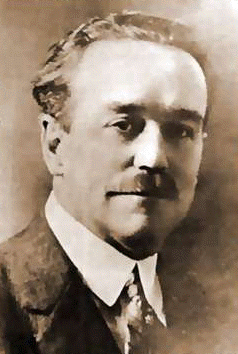 Charles Fox Parham, who associated glossolalia with the baptism in the Holy Spirit. 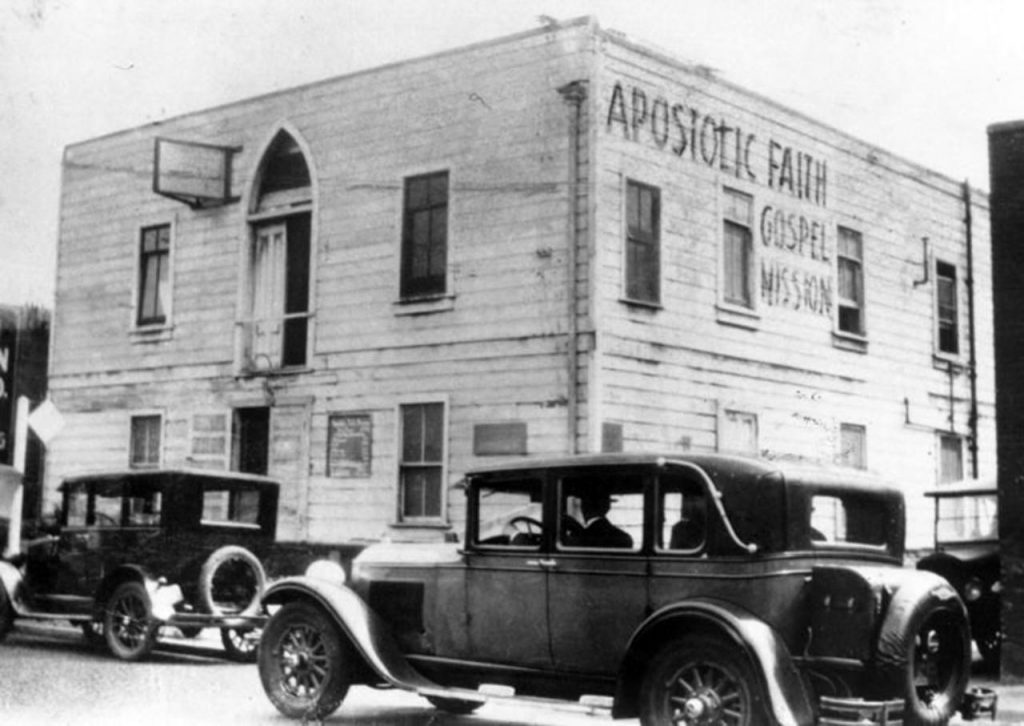 The Apostolic Faith Mission on Azusa Street, now considered to be the birthplace of Pentecostalism. Charles Fox Parham, an independent holiness evangelist who believed strongly in divine healing, was an important figure to the emergence of Pentecostalism as a distinct Christian movement. Parham, who was raised as a Methodist,[34] started a spiritual school near Topeka, Kansas in 1900, which he named Bethel Bible School. There he taught that speaking in tongues was the scriptural evidence for the reception of the baptism with the Holy Spirit. On January 1, 1901, after a watch night service, the students prayed for and received the baptism with the Holy Spirit with the evidence of speaking in tongues.[35] Parham received this same experience sometime later and began preaching it in all his services. Parham believed this was xenoglossia and that missionaries would no longer need to study foreign languages. Parham closed his Topeka school after 1901 and began a four-year revival tour throughout Kansas and Missouri.[36] He taught that the baptism with the Holy Spirit was a third experience, subsequent to conversion and sanctification. Sanctification cleansed the believer, but Spirit baptism empowered for service.[37] At about the same time that Parham was spreading his doctrine of initial evidence in the Midwestern United States, news of the Welsh Revival of 1904–1905 ignited intense speculation among radical evangelicals around the world and particularly in the US of a coming move of the Spirit which would renew the entire Christian Church. This revival saw thousands of conversions and also exhibited speaking in tongues.[38] Parham moved to Houston, Texas in 1905, where he started a Bible training school. One of his students was William J. Seymour, a one-eyed black preacher. Seymour traveled to Los Angeles where his preaching sparked the three-year-long Azusa Street Revival in 1906.[39] The revival first broke out on Monday April 9, 1906 at 214 Bonnie Brae Street and then moved to 312 Azusa Street on Friday, April 14, 1906.[40] Worship at the racially integrated Azusa Mission featured an absence of any order of service. People preached and testified as moved by the Spirit, spoke and sung in tongues, and fell (were slain) in the Spirit. The revival attracted both religious and secular media attention, and thousands of visitors flocked to the mission, carrying the "fire" back to their home churches.[41] Despite the work of various Wesleyan groups such as Parham's and D. L. Moody's revivals, the beginning of the widespread Pentecostal movement in the US is generally considered to have begun with Seymour's Azusa Street Revival.[42] |
初期の復興:1900年~1929年 チャールズ・フォックス・パーハムは、聖霊の洗礼と異言を関連付けた人物だ。  アズサ・ストリートのアポストル・フェイス・ミッションは、現在、ペンテコステ派の誕生地とされている。 チャールズ・フォックス・パーハムは、神の癒しを強く信じる独立系の聖潔伝道者で、ペンテコステ派が独自のキリスト教運動として台頭する上で重要な人物 だった。メソジスト派で育ったパーハムは、1900年にカンザス州トピカ近郊にベテル聖書学校と名付けた霊的学校を設立。そこで、舌で話すことが聖霊の洗 礼を受けた証拠だと教えた。1901年1月1日、徹夜礼拝の後、学生たちは祈り、舌で話すという証拠と共に聖霊のバプテスマを受けた[35]。パーハムも 後に同じ体験をし、全ての礼拝でこれを説教し始めた。パラムはこれをゼノグロッシア(異言現象)と信じ、宣教師は外国語を学ぶ必要がなくなると思った。パ ラムは1901年以降トペカの学校を閉鎖し、カンザス州とミズーリ州を回る4年間の復興巡回を開始した。[36] 彼は、聖霊のバプテスマは回心と聖化に続く第三の経験だと教えた。聖化は信者を清めるが、聖霊のバプテスマは奉仕のための力を与える。[37] パーハムが米国中西部で初期の証拠の教義を広めていた頃、1904年から1905年にかけてのウェールズリバイバルに関するニュースが、世界中の過激な福 音派、特に米国の福音派の間で、キリスト教教会全体を刷新する聖霊の働きが間もなく始まるという激しい憶測を巻き起こした。このリバイバルでは、何千人も の人々が改宗し、異言も発せられた。[38] 1905年、パーハムはテキサス州ヒューストンに移住し、聖書訓練学校を設立した。その生徒の一人に、片目の黒人牧師ウィリアム・J・シーモアがいた。 シーモアはロサンゼルスを訪れ、その説教がきっかけで1906年に3年間にわたるアズサ・ストリート・リバイバルが起こった。[39] 復興運動は1906年4月9日月曜日にボニー・ブレイ・ストリート214番地で始まり、1906年4月14日金曜日にアズサ・ストリート312番地に移っ た。[40] 民族的に統合されたアズサ・ミッションでの礼拝には、礼拝の順序が一切なかった。人々は御霊に動かされて説教し、証し、異言で話し、歌い、そして御霊に打 たれて倒れた。この復興運動は宗教界と世俗メディアの両方の注目を集め、数千人の訪問者がミッションに殺到し、その「火」を故郷の教会に持ち帰った。 [41] パラムやD.L.ムーディの復興運動を含むさまざまなウェスレー派の活動にもかかわらず、アメリカにおける広範なペンテコステ運動の始まりは、一般にセ ymourのアズサ・ストリート復興運動から始まったとされている。[42] |
 William Seymour, leader of the Azusa Street Revival The crowds of African-Americans and whites worshiping together at William Seymour's Azusa Street Mission set the tone for much of the early Pentecostal movement. During the period of 1906–1924, Pentecostals defied social, cultural and political norms of the time that called for racial segregation and the enactment of Jim Crow laws. The Church of God in Christ, the Church of God (Cleveland), the Pentecostal Holiness Church, and the Pentecostal Assemblies of the World were all interracial denominations before the 1920s. These groups, especially in the Jim Crow South were under great pressure to conform to segregation. Ultimately, North American Pentecostalism would divide into white and African-American branches. Though it never entirely disappeared, interracial worship within Pentecostalism would not reemerge as a widespread practice until after the civil rights movement.[43]  Women in a Pentecostal worship service Women were vital to the early Pentecostal movement.[44] Believing that whoever received the Pentecostal experience had the responsibility to use it towards the preparation for Christ's second coming, Pentecostal women held that the baptism in the Holy Spirit gave them empowerment and justification to engage in activities traditionally denied to them.[45][46] The first person at Parham's Bible college to receive Spirit baptism with the evidence of speaking in tongues was a woman, Agnes Ozman.[45][47][48] Women such as Florence Crawford, Ida Robinson, and Aimee Semple McPherson founded new denominations, and many women served as pastors, co-pastors, and missionaries.[49] Women wrote religious songs, edited Pentecostal papers, and taught and ran Bible schools.[50] The unconventionally intense and emotional environment generated in Pentecostal meetings dually promoted, and was itself created by, other forms of participation such as personal testimony and spontaneous prayer and singing. Women did not shy away from engaging in this forum, and in the early movement the majority of converts and church-goers were female.[51] Nevertheless, there was considerable ambiguity surrounding the role of women in the church. The subsiding of the early Pentecostal movement allowed a socially more conservative approach to women to settle in, and, as a result, female participation was channeled into more supportive and traditionally accepted roles. Auxiliary women's organizations were created to focus women's talents on more traditional activities. Women also became much more likely to be evangelists and missionaries than pastors. When they were pastors, they often co-pastored with their husbands.[52] The majority of early Pentecostal denominations taught Christian pacifism and adopted military service articles that advocated conscientious objection.[53] |
 ウィリアム・シーモア、アズサ・ストリート・リバイバルの指導者 ウィリアム・シーモアのアズサ・ストリート・ミッションで、アフリカ系アメリカ人と白人が一緒に礼拝する群衆は、初期のペンテコステ運動の多くに大きな影 響を与えた。1906年から1924年にかけて、ペンテコステ派は、人種隔離とジム・クロウ法の制定を求める当時の社会的、文化的、政治的規範に反対し た。キリストの教会(Church of God in Christ)、クリーブランド・ペンテコステ派(Church of God (Cleveland))、ペンテコステ派ホーリネス教会(Pentecostal Holiness Church)、世界ペンテコステ派集会(Pentecostal Assemblies of the World)は、1920年代以前にはすべて人種混合の教派だった。これらのグループは、特にジム・クロウ法下の南部で、分離に順応する大きな圧力を受け ていた。最終的に、北米のペンテコステ派は白人とアフリカ系アメリカ人の派閥に分裂した。完全に消滅したわけではないが、ペンテコステ派内での人種混合の 礼拝は、公民権運動以降まで広範な実践として再興しなかった。[43]  ペンテコステ派の礼拝に参加する女性たち 女性は、初期のペンテコステ派運動において重要な役割を果たした。[44] ペンテコステ派の女性は、ペンテコステの体験を受けた者は、キリストの再臨の準備のためにその体験を活用する責任があると信じ、聖霊の洗礼によって、従来 は禁じられていた活動に従事する権限と正当性が与えられたと主張した。[45][46] パーハムの聖書大学で、異言を話すという証拠とともに聖霊の洗礼を受けた最初の人は、アグネス・オズマンという女性だった。[45][47][48] フローレンス・クロフォード、アイダ・ロビンソン、エイミー・センプル・マクファーソンなどの女性たちが新しい宗派を設立し、多くの女性が牧師、副牧師、 宣教師として活躍した。[49] 女性は宗教的な歌を作曲し、ペンテコステ派の新聞を編集し、聖書学校を運営し、教鞭をとった。[50] ペンテコステ派の集会では、型にはまらない、強烈で感情的な雰囲気が生まれ、個人的な証言や自発的な祈りや歌などの他の参加形態も促進され、またそれ自体 がそのような雰囲気を作り出していた。女性はこのような場への参加をためらわず、初期の運動では改宗者や教会出席者の大多数が女性だった。[51] しかし、女性の教会における役割には大きな曖昧さが残っていた。初期のペンテコステ派運動の衰退により、女性に対する社会的に保守的な態度が定着し、その 結果、女性の参加は支援的かつ伝統的に受け入れられる役割に導かれた。女性の才能を伝統的な活動に集中させるため、補助的な女性団体が設立された。女性は 牧師よりも伝道者や宣教師になる可能性がはるかに高くなった。牧師となった場合、多くの場合、夫と共に共同牧師を務めた。[52] 初期のペンテコステ派の教派の多くは、キリスト教の平和主義を教え、良心的兵役拒否を主張する軍事サービス条項を採用していた。[53] |
| Spread and opposition Main article: Christianity in the modern era Further information: Christian population growth and Christianity by country Azusa participants returned to their homes carrying their new experience with them. In many cases, whole churches were converted to the Pentecostal faith, but many times Pentecostals were forced to establish new religious communities when their experience was rejected by the established churches. One of the first areas of involvement was the African continent, where, by 1907, American missionaries were established in Liberia, as well as in South Africa by 1908.[54] Because speaking in tongues was initially believed to always be actual foreign languages, it was believed that missionaries would no longer have to learn the languages of the peoples they evangelized because the Holy Spirit would provide whatever foreign language was required. (When the majority of missionaries, to their disappointment, learned that tongues speech was unintelligible on the mission field, Pentecostal leaders were forced to modify their understanding of tongues.)[55] Thus, as the experience of speaking in tongues spread, a sense of the immediacy of Christ's return took hold, and that energy would be directed into missionary and evangelistic activity. Early Pentecostals saw themselves as outsiders from mainstream society, dedicated solely to preparing the way for Christ's return.[45][56] An associate of Seymour's, Florence Crawford, brought the message to the Northwest, forming what would become the Apostolic Faith Church—a Holiness Pentecostal denomination—by 1908. After 1907, Azusa participant William Howard Durham, pastor of the North Avenue Mission in Chicago, returned to the Midwest to lay the groundwork for the movement in that region. It was from Durham's church that future leaders of the Pentecostal Assemblies of Canada would hear the Pentecostal message.[57] One of the most well known Pentecostal pioneers was Gaston B. Cashwell (the "Apostle of Pentecost" to the South), whose evangelistic work led three Southeastern holiness denominations into the new movement.[58] The Pentecostal movement, especially in its early stages, was typically associated with the impoverished and marginalized of America, especially African Americans and Southern Whites. With the help of many healing evangelists such as Oral Roberts, Pentecostalism spread across America by the 1950s.[59] |
広まりと反対 主な記事:現代におけるキリスト教 詳細情報:キリスト教徒の人口増加と国別キリスト教徒の人口 アズサの参加者は、新しい体験を持ち帰って故郷に戻った。多くの場合、教会全体がペンテコステ派に改宗したが、既存の教会によってその体験が拒絶されたた め、ペンテコステ派は新たな宗教共同体を設立せざるを得なかった。最初の活動地域の一つはアフリカ大陸で、1907年までにアメリカの宣教師たちがリベリ ア、1908年までに南アフリカに拠点を設立した。[54] 当初、異言は常に実際の外国語であると信じられていたため、宣教師たちは、聖霊が必要な外国語をすべて与えてくれるので、伝道する人々の言語を学ぶ必要は もはやないだろうと考えられていた。(しかし、宣教師の大多数が、舌で話すことが宣教地で理解不能であることに失望したため、ペンテコステ派の指導者は舌 の理解を修正せざるを得なくなった。)[55] こうして、舌で話す経験が広まるにつれ、キリストの再臨の迫り来る感覚が広まり、そのエネルギーは宣教活動と伝道活動に注がれるようになった。初期のペン テコステ派は、主流社会から離れた存在であり、キリストの再臨の準備に専念する者たちだと自覚していた。[45][56] シーモア氏の仲間であるフローレンス・クロフォードは、そのメッセージを北西部に持ち込み、1908年までに、ホーリネス・ペンテコステ派の教派である使 徒信仰教会を設立した。1907年以降、アズサの参加者であったウィリアム・ハワード・ダーラム(シカゴのノース・アベニュー・ミッションの牧師)は、中 西部に戻り、その地域での運動の基盤を築いた。カナダのペンテコステ派アセンブリーの将来の指導者たちは、ダーラムの教会でペンテコステ派のメッセージを 聴いた。ペンテコステ派の最も有名な先駆者の一人に、ガストン・B・キャッシュウェル(南部では「ペンテコステの使徒」と呼ばれていた)がいる。彼の伝道 活動により、南東部の 3 つのホーリネス派が新しい運動に加わった。[58] ペンテコステ派運動は、特にその初期段階では、アメリカの貧困層や社会から疎外された人々、特にアフリカ系アメリカ人や南部白人と関連付けられていまし た。オーラル・ロバーツなどの多くの癒しの伝道者の助けを借りて、ペンテコステ派は 1950 年代までにアメリカ全土に広まりました。[59] |
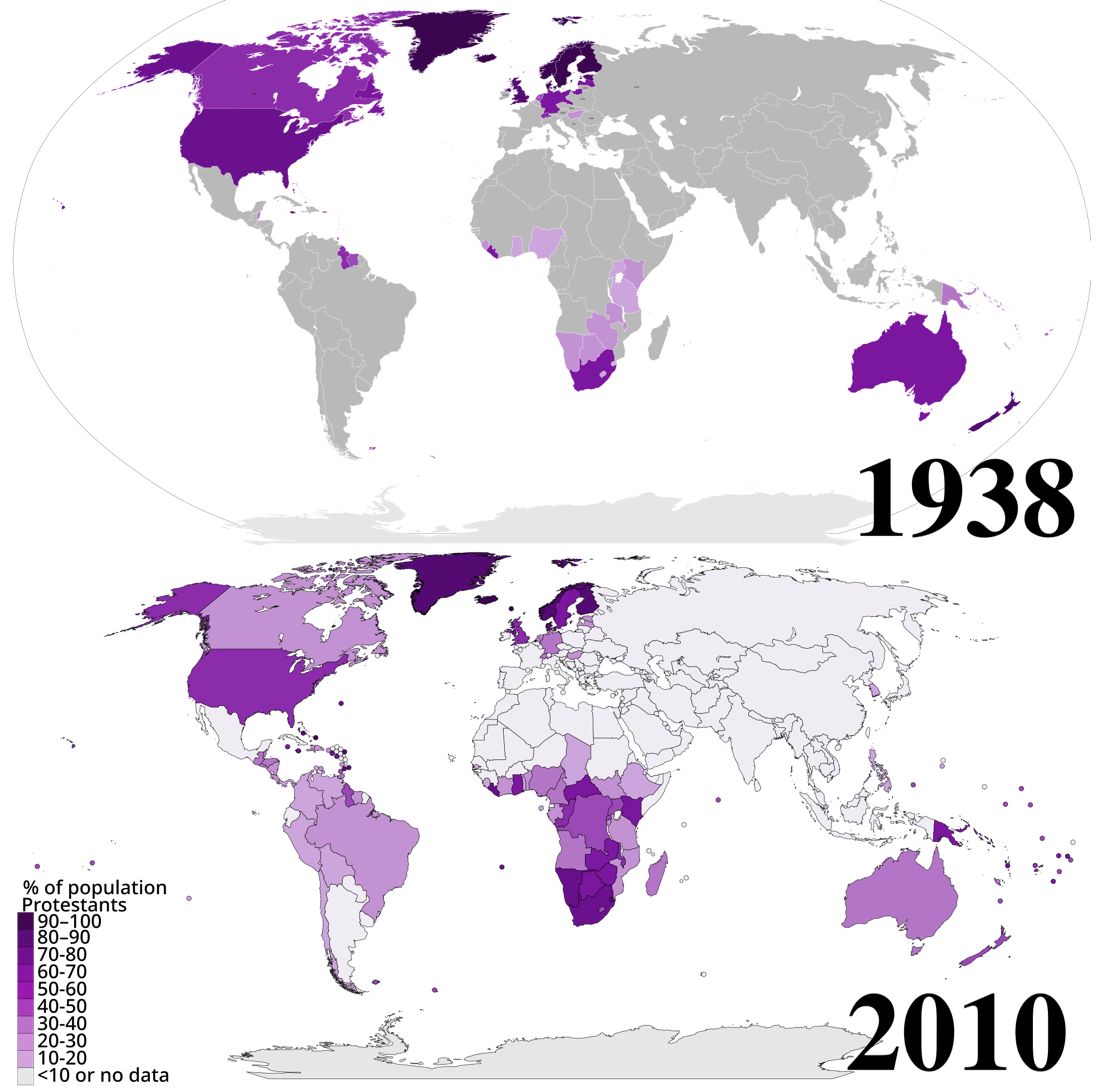 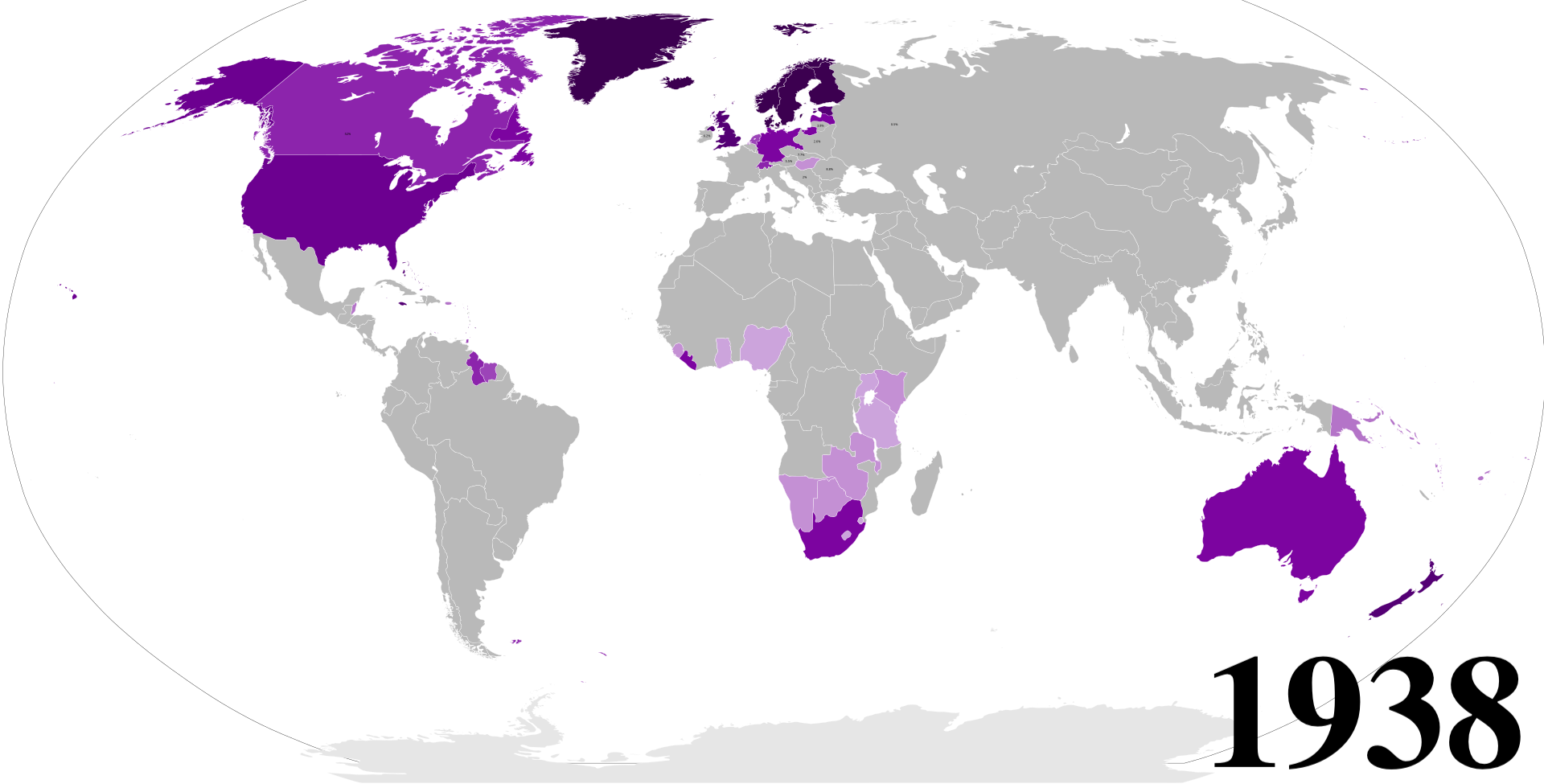 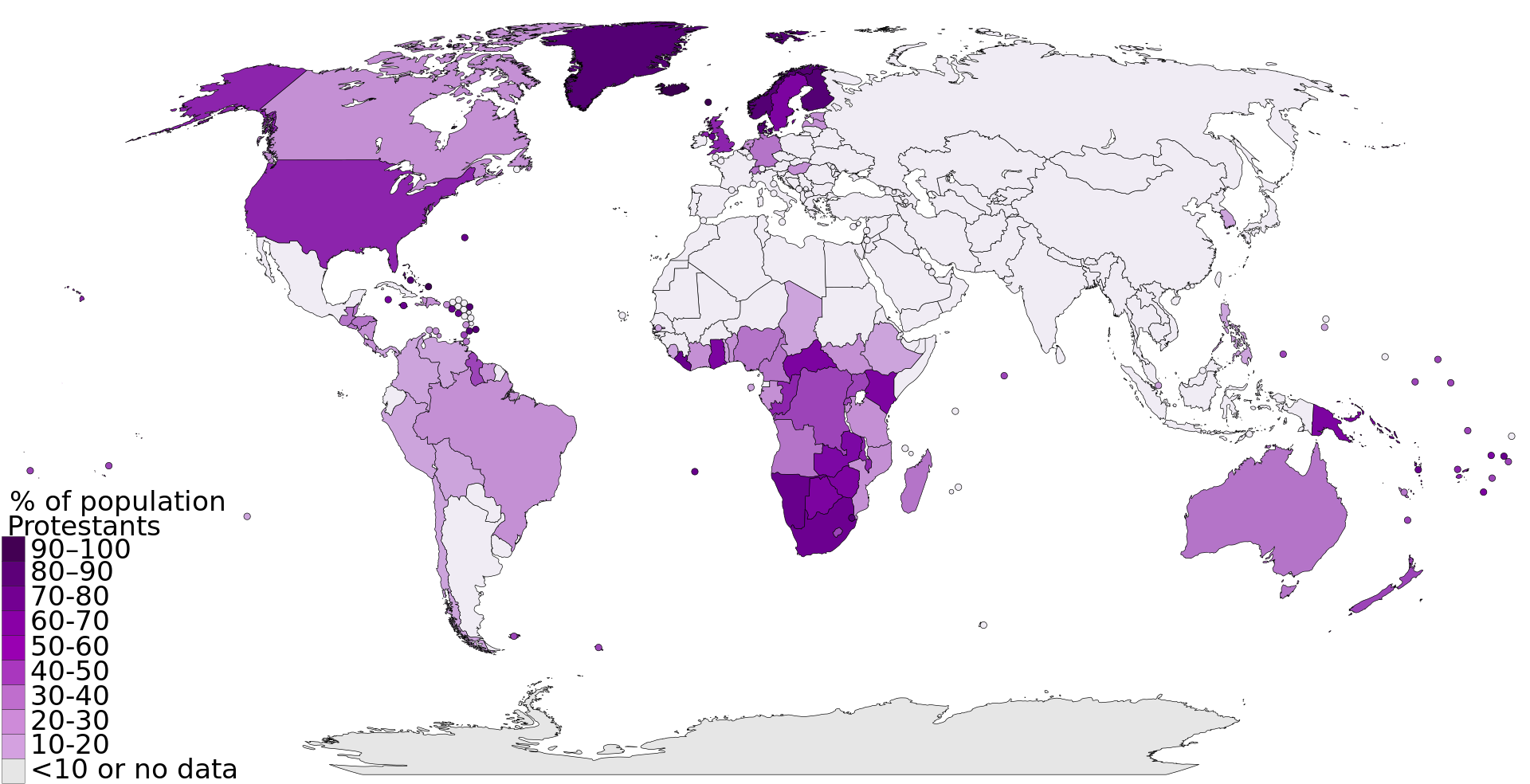 Countries by percentage of Protestant Christians in 1938 and 2010. Pentecostal and Evangelical denominations within Protestantism fueled much of the global growth of Christianity in Latin America, the Caribbean, Oceania, and Sub-Saharan Africa.[10][11][12][13][14] 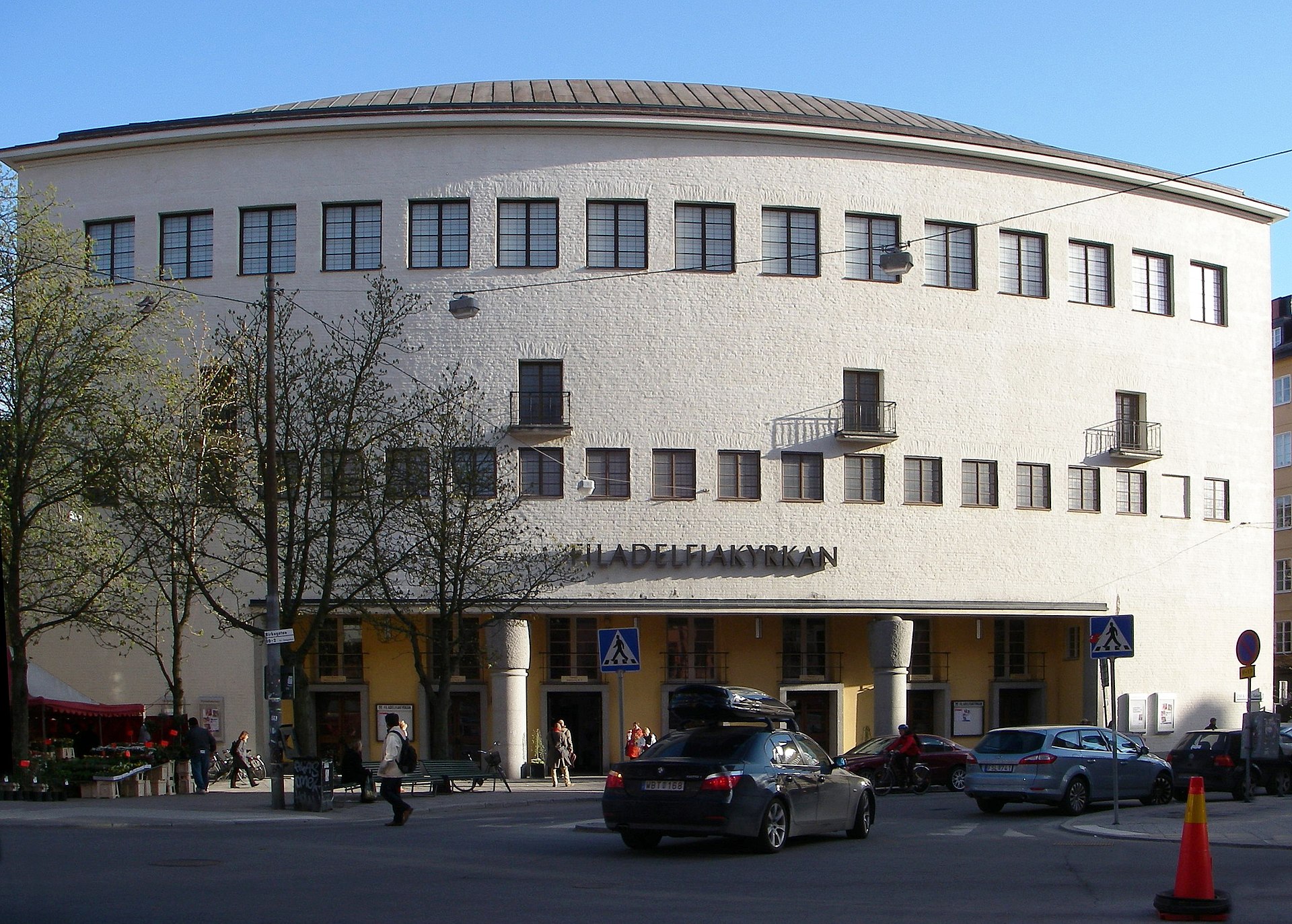 Filadelfiakyrkan ('the Philadelphia Church') in Stockholm, Sweden, is part of the Swedish Pentecostal Movement International visitors and Pentecostal missionaries would eventually export the revival to other nations. The first foreign Pentecostal missionaries were Alfred G. Garr and his wife, who were Spirit baptized at Azusa and traveled to India and later Hong Kong.[60] On being Spirit baptized, Garr spoke in Bengali, a language he did not know, and becoming convinced of his call to serve in India came to Calcutta with his wife Lilian and began ministering at the Bow Bazar Baptist Church.[61] The Norwegian Methodist pastor T. B. Barratt was influenced by Seymour during a tour of the United States. By December 1906, he had returned to Europe, and he is credited with beginning the Pentecostal movement in Sweden, Norway, Denmark, Germany, France and England.[62] A notable convert of Barratt was Alexander Boddy, the Anglican vicar of All Saints' in Sunderland, England, who became a founder of British Pentecostalism.[63] Other important converts of Barratt were German minister Jonathan Paul who founded the first German Pentecostal denomination (the Mülheim Association) and Lewi Pethrus, the Swedish Baptist minister who founded the Swedish Pentecostal movement.[64] Through Durham's ministry, Italian immigrant Luigi Francescon received the Pentecostal experience in 1907 and established Italian Pentecostal congregations in the US, Argentina (Christian Assembly in Argentina), and Brazil (Christian Congregation of Brazil). In 1908, Giacomo Lombardi led the first Pentecostal services in Italy.[65] In November 1910, two Swedish Pentecostal missionaries arrived in Belem, Brazil and established what would become the Assembleias de Deus (Assemblies of God of Brazil).[66] In 1908, John G. Lake, a follower of Alexander Dowie who had experienced Pentecostal Spirit baptism, traveled to South Africa and founded what would become the Apostolic Faith Mission of South Africa and the Zion Christian Church.[67] As a result of this missionary zeal, practically all Pentecostal denominations today trace their historical roots to the Azusa Street Revival.[68] Eventually, the first missionaries realized that they definitely needed to learn the local language and culture, needed to raise financial support, and develop long-term strategies for the development of indigenous churches.[69] The first generation of Pentecostal believers faced immense criticism and ostracism from other Christians, most vehemently from the Holiness movement from which they originated. Alma White, leader of the Pillar of Fire Church—a Holiness Methodist denomination, wrote a book against the movement titled Demons and Tongues in 1910. She called Pentecostal tongues "satanic gibberish" and Pentecostal services "the climax of demon worship".[70] Famous Holiness Methodist preacher W. B. Godbey characterized those at Azusa Street as "Satan's preachers, jugglers, necromancers, enchanters, magicians, and all sorts of mendicants". To Dr. G. Campbell Morgan, Pentecostalism was "the last vomit of Satan", while Dr. R. A. Torrey thought it was "emphatically not of God, and founded by a Sodomite".[71] The Pentecostal Church of the Nazarene, one of the largest holiness groups, was strongly opposed to the new Pentecostal movement. To avoid confusion, the church changed its name in 1919 to the Church of the Nazarene.[72] A. B. Simpson's Christian and Missionary Alliance—a Keswickian denomination—negotiated a compromise position unique for the time. Simpson believed that Pentecostal tongues speaking was a legitimate manifestation of the Holy Spirit, but he did not believe it was a necessary evidence of Spirit baptism. This view on speaking in tongues ultimately led to what became known as the "Alliance position" articulated by A. W. Tozer as "seek not—forbid not".[72] |
   1938年と2010年のプロテスタントキリスト教徒の割合による国別ランキング。プロテスタント内のペンテコステ派と福音派は、ラテンアメリカ、カリブ 海地域、オセアニア、サハラ以南のアフリカにおけるキリスト教の世界的な拡大を大きく後押しした。[10][11][12][13][14]  スウェーデンのストックホルムにあるフィラデルフィア教会(Filadelfiakyrkan)は、スウェーデンペンテコステ派運動の一部です。 海外からの訪問者やペンテコステ派の宣教師たちが、やがてこのリバイバルを他の国々にも広めていきました。最初の外国人ペンテコステ派宣教師は、アルフ レッド・G・ガーと彼の妻でした。彼らはアズサで聖霊のバプテスマを受け、インド、そして後に香港に渡りました。[60] 聖霊の洗礼を受けた後、ガーは知らない言語であるベンガル語で話し、インドで奉仕する召命に確信を持ち、妻のリリアンと共にカルカッタへ移り、ボウ・バ ザール・バプテスト教会で宣教を開始した。[61] ノルウェーのメソジスト派牧師T.B.バレットは、アメリカ合衆国を訪問中にセイモアに影響を受けた。1906年12月までに彼はヨーロッパに戻り、ス ウェーデン、ノルウェー、デンマーク、ドイツ、フランス、イギリスでペンテコステ運動を始めた人物として知られている。[62] バレットの注目すべき改宗者には、英国サザーランドにあるオールセインツ教会の英国国教会牧師であり、英国のペンテコステ派の創設者となったアレクサン ダー・ボディがいた。[63] バレットのその他の重要な改宗者には、最初のドイツのペンテコステ派(ミュールハイム協会)を設立したドイツの牧師ジョナサン・ポール、およびスウェーデ ンのペンテコステ派運動を設立したスウェーデンのバプテスト牧師ルウィ・ペトルスがいる。[64] ダーラムの宣教活動を通じて、イタリア移民のルイジ・フランチェスコンは 1907 年にペンテコステ派の体験をし、米国、アルゼンチン(アルゼンチンのキリスト教集会)、ブラジル(ブラジルのキリスト教集会)にイタリアのペンテコステ派 教会を設立した。1908 年、ジャコモ・ロンバルディがイタリアで最初のペンテコステ派の礼拝を導いた。[65] 1910年11月、2人のスウェーデンのペンテコステ派の宣教師がブラジルのベレンに到着し、後にアセンブレイアス・デ・デウス(ブラジル神召教会)とな る団体を設立した。[66] 1908年、ペンテコステ派の聖霊の洗礼を受けたアレクサンダー・ドウィの信奉者であったジョン・G・レイクは、南アフリカに渡り、後に南アフリカ使徒信 仰宣教団およびシオン・クリスチャン教会となる団体を設立した。[67] この宣教活動の結果、今日のペンテコステ派のほぼすべての宗派は、その歴史的ルーツをアズサ・ストリート・リバイバルに求めている。[68] 結局、最初の宣教師たちは、現地の言語と文化を習得し、財政的支援を集め、先住民教会を発展させるための長期的な戦略を立てる必要があると悟った。 [69] 最初の世代のペンテコステ派信者は、他のキリスト教徒、特に彼らが起源とするホーリネス運動から激しい批判と排斥を受けた。ホーリネス・メソジスト派の教 団である「ファイア・ピラー教会」のリーダー、アルマ・ホワイトは、1910年に『悪魔と言語』という反ペンテコステ派の書籍を出版した。彼女はペンテコ ステ派の言語を「悪魔の支離滅裂な言葉」と呼び、ペンテコステ派の礼拝を「悪魔崇拝の頂点」と非難した。[70] 有名なホーリネス・メソジストの説教者 W. B. ゴッドベイは、アズサ・ストリートの信者たちを「悪魔の説教者、雑技師、降霊師、魔術師、手品師、そしてあらゆる種類の托鉢僧」と表現した。G. キャンベル・モーガン博士は、ペンテコステ派を「サタンの最後の嘔吐物」と表現し、R. A. トーリー博士は「明らかに神のものではなく、ソドム人によって設立された」と批判した。[71]最大のホーリネス派団体の一つであるナザレのペンテコステ 教会は、新しいペンテコステ運動に強く反対した。混乱を避けるため、この教会は 1919 年に「ナザレ教会」に名称を変更した。[72] A. B. シンプソンのキリスト教宣教同盟(ケズウィック派)は、当時としてはユニークな妥協案を交渉した。シンプソンは、ペンテコステ派の異言は聖霊の正当な現れ であると信じていたが、それが聖霊のバプテスマの必要な証拠であるとは考えていなかった。この舌で話すことに関する見解は、最終的にA. W. トーザーが「求めず、禁じず」と表現した「同盟の立場」として知られるようになった。[72] |
| Early controversies The first Pentecostal converts were mainly derived from the Holiness movement and adhered to a Wesleyan understanding of entire sanctification as a definite, instantaneous experience and second work of grace.[6] Problems with this view arose when large numbers of converts entered the movement from non-Wesleyan backgrounds, especially from Baptist churches.[73] In 1910, William Durham of Chicago first articulated the Finished Work, a doctrine which located sanctification at the moment of salvation and held that after conversion the Christian would progressively grow in grace in a lifelong process.[74] This teaching polarized the Pentecostal movement into two factions: Holiness Pentecostalism and Finished Work Pentecostalism.[8] The Wesleyan doctrine was strongest in the Apostolic Faith Church, which views itself as being the successor of the Azusa Street Revival, as well as in the Calvary Holiness Association, Congregational Holiness Church, Church of God (Cleveland), Church of God in Christ, Free Gospel Church and the Pentecostal Holiness Church; these bodies are classed as Holiness Pentecostal denominations.[75] The Finished Work, however, would ultimately gain ascendancy among Pentecostals, in denominations such as the Assemblies of God, which was the first Finished Work Pentecostal denomination.[9] After 1911, most new Pentecostal denominations would adhere to Finished Work sanctification.[76] In 1914, a group of 300 predominately white Pentecostal ministers and laymen from all regions of the United States gathered in Hot Springs, Arkansas, to create a new, national Pentecostal fellowship—the General Council of the Assemblies of God.[77] By 1911, many of these white ministers were distancing themselves from an existing arrangement under an African-American leader. Many of these white ministers were licensed by the African-American, C. H. Mason under the auspices of the Church of God in Christ, one of the few legally chartered Pentecostal organizations at the time credentialing and licensing ordained Pentecostal clergy. To further such distance, Bishop Mason and other African-American Pentecostal leaders were not invited to the initial 1914 fellowship of Pentecostal ministers. These predominately white ministers adopted a congregational polity, whereas the COGIC and other Southern groups remained largely episcopal and rejected a Finished Work understanding of Sanctification. Thus, the creation of the Assemblies of God marked an official end of Pentecostal doctrinal unity and racial integration.[78] Among these Finished Work Pentecostals, the new Assemblies of God would soon face a "new issue" which first emerged at a 1913 camp meeting. During a baptism service, the speaker, R. E. McAlister, mentioned that the Apostles baptized converts once in the name of Jesus Christ, and the words "Father, Son, and Holy Ghost" were never used in baptism.[79] This inspired Frank Ewart who claimed to have received as a divine prophecy revealing a nontrinitarian conception of God.[80] Ewart believed that there was only one personality in the Godhead—Jesus Christ. The terms "Father" and "Holy Ghost" were titles designating different aspects of Christ. Those who had been baptized in the Trinitarian fashion needed to submit to rebaptism in Jesus's name. Furthermore, Ewart believed that Jesus's name baptism and the gift of tongues were essential for salvation. Ewart and those who adopted his belief, which is known as Oneness Pentecostalism, called themselves "oneness" or "Jesus's Name" Pentecostals, but their opponents called them "Jesus Only".[81][8] Amid great controversy, the Assemblies of God rejected the Oneness teaching, and many of its churches and pastors were forced to withdraw from the denomination in 1916.[82] They organized their own Oneness groups. Most of these joined Garfield T. Haywood, an African-American preacher from Indianapolis, to form the Pentecostal Assemblies of the World. This church maintained an interracial identity until 1924 when the white ministers withdrew to form the Pentecostal Church, Incorporated. This church later merged with another group forming the United Pentecostal Church International.[83] This controversy among the Finished Work Pentecostals caused Holiness Pentecostals to further distance themselves from Finished Work Pentecostals, who they viewed as heretical.[8] |
初期の論争 最初のペンテコステ派の改宗者は主にホーリネス運動から派生し、完全な聖化とは明確な瞬間的な体験であり、恵みの第二の働きであるとするウェスレーの理解 を支持していた。[6] この見解に対する問題は、ウェスレー派以外の背景、特にバプテスト教会から多くの改宗者がこの運動に参加したときに生じた。[73] 1910年、シカゴのウィリアム・ダーハムは「完了した業」という教義を初めて明確に述べた。この教義は、聖化を救いの瞬間に位置付け、改宗後、キリスト 教徒は生涯にわたるプロセスで恵みの中で徐々に成長すると主張した。[74] この教義はペンテコステ派運動を二つの派閥に分裂させた:ホーリネス・ペンテコステ派と完了した業ペンテコステ派。[8] ウェスレー派の教義は、アズサ・ストリート・リバイバルの継承者と自認するアポストロリック・フェイス・チャーチ、およびカルバリー・ホーリネス・アソシ エーション、コンゴゲーション・ホーリネス・チャーチ、チャーチ・オブ・ゴッド(クリーブランド)、チャーチ・オブ・ゴッド・イン・クライスト、フリー・ ゴスペル・チャーチ、ペンテコステ・ホーリネス・チャーチなどに最も強く根付いていた。これらの団体はホーリネス・ペンテコステ派の教派に分類される。 [75] しかし、完成の業は最終的にペンテコステ派の中で優位を占め、アッセンブリーズ・オブ・ゴッド(最初の完成の業ペンテコステ派教派)などの教派で採用され た。[9] 1911年以降、新たなペンテコステ派教派のほとんどは完成の業の聖化を支持するようになった。[76] 1914年、米国各地から300人の主に白人のペンテコステ派の牧師や信徒たちが、アーカンソー州ホットスプリングスに集まり、新しい全国的なペンテコス テ派の団体、神のアセンブリーズ総会議(General Council of the Assemblies of God)を設立した。[77] 1911年までに、これらの白人牧師たちの多くは、アフリカ系アメリカ人の指導者のもとでの既存の体制から距離を置くようになっていた。これらの白人牧師 の多くは、当時、ペンテコステ派の聖職者を認証・免許する数少ない合法的に認可されたペンテコステ派組織の一つである「キリストの教会」の傘下で、アフリ カ系アメリカ人のC.H.メイソンによって免許を受けていた。このような距離をさらに広げるため、メイソン主教を含むアフリカ系アメリカ人のペンテコステ 派指導者は、1914年の最初のペンテコステ派牧師の連合に招待されなかった。これらの主に白人牧師は会衆制を採用したのに対し、COGIC(キリスト教 神殿教会)を含む南部のグループは主に主教制を維持し、聖化に関する「完了した業」の理解を拒否した。 thus、アッセンブリーズ・オブ・ゴッドの設立は、ペンテコステ派の教義的統一と人種的統合の公式な終結を意味した。[78] これらの「完成した業」ペンテコステ派の中で、新しいアッセンブリーズ・オブ・ゴッドは、1913年のキャンプ集会で初めて浮上した「新たな問題」に直面 することになった。洗礼式の中で、講演者の R. E. マカリスターは、使徒たちは改宗者にイエス・キリストの名によって一度だけ洗礼を施し、「父、子、聖霊」という言葉は洗礼では決して使用されなかったと述 べた。[79] これは、三位一体説ではない神の概念を明らかにする神の予言を受けたと主張するフランク・エワートに影響を与えた。[80] エワートは、神にはイエス・キリストという唯一の人格しか存在しないと信じていた。「父」と「聖霊」という用語は、キリストの異なる側面を表す称号にすぎ ない。三位一体説に従って洗礼を受けた者は、イエスの名によって再洗礼を受ける必要があった。さらに、エワートは、イエスの名による洗礼と舌の賜物が救い にとって不可欠であると信じていた。エワートとその教えを採用した人々は、オネネス・ペンテコステリズムと呼ばれ、自身を「オネネス」または「イエスの 名」ペンテコステ派と称したが、反対派は彼らを「イエス・オンリー」と呼んだ。[81][8] 大きな論争の中で、神のアセンブリは「唯一神教」の教えを拒否し、その多くの教会と牧師たちは 1916 年に教団から脱退を余儀なくされた。[82] 彼らは独自の「唯一神教」の団体を結成した。そのほとんどは、インディアナポリスのアフリカ系アメリカ人牧師、ガーフィールド・T・ヘイウッドに加わり、 「世界ペンテコステ派アセンブリ」を結成した。この教会は1924年に白人牧師たちが離脱してペンテコステ教会(株式会社)を設立するまで、人種混合のア イデンティティを維持した。この教会は後に別のグループと合併し、国際ペンテコステ教会を設立した。[83] フィニッシュド・ワーク・ペンテコステ派内のこの論争は、彼らを異端と見なすホーリネス・ペンテコステ派がフィニッシュド・ワーク・ペンテコステ派からさ らに距離を置く原因となった。[8] |
1930–1959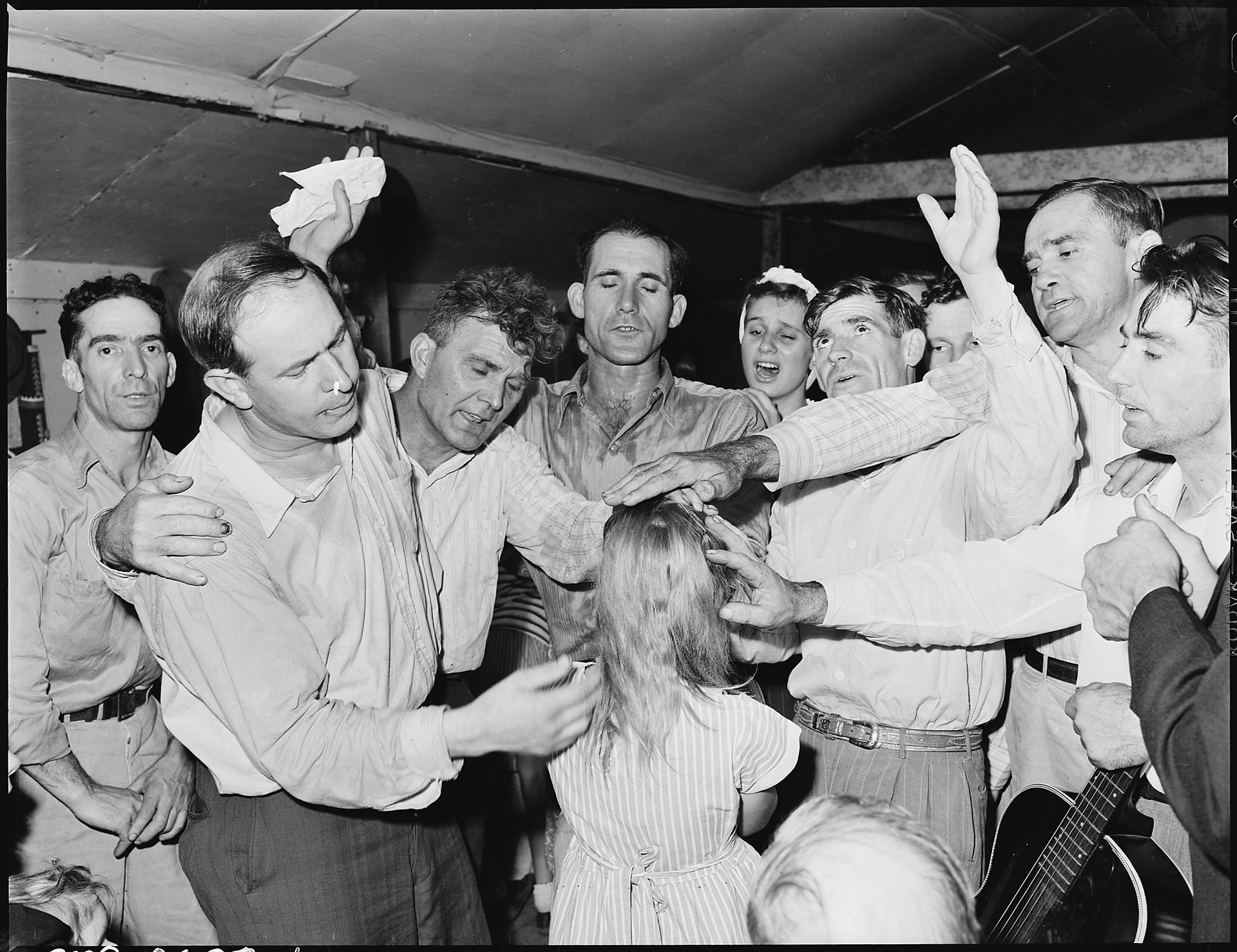 Members of the Pentecostal Church of God in Lejunior, Kentucky pray for a girl in 1946 While Pentecostals shared many basic assumptions with conservative Protestants, the earliest Pentecostals were rejected by Fundamentalist Christians who adhered to cessationism. In 1928, the World Christian Fundamentals Association labeled Pentecostalism "fanatical" and "unscriptural". By the early 1940s, this rejection of Pentecostals was giving way to a new cooperation between them and leaders of the "new evangelicalism", and American Pentecostals were involved in the founding of the 1942 National Association of Evangelicals.[84] Pentecostal denominations also began to interact with each other both on national levels and international levels through the Pentecostal World Fellowship, which was founded in 1947. Though Pentecostals began to find acceptance among evangelicals in the 1940s, the previous decade was widely viewed as a time of spiritual dryness, when healings and other miraculous phenomena were perceived as being less prevalent than in earlier decades of the movement.[85] It was in this environment that the Latter Rain Movement, the most important controversy to affect Pentecostalism since World War II, began in North America and spread around the world in the late 1940s. Latter Rain leaders taught the restoration of the fivefold ministry led by apostles. These apostles were believed capable of imparting spiritual gifts through the laying on of hands.[86] There were prominent participants of the early Pentecostal revivals, such as Stanley Frodsham and Lewi Pethrus, who endorsed the movement citing similarities to early Pentecostalism.[85] However, Pentecostal denominations were critical of the movement and condemned many of its practices as unscriptural. One reason for the conflict with the denominations was the sectarianism of Latter Rain adherents.[86] Many autonomous churches were birthed out of the revival.[85] A simultaneous development within Pentecostalism was the postwar Healing Revival. Led by healing evangelists William Branham, Oral Roberts, Gordon Lindsay, and T. L. Osborn, the Healing Revival developed a following among non-Pentecostals as well as Pentecostals. Many of these non-Pentecostals were baptized in the Holy Spirit through these ministries. The Latter Rain and the Healing Revival influenced many leaders of the charismatic movement of the 1960s and 1970s.[87] |
1930年~1959年 1946年、ケンタッキー州レジュニアーにあるペンテコステ派の教会で、教会員たちが少女のために祈っている様子。 ペンテコステ派は保守的なプロテスタントと多くの基本的な考え方を共有していましたが、初期のペンテコステ派は、聖霊の賜物の停止を信奉する原理主義キリ スト教徒たちから拒絶されていました。1928年、世界キリスト教原理主義者協会は、ペンテコステ派を「狂信的」かつ「非聖書的」と非難しました。 1940年代初頭までに、ペンテコステ派に対するこの拒絶は、彼らと「新しい福音主義」の指導者たちとの新たな協力関係に取って代わられ、アメリカのペン テコステ派は1942年の全米福音協会(National Association of Evangelicals)の設立に関わった。[84] ペンテコステ派の宗派も、1947年に設立されたペンテコステ世界フェローシップ(Pentecostal World Fellowship)を通じて、国内レベルおよび国際レベルの両方で相互交流を開始した。 1940年代、ペンテコステ派は福音派の間で受け入れられ始めたが、その前の10年間は、癒やしやその他の奇跡的な現象が、運動の初期の数十年よりもあま り見られなくなった、霊的に乾燥した時代と広く見なされていた。[85] このような背景の中、第二次世界大戦後ペンテコステ派に最も大きな影響を与えた論争である「レイター・レイン運動」が北米で始まり、1940年代後半に世 界中に広がった。レイター・レインの指導者たちは、使徒によって率いられる五重の奉仕の回復を教えた。これらの使徒は、手置きの儀式を通じて霊的賜物を授 ける能力があると信じられていた。[86] 初期のペンテコステ派の復興運動に参加した著名な人物には、スタンリー・フロッシュアムやレウィ・ペトゥルスなどがおり、彼らはこの運動を初期のペンテコ ステ派との類似性を理由に支持した。[85] しかし、ペンテコステ派の教派は、この運動を批判し、その多くの実践を聖書に反するものとして非難した。宗派間の対立の原因のひとつは、後雨信奉者の宗派 主義だった。[86] このリバイバルから、多くの自治教会が誕生した。[85] ペンテコステ派内で同時に起こった動きは、戦後のヒーリング・リバイバルだった。癒しの伝道者ウィリアム・ブランハム、オーラル・ロバーツ、ゴードン・リ ンゼイ、T. L. オズボーンが主導した癒しのリバイバルは、ペンテコステ派だけでなく、非ペンテコステ派の間でも支持者を増やした。これらの非ペンテコステ派の多くは、こ れらのミニストリーを通じて聖霊の洗礼を受けた。後雨と癒しのリバイバルは、1960年代と1970年代のカリスマ運動の多くの指導者に影響を与えた。 [87] |
1960–present Dmanisi Pentecostal Church in Georgia 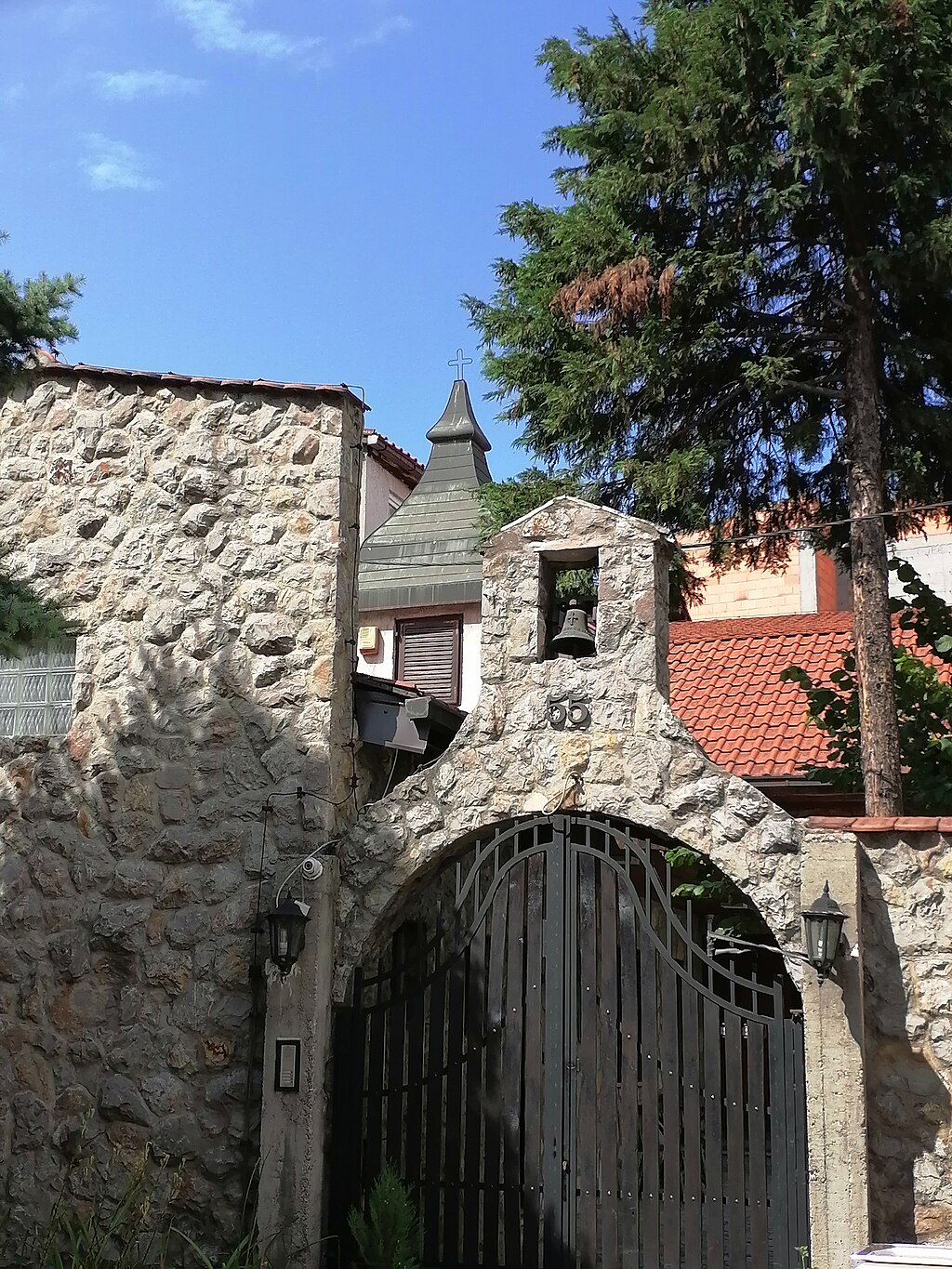 Pentecostal Church in Belgrade, Serbia Before the 1960s, most non-Pentecostal Christians who experienced the Pentecostal baptism in the Holy Spirit typically kept their experience a private matter or joined a Pentecostal church afterward.[88] The 1960s saw a new pattern develop where large numbers of Spirit baptized Christians from mainline churches in the US, Europe, and other parts of the world chose to remain and work for spiritual renewal within their traditional churches. This initially became known as New or Neo-Pentecostalism (in contrast to the older classical Pentecostalism) but eventually became known as the Charismatic Movement.[89] While cautiously supportive of the Charismatic Movement, the failure of Charismatics to embrace traditional Pentecostal teachings, such as the prohibition of dancing, abstinence from alcohol and other drugs such as tobacco, as well as restrictions on dress and appearance following the doctrine of outward holiness, initiated an identity crisis for classical Pentecostals, who were forced to reexamine long held assumptions about what it meant to be Spirit filled.[90][91] The liberalizing influence of the Charismatic Movement on classical Pentecostalism can be seen in the disappearance of many of these taboos since the 1960s, apart from certain Holiness Pentecostal denominations, such as the Apostolic Faith Church, which maintain these standards of outward holiness. Because of this, the cultural differences between classical Pentecostals and charismatics have lessened over time.[92] The global renewal movements manifest many of these tensions as inherent characteristics of Pentecostalism and as representative of the character of global Christianity.[93] |
1960年~現在 ジョージアのドマニシ・ペンテコステ教会  セルビアのベオグラードのペンテコステ教会 1960年代以前は、聖霊のバプテスマを受けた非ペンテコステ派のキリスト教徒の多くは、その経験を秘密にしたり、その後ペンテコステ教会に入会したりし ていました。[88] 1960年代には、米国、ヨーロッパ、および世界の他の地域における主流の教会から、聖霊の洗礼を受けた多くのキリスト教徒が、伝統的な教会内に留まり、 霊的な刷新のために働くという新しいパターンが現れた。これは当初、新しいペンテコステ派または新ペンテコステ派(従来の古典的なペンテコステ派とは対照 的)として知られていたが、最終的にはカリスマ運動として知られるようになった。[89] チャリズマティック運動に対して慎重な支持を示した古典的ペンテコステ派は、チャリズマティック派が伝統的なペンテコステ派の教義(ダンスの禁止、アル コールやタバコを含む薬物の禁酒・禁断、外見の清浄さを求める教義に基づく服装や外見の制限など)を受け入れなかったため、アイデンティティ危機に直面し た。これにより、古典的ペンテコステ派は、聖霊に満たされることの意味について長年抱いてきた前提を再考せざるを得なくなった。[90][91] 1960年代以降、外見の聖さを重視する特定の聖霊ペンテコステ派(使徒信仰教会など)を除いて、これらのタブーの多くが消滅したことから、カリスマ運動 が古典的なペンテコステ派に与えた自由化の影響が見られます。このため、古典的なペンテコステ派とカリスマ派の文化的な違いは、時間の経過とともに縮小し ています。[92] グローバルな刷新運動は、これらの緊張をペンテコステ派の固有の特徴として、またグローバルなキリスト教の特性を代表するものとして表している。[93] |
Beliefs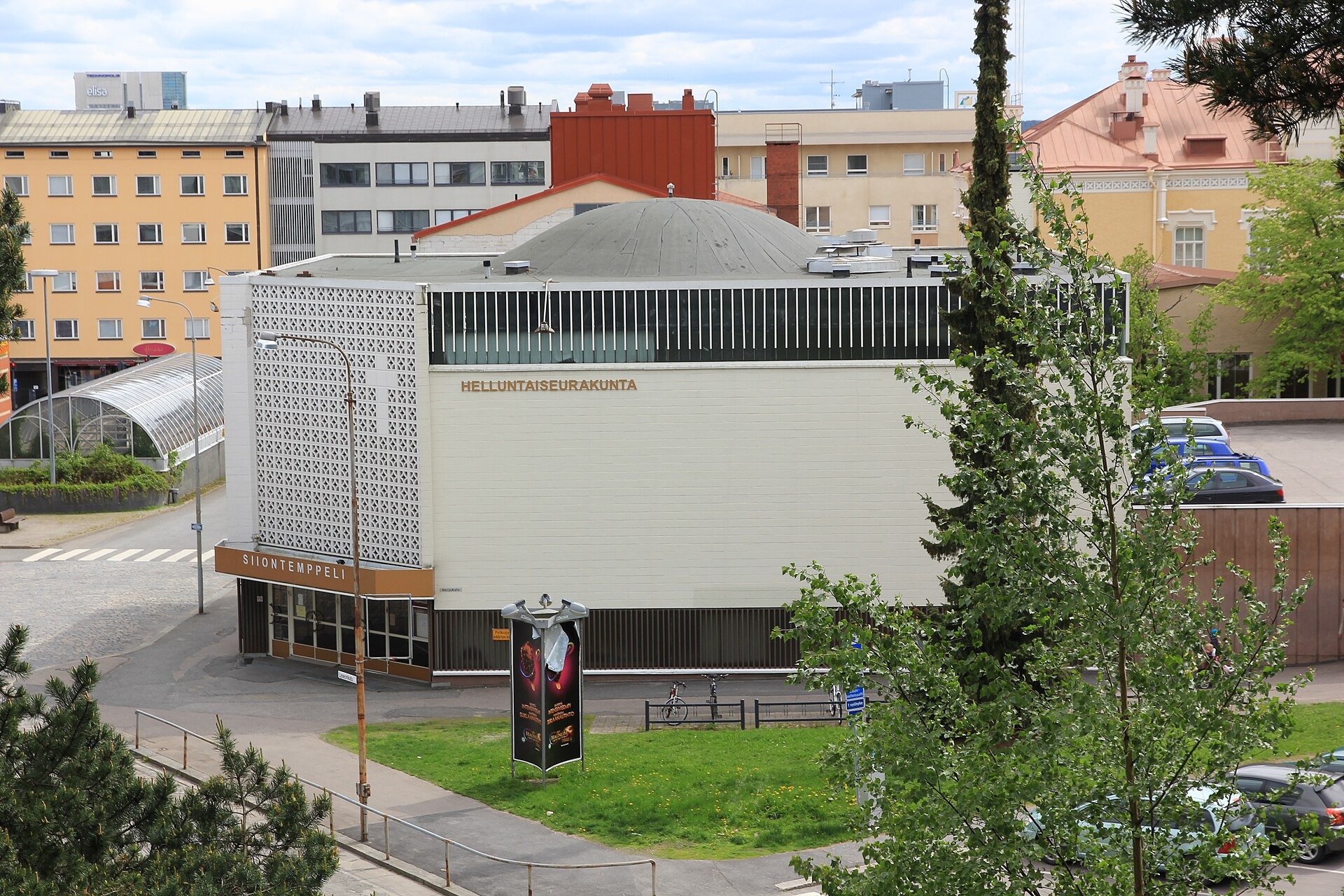 A Pentecostal church in Jyväskylä, Finland Pentecostalism is an evangelical faith, emphasizing the reliability of the Bible and the need for the transformation of an individual's life through faith in Jesus.[31] Like other evangelicals, Pentecostals generally adhere to the Bible's divine inspiration and inerrancy—the belief that the Bible, in the original manuscripts in which it was written, is without error.[94] Pentecostals emphasize the teaching of the "full gospel" or "foursquare gospel". The term foursquare refers to the four fundamental beliefs of Pentecostalism: Jesus saves according to John 3:16; baptizes with the Holy Spirit according to Acts 2:4; heals bodily according to James 5:15; and is coming again to receive those who are saved according to 1 Thessalonians 4:16–17.[95] Salvation 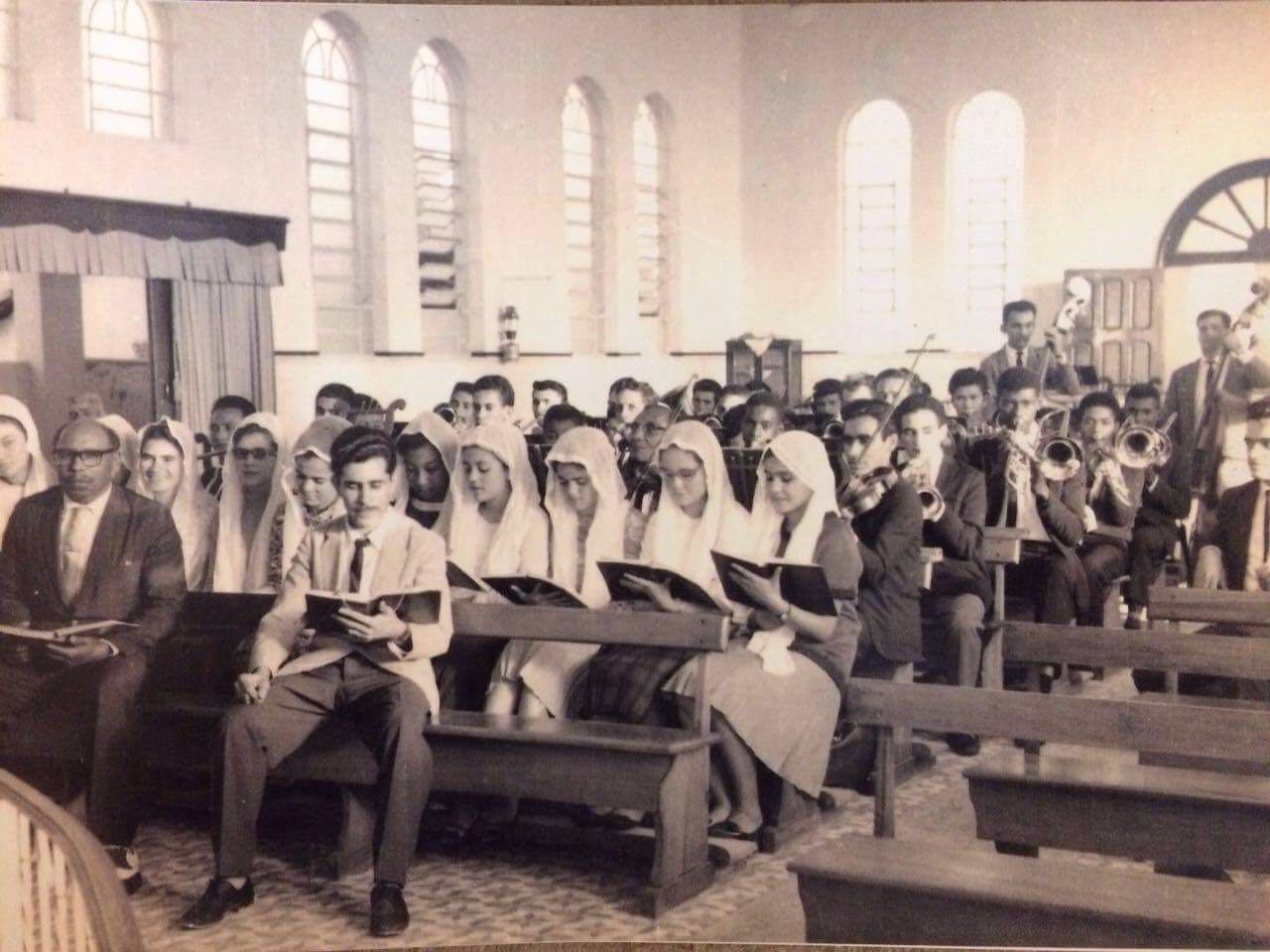 Pentecostal worshippers belonging to the Christian Congregation in Brazil, with women wearing modest dress and headcoverings Main article: Christian soteriology The central belief of classical Pentecostalism is that through the death, burial, and resurrection of Jesus Christ, sins can be forgiven and humanity reconciled with God.[96] This is the Gospel or "good news". The fundamental requirement of Pentecostalism is that one be born again.[97] The new birth is received by the grace of God through faith in Christ as Lord and Savior.[98] In being born again, the believer is regenerated, justified, adopted into the family of God, and the Holy Spirit's work of sanctification is initiated.[99] Classical Pentecostal soteriology is generally Arminian rather than Calvinist.[100] The security of the believer is a doctrine held within Pentecostalism; nevertheless, this security is conditional upon continual faith and repentance.[101] Pentecostals believe in both a literal heaven and hell, the former for those who have accepted God's gift of salvation and the latter for those who have rejected it.[102] For most Pentecostals there is no other requirement to receive salvation. Baptism with the Holy Spirit and speaking in tongues are not generally required, though Pentecostal converts are usually encouraged to seek these experiences.[103][104][105] A notable exception is Jesus's Name Pentecostalism, most adherents of which believe both water baptism and Spirit baptism are integral components of salvation. |
信仰 フィンランド、ユヴァスキュラにあるペンテコステ派教会 ペンテコステ派は、聖書の信頼性と、イエスへの信仰による個人の人生の変化の必要性を強調する福音主義の信仰です。[31] 他の福音派同様、ペンテコステ派は一般的に聖書の神聖な啓示と無謬性を信奉しています——つまり、聖書が書かれた原典において誤りがないという信念です。 [94] ペンテコステ派は「完全な福音」または「四角い福音」の教えを強調しています。「フォースクエア」という用語は、ペンテコステ派の4つの基本的な信仰を指 す:ヨハネ3:16に従ってイエスが救う;使徒2:4に従って聖霊で洗礼を施す;ヤコブ5:15に従って肉体的に癒す;そして1テサロニケ4:16–17 に従って救われた者を迎えに来る。[95] 救い  ブラジルのキリスト教会に所属するペンテコステ派の礼拝者たち。女性は控えめな服装と頭巾を着用している。 主な記事:キリスト教の救い論 古典的なペンテコステ派の中心的な信念は、イエス・キリストの死、埋葬、そして復活によって、罪は赦され、人類は神と和解することができるというものであ る。[96] これが福音、すなわち「良き知らせ」である。ペンテコステ派の根本的な要件は、人が生まれ変わることであり[97]、この新しい誕生は、キリストを主と救 い主として信じる信仰を通じて神の恵みによって与えられる[98]。生まれ変わることで、信者は再生され、義とされ、神の家族に採用され、聖霊の聖化の仕 事が開始される。[99] 古典的なペンテコステ派の救済論は、カルヴァン主義よりもアルミニウス主義に近いです。[100] 信者の安全はペンテコステ派の教義ですが、この安全は継続的な信仰と悔い改めに条件付けられています。[101] ペンテコステ派は、文字通りの天国と地獄の両方を信じています。前者は神の救いの贈り物を受け入れた者たちのためのものであり、後者はそれを拒絶した者た ちのためのものです。[102] ほとんどのペンテコステ派にとって、救いを受けるための他の要件はない。聖霊のバプテスマと異言は一般的に必要とされないが、ペンテコステ派の改宗者は通 常、これらの体験を求めるよう奨励されている。[103][104][105] 顕著な例外は、イエスの名によるペンテコステ派で、その信者の多くは、水によるバプテスマと聖霊のバプテスマの両方が救いの不可欠な要素であると信じてい る。 |
| Baptism with the Holy Spirit Main article: Baptism with the Holy Spirit Pentecostals identify three distinct uses of the word "baptism" in the New Testament: Baptism into the body of Christ: This refers to salvation. Every believer in Christ is made a part of his body, the Church, through baptism. The Holy Spirit is the agent, and the body of Christ is the medium.[106] Water baptism: Symbolic of dying to the world and living in Christ, water baptism is an outward symbolic expression of that which has already been accomplished by the Holy Spirit, namely baptism into the body of Christ.[107] Baptism with the Holy Spirit: This is an experience distinct from baptism into the body of Christ. In this baptism, Christ is the agent and the Holy Spirit is the medium.[106] While the figure of Jesus Christ and his redemptive work are at the center of Pentecostal theology, that redemptive work is believed to provide for a fullness of the Holy Spirit of which believers in Christ may take advantage.[108] The majority of Pentecostals believe that at the moment a person is born again, the new believer has the presence (indwelling) of the Holy Spirit.[104] While the Spirit dwells in every Christian, Pentecostals believe that all Christians should seek to be filled with him. The Spirit's "filling", "falling upon", "coming upon", or being "poured out upon" believers is called the baptism with the Holy Spirit.[109] Pentecostals define it as a definite experience occurring after salvation whereby the Holy Spirit comes upon the believer to anoint and empower them for special service.[110][111] It has also been described as "a baptism into the love of God".[112] The main purpose of the experience is to grant power for Christian service. Other purposes include power for spiritual warfare (the Christian struggles against spiritual enemies and thus requires spiritual power), power for overflow (the believer's experience of the presence and power of God in their life flows out into the lives of others), and power for ability (to follow divine direction, to face persecution, to exercise spiritual gifts for the edification of the church, etc.).[113] Pentecostals believe that the baptism with the Holy Spirit is available to all Christians.[114] Repentance from sin and being born again are fundamental requirements to receive it. There must also be in the believer a deep conviction of needing more of God in their life, and a measure of consecration by which the believer yields themself to the will of God. Citing instances in the Book of Acts where believers were Spirit baptized before they were baptized with water, most Pentecostals believe a Christian need not have been baptized in water to receive Spirit baptism. However, Pentecostals do believe that the biblical pattern is "repentance, regeneration, water baptism, and then the baptism with the Holy Ghost". There are Pentecostal believers who have claimed to receive their baptism with the Holy Spirit while being water baptized.[115] It is received by having faith in God's promise to fill the believer and in yielding the entire being to Christ.[116] Certain conditions, if present in a believer's life, could cause delay in receiving Spirit baptism, such as "weak faith, unholy living, imperfect consecration, and egocentric motives".[117] In the absence of these, Pentecostals teach that seekers should maintain a persistent faith in the knowledge that God will fulfill his promise. For Pentecostals, there is no prescribed manner in which a believer will be filled with the Spirit. It could be expected or unexpected, during public or private prayer.[118] Pentecostals expect certain results following baptism with the Holy Spirit. Some of these are immediate while others are enduring or permanent. Most Pentecostal denominations teach that speaking in tongues is an immediate or initial physical evidence that one has received the experience.[119] Some teach that any of the gifts of the Spirit can be evidence of having received Spirit baptism.[120] Other immediate evidences include giving God praise, having joy, and desiring to testify about Jesus.[119] Enduring or permanent results in the believer's life include Christ glorified and revealed in a greater way, a "deeper passion for souls", greater power to witness to nonbelievers, a more effective prayer life, greater love for and insight into the Bible, and the manifestation of the gifts of the Spirit.[121] Holiness Pentecostals, with their background in the Wesleyan-Holiness movement, historically teach that baptism with the Holy Spirit, as evidenced by glossolalia, is the third work of grace, which follows the new birth (first work of grace) and entire sanctification (second work of grace).[6][7][8] While the baptism with the Holy Spirit is a definite experience in a believer's life, Pentecostals view it as just the beginning of living a Spirit-filled life. Pentecostal teaching stresses the importance of continually being filled with the Spirit. There is only one baptism with the Spirit, but there should be many infillings with the Spirit throughout the believer's life.[122] |
聖霊のバプテスマ 主な記事:聖霊のバプテスマ ペンテコステ派は、新約聖書における「バプテスマ」という言葉の 3 つの異なる用法を識別している。 キリストの体へのバプテスマ:これは救いを指す。キリストを信じる者は皆、バプテスマによってキリストの体である教会の一員となる。聖霊が媒介者であり、キリストの体が媒体である。[106] 水によるバプテスマ:この世に死んでキリストに生きることを象徴する水によるバプテスマは、聖霊によってすでに成されたこと、すなわちキリストの体へのバプテスマを、外的に象徴的に表現したものだ。[107] 聖霊によるバプテスマ:これは、キリストの体へのバプテスマとは別の体験だ。このバプテスマでは、キリストが媒介者であり、聖霊が媒体だ。[106] イエス・キリストの姿と彼の贖いの業はペンテコステ派の神学の中心にあるが、その贖いの業は、キリストを信じる者たちが享受できる聖霊の完全さを与えるも のと信じられている。[108] ペンテコステ派の大半は、人が新たに生まれ変わる瞬間、新しい信者は聖霊の存在(内住)を受けると信じている。[104] 聖霊はすべてのキリスト教徒の中に住んでいますが、ペンテコステ派は、すべてのキリスト教徒が聖霊に満たされることを求めるべきだと信じています。聖霊の 「満たし」、「降りかかる」、「臨む」、または「注がれる」ことは、聖霊のバプテスマと呼ばれています。[109] ペンテコステ派は、これを救い後に起こる明確な経験として定義し、聖霊が信者に臨み、特別な奉仕のために油を注ぎ、力を与えるものとしています。 [110][111] また、「神の愛へのバプテスマ」と表現されることもある。[112] この体験の主な目的は、キリスト教の奉仕のための力を与えることだ。他の目的には、霊的戦いのための力(キリスト教徒は霊的な敵と戦い、そのため霊的な力 が必要だ)、溢れ出る力(信者が人生において神の臨在と力を体験し、それが他者の人生に流れ出る)、能力のための力(神の導きに従うこと、迫害に直面する こと、教会の建設のために霊的賜物を行使することなど)がある。[113] ペンテコステ派は、聖霊のバプテスマはすべてのクリスチャンが受けることができると信じている。[114] 罪からの悔い改めと新生は、それを受けるための基本的な要件である。また、信者には、自分の人生においてより神を必要としているという深い確信と、神の御 心に従うというある程度の献身も必要な。使徒行伝で、信者が水で洗礼を受ける前に聖霊の洗礼を受けた例を引用し、ほとんどのペンテコステ派は、キリスト教 徒が水で洗礼を受けていなくても聖霊の洗礼を受けることができると信じています。しかし、ペンテコステ派は、聖書のパターンは「悔い改め、再生、水洗礼、 そして聖霊の洗礼」であると信じています。水洗礼を受けている最中に聖霊の洗礼を受けたとするペンテコステ派の信者もいます。[115] それは、信者を満たすという神の約束を信じ、自分の全存在をキリストに委ねることによって受けられる。[116] 信者の人生に「弱い信仰、不聖な生活、不完全な献身、自己中心的な動機」などの特定の条件が存在する場合、聖霊のバプテスマを受けるのが遅れることがあ る。[117] これらの条件が欠如している場合、ペンテコステ派は、求道者が神が約束を果たされるという知識に基づいて、持続的な信仰を維持すべきだと教えます。ペンテ コステ派にとって、信者が聖霊で満たされる方法に定められた形式はありません。それは予期せぬものや予期せぬもの、公の祈りや私的な祈りの際に起こる可能 性があります。[118] ペンテコステ派は、聖霊のバプテスマを受けた後に、特定の結果を期待している。その中には、即座に現れるものもあれば、永続的または永続的なものもある。 ほとんどのペンテコステ派は、異言を話すことが、その体験を受けたことの即座または最初の物理的な証拠であると教えている。[119] 聖霊の賜物であれば、どれでも聖霊のバプテスマを受けた証拠になると教える者もいる。[120] 他の即時の証拠には、神への賛美、喜び、イエスについて証ししたいという願望が含まれます。[119] 信者の人生における持続的または永久的な結果には、キリストがより大きな方法で栄光を受け現れること、魂へのより深い情熱、非信者への証しをするためのよ り大きな力、より効果的な祈りの生活、聖書へのより深い愛と理解、そして聖霊の賜物の現れが含まれます。[121] ホーリネス・ペンテコステ派は、ウェスレー・ホーリネス運動を背景として、歴史的に、異言を伴う聖霊のバプテスマは、新生(最初の恵みの働き)と完全な聖化(第二の恵みの働き)に続く、第三の恵みの働きであると教えている。[6][7][8] 聖霊のバプテスマは信者の人生における明確な経験ですが、ペンテコステ派はそれを聖霊に満たされた人生のはじまりに過ぎないと見なしています。ペンテコス テ派の教えは、絶えず聖霊に満たされることの重要性を強調しています。聖霊のバプテスマは一度だけですが、信者の人生を通じて何度も聖霊に満たされるべき です。[122] |
| Divine healing Further information: Divine healing Pentecostalism is a holistic faith, and the belief that Jesus is Healer is one quarter of the full gospel. Pentecostals cite four major reasons for believing in divine healing: 1) it is reported in the Bible, 2) Jesus's healing ministry is included in his atonement (thus divine healing is part of salvation), 3) "the whole gospel is for the whole person"—spirit, soul, and body, 4) sickness is a consequence of the Fall of Man and salvation is ultimately the restoration of the fallen world.[123] In the words of Pentecostal scholar Vernon L. Purdy, "Because sin leads to human suffering, it was only natural for the Early Church to understand the ministry of Christ as the alleviation of human suffering, since he was God's answer to sin ... The restoration of fellowship with God is the most important thing, but this restoration not only results in spiritual healing but many times in physical healing as well."[124] In the book In Pursuit of Wholeness: Experiencing God's Salvation for the Total Person, Pentecostal writer and Church historian Wilfred Graves Jr. describes the healing of the body as a physical expression of salvation.[125] For Pentecostals, spiritual and physical healing serves as a reminder and testimony to Christ's future return when his people will be completely delivered from all the consequences of the fall.[126] However, not everyone receives healing when they pray. It is God in his sovereign wisdom who either grants or withholds healing. Common reasons that are given in answer to the question as to why all are not healed include: God teaches through suffering, healing is not always immediate, lack of faith on the part of the person needing healing, and personal sin in one's life (however, this does not mean that all illness is caused by personal sin).[127] Regarding healing and prayer Purdy states: On the other hand, it appears from Scripture that when we are sick we should be prayed for, and as we shall see later in this chapter, it appears that God's normal will is to heal. Instead of expecting that it is not God's will to heal us, we should pray with faith, trusting that God cares for us and that the provision He has made in Christ for our healing is sufficient. If He does not heal us, we will continue to trust Him. The victory many times will be procured in faith (see Heb. 10:35–36; 1 John 5:4–5).[128] Pentecostals believe that prayer and faith are central in receiving healing. Pentecostals look to scriptures such as James 5:13–16 for direction regarding healing prayer.[129] One can pray for one's own healing (verse 13) and for the healing of others (verse 16); no special gift or clerical status is necessary. Verses 14–16 supply the framework for congregational healing prayer. The sick person expresses their faith by calling for the elders of the church who pray over and anoint the sick with olive oil. The oil is a symbol of the Holy Spirit.[130] Besides prayer, there are other ways in which Pentecostals believe healing can be received. One way is based on Mark 16:17–18 and involves believers laying hands on the sick. This is done in imitation of Jesus who often healed in this manner.[131] Another method that is found in some Pentecostal churches is based on the account in Acts 19:11–12 where people were healed when given handkerchiefs or aprons worn by the Apostle Paul. This practice is described by Duffield and Van Cleave in Foundations of Pentecostal Theology: Many Churches have followed a similar pattern and have given out small pieces of cloth over which prayer has been made, and sometimes they have been anointed with oil. Some most remarkable miracles have been reported from the use of this method. It is understood that the prayer cloth has no virtue in itself, but provides an act of faith by which one's attention is directed to the Lord, who is the Great Physician.[131] During the initial decades of the movement, Pentecostals thought it was sinful to take medicine or receive care from doctors.[132] Over time, Pentecostals moderated their views concerning medicine and doctor visits; however, a minority of Pentecostal churches continues to rely exclusively on prayer and divine healing. For example, doctors in the United Kingdom reported that a minority of Pentecostal HIV patients were encouraged to stop taking their medicines and parents were told to stop giving medicine to their children, trends that placed lives at risk.[133] |
神の癒し 詳細情報:神の癒し ペンテコステ派は全体論的な信仰であり、イエスが癒し主であるという信念は、完全な福音の4分の1を占めています。ペンテコステ派は、神の癒しを信じる 4 つの主な理由を挙げています。1) 聖書に記されている、2) イエスの癒しの働きは彼の贖罪の一部である(したがって、神の癒しは救いの一部である)、3) 「福音は人格全体、つまり霊、魂、体すべてのためのもの」である、4) 病気は人間の堕落の結果であり、救いは最終的には堕落した世界の回復である。[123] ペンテコステ派の学者、ヴァーノン・L・パーディは、「罪は人間の苦悩につながるため、キリストは罪に対する神の答えであったことから、初期教会がキリス トの働きを人間の苦悩の緩和と理解したのは当然のことだった... 神との交わりの回復が最も重要だが、この回復は霊的な癒しだけでなく、多くの場合、肉体的な癒しももたらす」と述べています。[124] ペンテコステ派の作家であり教会史家でもあるウィルフレッド・グレイブス・ジュニアは、著書『In Pursuit of Wholeness: Experiencing God's Salvation for the Total Person』の中で、身体の癒しは救いの物理的な表現であると述べている。 ペンテコステ派にとって、霊的および肉体的な癒しは、キリストの民が堕落の結果から完全に解放される、キリストの将来の再臨を思い出させる証しとしての役 割を果たしている。[126] しかし、祈ったからといって、誰もが癒されるわけではない。癒すか癒さないかは、神の至高の知恵によるものだ。なぜすべての人々が癒されないのかという質 問に対する一般的な答えとしては、神は苦悩を通して教えを授ける、癒しは必ずしも即座に起こるわけではない、癒やしを必要とする人物の信仰の欠如、その人 物の個人的な罪(ただし、すべての病気は個人的な罪によって引き起こされるわけではない)などが挙げられる。[127] 癒しと祈りについて、パーディは次のように述べている。 一方、聖書からは、私たちが病気になったときは、祈られるべきであることがわかる。また、この章の後半で見るように、神の通常の御心は癒すことであるよう にも見える。神が私たちを癒す意志がないと期待するのではなく、神が私たちを顧みておられ、キリストにおいて私たちの癒しのために備えられたものが十分で あると信頼し、信仰をもって祈るべきだ。もし神が私たちを癒さない場合でも、私たちは神を信頼し続ける。勝利は多くの場合、信仰によって得られる(ヘブル 10:35–36;1ヨハネ5:4–5)。[128] ペンテコステ派は、祈りと信仰が癒しを受ける中心的な要素だと信じています。ペンテコステ派は、癒しの祈りに関する指針としてヤコブ5:13–16などの 聖書箇所を参照しています。[129] 自分自身の癒し(13節)や他者の癒し(16節)のために祈ることができます。特別な賜物や教職の地位は必要ありません。14–16節は、会衆の癒しの祈 りの枠組みを提供しています。病気の人は、教会の長老たちを呼び、その長老たちが祈り、オリーブオイルを塗って油を注ぐことで、自分の信仰を表現する。オ イルは聖霊の象徴だ。[130] 祈り以外にも、ペンテコステ派は癒しが受けられる方法をいくつか信じている。その一つは、マルコによる福音書 16:17-18 に基づいており、信者が病人に手を置くというものである。これは、この方法でしばしば癒やしを行ったイエスを模倣したものだ。[131] 一部のペンテコステ派教会で見られるもう一つの方法は、使徒パウロが着用したハンカチやエプロンを人々に渡すと、彼らが癒されたという使徒行伝 19:11-12 の記述に基づいている。この慣習は、ダフィールドとヴァン・クリーヴの『Foundations of Pentecostal Theology』で次のように説明されている。 多くの教会は同様のパターンに従い、祈りを捧げた小さな布片を配布し、時には油を塗ることもあります。この方法による驚くべき奇跡が報告されています。祈 りの布自体に力があるのではなく、大いなる医者である主への注意を向ける信仰の行為として機能すると理解されています。[131] 運動の初期の数十年、ペンテコステ派は、薬を服用したり、医師の治療を受けることは罪であると考えていた。[132] 時間の経過とともに、ペンテコステ派は、薬や医師の診察に関する見解を緩和したが、ペンテコステ派の教会の一部では、依然として祈りと神の癒しのみに頼っ ている。例えば、イギリスの医師たちは、ペンテコステ派のHIV患者の少数派が薬を飲むのをやめるよう促され、親たちは子供に薬を飲ませないよう指示され たと報告している。これらの傾向は命を危険にさらすものだった。[133] |
| Eschatology Further information: Christian eschatology, Dispensationalism, and Futurism (Christianity) The last element of the gospel is that Jesus is the "Soon Coming King". For Pentecostals, "every moment is eschatological" since at any time Christ may return.[134] This "personal and imminent" Second Coming is for Pentecostals the motivation for practical Christian living including: personal holiness, meeting together for worship, faithful Christian service, and evangelism (both personal and worldwide).[135] Globally, Pentecostal attitudes to the End Times range from enthusiastic participation in the prophecy subculture to a complete lack of interest through to the more recent, optimistic belief in the coming restoration of God's kingdom.[136] Historically, however, they have been premillennial dispensationalists believing in a pretribulation rapture.[137] Pre-tribulation rapture theology was popularized extensively in the 1830s by John Nelson Darby,[138] and further popularized in the United States in the early 20th century by the wide circulation of the Scofield Reference Bible.[139] |
終末論 詳細情報:キリスト教の終末論、ディスペンセーション主義、未来主義(キリスト教) 福音の最後の要素は、イエスが「間もなく到来する王」であるということだ。ペンテコステ派にとって、「あらゆる瞬間は終末論的」である。なぜなら、キリス トはいつでも再臨する可能性があるからだ。[134] この「個人的かつ差し迫った」再臨は、ペンテコステ派にとって、個人的な聖性、礼拝のための集会、忠実なキリスト教の奉仕、伝道(個人的および世界規模) など、実践的なキリスト教徒の生活の動機となっている。[135]世界的に見ると、終末に対するペンテコステ派の姿勢は、予言のサブカルチャーへの熱狂的 な参加から、まったくの無関心、そして最近では、神の王国の復活を信じる楽観的な信念まで多岐にわたっている。[136] しかし、歴史的には、彼らは前千年王国説のディスペンセーション主義者であり、大患難前の携挙を信じていた。[137] 大患難前の携挙神学は、1830年代にジョン・ネルソン・ダービーによって広く普及し、[138] 20世紀初頭にはスコフィールド参考聖書の広範な流通により、アメリカ合衆国でさらに普及した。[139] |
| Spiritual gifts Main article: Spiritual gifts Pentecostals are continuationists, meaning they believe that all of the spiritual gifts, including the miraculous or "sign gifts", found in 1 Corinthians 12:4–11, 12:27–31, Romans 12:3–8, and Ephesians 4:7–16 continue to operate within the Church in the present time.[140] Pentecostals place the gifts of the Spirit in context with the fruit of the Spirit.[141] The fruit of the Spirit is the result of the new birth and continuing to abide in Christ. It is by the fruit exhibited that spiritual character is assessed. Spiritual gifts are received as a result of the baptism with the Holy Spirit. As gifts freely given by the Holy Spirit, they cannot be earned or merited, and they are not appropriate criteria with which to evaluate one's spiritual life or maturity.[142] Pentecostals see in the biblical writings of Paul an emphasis on having both character and power, exercising the gifts in love. Just as fruit should be evident in the life of every Christian, Pentecostals believe that every Spirit-filled believer is given some capacity for the manifestation of the Spirit.[143] The exercise of a gift is considered to be a manifestation of the Spirit, not of the gifted person, and though the gifts operate through people, they are primarily gifts given to the Church.[142] They are valuable only when they minister spiritual profit and edification to the body of Christ. Pentecostal writers point out that the lists of spiritual gifts in the New Testament do not seem to be exhaustive. It is generally believed that there are as many gifts as there are useful ministries and functions in the Church.[143] A spiritual gift is often exercised in partnership with another gift. For example, in a Pentecostal church service, the gift of tongues might be exercised followed by the operation of the gift of interpretation. According to Pentecostals, all manifestations of the Spirit are to be judged by the church. This is made possible, in part, by the gift of discerning of spirits, which is the capacity for discerning the source of a spiritual manifestation—whether from the Holy Spirit, an evil spirit, or from the human spirit.[144] While Pentecostals believe in the current operation of all the spiritual gifts within the church, their teaching on some of these gifts has generated more controversy and interest than others. There are different ways in which the gifts have been grouped. W. R. Jones[145] suggests three categories, illumination (Word of Wisdom, word of knowledge, discerning of spirits), action (Faith, working of miracles and gifts of healings) and communication (Prophecy, tongues and interpretation of tongues). Duffield and Van Cleave use two categories: the vocal and the power gifts. |
霊的賜物 主な記事:霊的賜物 ペンテコステ派は継続主義者であり、1コリント12:4-11、12:27-31、ローマ12:3-8、エペソ4:7-16に見られる、奇跡や「しるしの 賜物」を含むすべての霊的賜物が、現在の教会でも引き続き機能していると信じている。[140] ペンテコステ派は、聖霊の賜物を聖霊の果実と関連付けています。[141] 聖霊の果実は、新生とキリストに留まり続ける結果です。霊的性格は、示される果実によって評価されます。霊的賜物は、聖霊のバプテスマによって与えられる ものです。聖霊によって自由に与えられる賜物であるため、それらを稼ぐことや得ることはできず、霊的な生活や成熟度を評価する適切な基準とはなりません。 [142] ペンテコステ派は、パウロの聖書記述において、性格と力、そして愛をもって賜物を用いることの重要性が強調されていると見ています。 すべてのクリスチャンの生活において実が明らかであるべきであるように、ペンテコステ派は、聖霊に満たされたすべての信者は、聖霊の現れを示す何らかの能 力を与えられていると信じています。[143] 賜物の行使は、その賜物を持つ人格の現れではなく、御霊の現れであるとみなされ、賜物は人々を通して働くものの、それは主に教会に与えられた賜物である。 [142] それらは、キリストの体に霊的な益と啓発をもたらす場合にのみ価値がある。ペンテコステ派の作家たちは、新約聖書にある霊的賜物のリストは網羅的ではない ようだと指摘している。一般的に、教会における有用な奉仕や機能の数だけ賜物があると考えられている。[143] 霊的賜物は、しばしば他の賜物と協力して行使される。例えば、ペンテコステ派の教会礼拝では、異言の賜物が行使された後、解釈の賜物が働くことがある。 ペンテコステ派によると、聖霊のすべての現れは教会によって判断されるべきである。これは、霊の現れの源(聖霊、悪霊、人間の霊のいずれか)を区別する能 力である「霊の区別」の賜物によって、一部可能となっています。[144] ペンテコステ派は、教会内ですべての霊的賜物が現在も機能していると信じていますが、これらの賜物の一部に関する教えは、他のものよりも多くの議論と関心 を引き起こしています。賜物はさまざまな方法で分類されている。W. R. ジョーンズ[145] は、3 つのカテゴリー、すなわち「啓示(知恵の言葉、知識の言葉、霊の識別)」、「行動(信仰、奇跡の行使、癒しの賜物)」、「コミュニケーション(預言、異 言、異言の解釈)」を提案している。ダフィールドとヴァン・クリーヴは、2 つのカテゴリー、すなわち「声の賜物」と「力の賜物」を使用している。 |
| Vocal gifts The gifts of prophecy, tongues, interpretation of tongues, and words of wisdom and knowledge are called the vocal gifts.[146] Pentecostals look to 1 Corinthians 14 for instructions on the proper use of the spiritual gifts, especially the vocal ones. Pentecostals believe that prophecy is the vocal gift of preference, a view derived from 1 Corinthians 14. Some teach that the gift of tongues is equal to the gift of prophecy when tongues are interpreted.[147] Prophetic and glossolalic utterances are not to replace the preaching of the Word of God[148] nor to be considered as equal to or superseding the written Word of God, which is the final authority for determining teaching and doctrine.[149] |
声の賜物 預言、異言、異言の解釈、知恵と言葉の賜物は、声の賜物と呼ばれている。[146] ペンテコステ派は、霊的賜物、特に声の賜物の適切な使用に関する指示を、コリント人への第一の手紙 14 章に求めている。ペンテコステ派は、預言が声の賜物の中で最も重要なものであると信じている。この見解は、コリント人への第一の手紙 14 章に由来している。一部の人々は、舌の賜物が解釈された場合、舌の賜物は預言の賜物と同等であると教えています。[147] 預言的な発言と舌の賜物による発言は、神の言葉の宣教に代わるものではなく[148]、また、教義や教理を決定する最終的な権威である書かれた神の言葉と 同等またはそれを超えるものと見なされるべきではありません。[149] |
| Word of wisdom and word of knowledge Main articles: Word of wisdom and Word of knowledge Pentecostals understand the word of wisdom and the word of knowledge to be supernatural revelations of wisdom and knowledge by the Holy Spirit. The word of wisdom is defined as a revelation of the Holy Spirit that applies scriptural wisdom to a specific situation that a Christian community faces.[150] The word of knowledge is often defined as the ability of one person to know what God is currently doing or intends to do in the life of another person.[151] |
知恵の言葉と知識の言葉 主な記事:知恵の言葉と知識の言葉 ペンテコステ派は、知恵の言葉と知識の言葉は、聖霊による超自然的な知恵と知識の啓示であると理解している。知恵の言葉は、キリスト教コミュニティが直面 する特定の状況に対して、聖書の知恵を適用する聖霊の啓示と定義されている[150]。知識の言葉は、ある人物が、神が現在、別の人物の生活の中で何をし ているか、あるいは何をするつもりかを、その人物が知ることができる能力と定義されることが多い[151]。 |
| Prophecy Main article: Prophecy Pentecostals agree with the Protestant principle of sola Scriptura. The Bible is the "all sufficient rule for faith and practice"; it is "fixed, finished, and objective revelation".[152] Alongside this high regard for the authority of scripture is a belief that the gift of prophecy continues to operate within the Church. Pentecostal theologians Duffield and van Cleave described the gift of prophecy in the following manner: "Normally, in the operation of the gift of prophecy, the Spirit heavily anoints the believer to speak forth to the body not premeditated words, but words the Spirit supplies spontaneously in order to uplift and encourage, incite to faithful obedience and service, and to bring comfort and consolation."[144] Any Spirit-filled Christian, according to Pentecostal theology, has the potential, as with all the gifts, to prophesy. Sometimes, prophecy can overlap with preaching "where great unpremeditated truth or application is provided by the Spirit, or where special revelation is given beforehand in prayer and is empowered in the delivery".[153] While a prophetic utterance at times might foretell future events, this is not the primary purpose of Pentecostal prophecy and is never to be used for personal guidance. For Pentecostals, prophetic utterances are fallible, i.e. subject to error.[148] Pentecostals teach that believers must discern whether the utterance has edifying value for themselves and the local church.[154] Because prophecies are subject to the judgement and discernment of other Christians, most Pentecostals teach that prophetic utterances should never be spoken in the first person (e.g. "I, the Lord") but always in the third person (e.g. "Thus saith the Lord" or "The Lord would have...").[155] |
予言 主な記事:予言 ペンテコステ派は、プロテスタントの「聖書のみ」の原則に同意している。聖書は「信仰と実践のための完全な規範」であり、「固定され、完成され、客観的な 啓示」である。[152] 聖書の権威を高く評価する一方で、予言の賜物は教会内で引き続き機能していると信じられている。ペンテコステ派の神学者ダフィールドとヴァン・クリーヴ は、預言の賜物を次のように説明している:「通常、預言の賜物が働く際、聖霊は信者を深く油注ぎ、事前に計画された言葉ではなく、聖霊が自発的に与える言 葉を、教会に語りかけるようにする。その目的は、励ましと慰めを与え、忠実な従順と奉仕を促し、慰めと慰めをもたらすことである。」[144] ペンテコステ派の神学によると、聖霊に満たされたキリスト教徒は、他のすべての賜物と同様に、預言する可能性を秘めている。時折、預言は説教と重なること がある。「聖霊によって大きな予期せぬ真理や応用が与えられる場合、または祈りの中で事前に特別な啓示が与えられ、その伝達において力づけられる場合」で ある。[153] 預言的な発言は、時には将来の出来事を予言する場合もあるが、それはペンテコステ派の預言の主な目的ではなく、個人的な指針として用いてはならない。ペン テコステ派にとって、預言的な発言は誤りのある、つまり間違いのあるものである[148]。ペンテコステ派は、その発言が自分自身や地元の教会にとって啓 発的な価値があるかどうかを、信者は識別しなければならないと教えている。[154] 預言は他のキリスト教徒の判断と識別力によって左右されるため、ほとんどのペンテコステ派は、預言的発言は決して一人称(例えば「私、主は」)で発しては ならず、常に三人称(例えば「主はこう言われる」や「主は...であろう」)で発すべきだと教えている。[155] |
Tongues and interpretation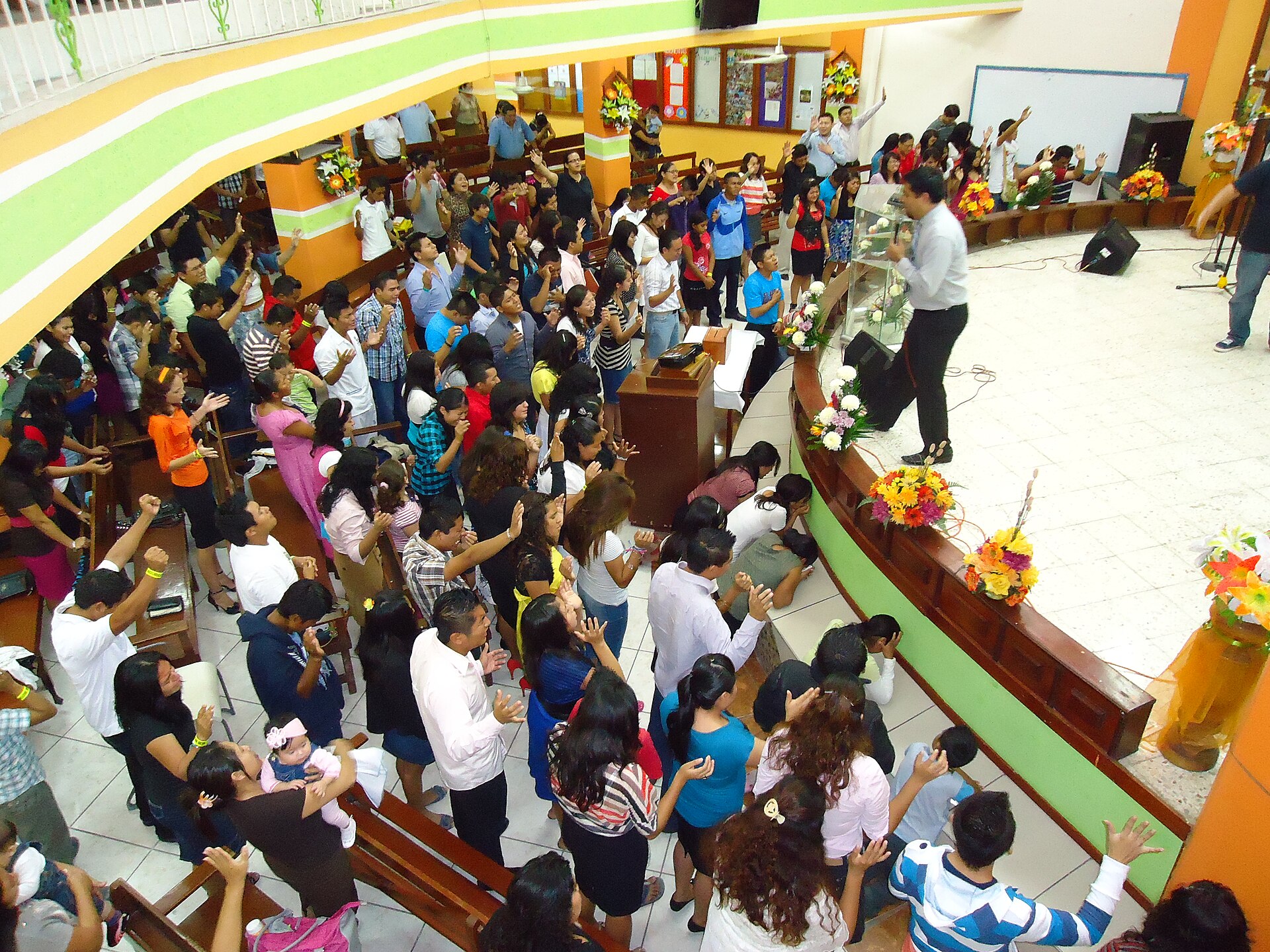 Pentecostals pray in tongues at an Assemblies of God church in Cancún, Mexico A Pentecostal believer in a spiritual experience may vocalize fluent, unintelligible utterances (glossolalia) or articulate a natural language previously unknown to them (xenoglossy). Commonly termed "speaking in tongues", this vocal phenomenon is believed by Pentecostals to include an endless variety of languages. According to Pentecostal theology, the language spoken (1) may be an unlearned human language, such as the Bible claims happened on the Day of Pentecost, or (2) it might be of heavenly (angelic) origin. In the first case, tongues could work as a sign by which witness is given to the unsaved. In the second case, tongues are used for praise and prayer when the mind is superseded and "the speaker in tongues speaks to God, speaks mysteries, and ... no one understands him".[156] Within Pentecostalism, there is a belief that speaking in tongues serves two functions. Tongues as the initial evidence of the third work of grace, baptism with the Holy Spirit,[6] and in individual prayer serves a different purpose than tongues as a spiritual gift.[156][157] All Spirit-filled believers, according to initial evidence proponents, will speak in tongues when baptized in the Spirit and, thereafter, will be able to express prayer and praise to God in an unknown tongue. This type of tongue speaking forms an important part of many Pentecostals' personal daily devotions. When used in this way, it is referred to as a "prayer language" as the believer is speaking unknown languages not for the purpose of communicating with others but for "communication between the soul and God".[158] Its purpose is for the spiritual edification of the individual. Pentecostals believe the private use of tongues in prayer (i.e. "prayer in the Spirit") "promotes a deepening of the prayer life and the spiritual development of the personality". From Romans 8:26–27, Pentecostals believe that the Spirit intercedes for believers through tongues; in other words, when a believer prays in an unknown tongue, the Holy Spirit is supernaturally directing the believer's prayer.[159] Besides acting as a prayer language, tongues also function as the gift of tongues. Not all Spirit-filled believers possess the gift of tongues. Its purpose is for gifted persons to publicly "speak with God in praise, to pray or sing in the Spirit, or to speak forth in the congregation".[160] There is a division among Pentecostals on the relationship between the gifts of tongues and prophecy.[161] One school of thought believes that the gift of tongues is always directed from man to God, in which case it is always prayer or praise spoken to God but in the hearing of the entire congregation for encouragement and consolation. Another school of thought believes that the gift of tongues can be prophetic, in which case the believer delivers a "message in tongues"—a prophetic utterance given under the influence of the Holy Spirit—to a congregation. Whether prophetic or not, however, Pentecostals are agreed that all public utterances in an unknown tongue must be interpreted in the language of the gathered Christians.[148] This is accomplished by the gift of interpretation, and this gift can be exercised by the same individual who first delivered the message (if he or she possesses the gift of interpretation) or by another individual who possesses the required gift. If a person with the gift of tongues is not sure that a person with the gift of interpretation is present and is unable to interpret the utterance themself, then the person should not speak.[148] Pentecostals teach that those with the gift of tongues should pray for the gift of interpretation.[160] Pentecostals do not require that an interpretation be a literal word-for-word translation of a glossolalic utterance. Rather, as the word "interpretation" implies, Pentecostals expect only an accurate explanation of the utterance's meaning.[162] Besides the gift of tongues, Pentecostals may also use glossolalia as a form of praise and worship in corporate settings. Pentecostals in a church service may pray aloud in tongues while others pray simultaneously in the common language of the gathered Christians.[163] This use of glossolalia is seen as an acceptable form of prayer and therefore requires no interpretation. Congregations may also corporately sing in tongues, a phenomenon known as singing in the Spirit. Speaking in tongues is not universal among Pentecostal Christians. In 2006, a ten-country survey by the Pew Forum on Religion and Public Life found that 49 percent of Pentecostals in the US, 50 percent in Brazil, 41 percent in South Africa, and 54 percent in India said they "never" speak or pray in tongues.[105] |
舌と通訳 ペンテコステ派の信者がメキシコ・カンクンのアッセンブリーズ・オブ・ゴッド教会で舌で祈る 霊的な体験をしているペンテコステ派の信者は、流暢で理解不能な発声(グロソラリア)をしたり、これまで知らなかった自然言語を話したり(ゼノグロッ シー)することがある。一般的に「舌で話す」と呼ばれるこの音声現象は、ペンテコステ派によって、無限の言語のバリエーションを含むものと信じられてい る。ペンテコステ派の神学によると、話される言語は(1)聖書がペンテコステの日に起こったと述べるような、学習されていない人間の言語である可能性があ り、(2)天界(天使)起源の言語である可能性もある。前者では、舌は未信者への証しとして機能する。後者では、舌は心が超越され、「舌で話す者は神に語 り、神秘を語り、…誰も彼を理解しない」[156] ときに、賛美と祈りのために用いられる。 ペンテコステ派では、舌で話すことは二つの機能を持つと信じられている。聖霊のバプテスマ[6] という第三の恵みの働きの最初の証拠としての異言は、霊的賜物としての異言とは異なる目的を果たしている。[156][157] 最初の証拠の支持者によると、聖霊に満たされた信者は皆、聖霊のバプテスマを受けたときに異言を話し、それ以降、未知の言語で神への祈りと賛美を表現する ことができるようになる。この種の異言は、多くのペンテコステ派の信者の個人的な毎日の献身的な祈りの重要な部分を形成している。このように使用される場 合、信者は他者とコミュニケーションをとるためではなく、「魂と神とのコミュニケーション」のために未知の言語を話すため、これは「祈りの言語」と呼ばれ る。[158] その目的は、個人の霊的啓発にある。ペンテコステ派は、祈りの中で舌を私的に使うこと(すなわち「御霊による祈り」)は、「祈りの生活を深め、人格の霊的 成長を促進する」と信じている。ローマ人への手紙8章26~27節から、ペンテコステ派は、聖霊が舌を通して信者のために取り成し祈ると信じている。つま り、信者が未知の言語で祈る時、聖霊が超自然的に信者の祈りを導いていると考える。[159] 異言は、祈りの言語としての役割だけでなく、異言の賜物としても機能する。御霊に満たされた信者全員が異言の賜物を持っているわけではない。その目的は、 賜物を持つ者が「神を賛美し、御霊によって祈ったり歌ったり、会衆の中で声を上げて話す」ことにある。[160] ペンテコステ派の間では、異言の賜物と預言の賜物の関係について意見が分かれている。[161] 一つの学派は、舌の賜物は常に人間から神に向けられていると主張し、その場合、それは常に神への祈りや賛美であり、会衆全体が励ましや慰めを受けるために 聞くものだとする。別の学派は、舌の賜物は預言的である可能性があると主張し、その場合、信者は「舌によるメッセージ」——聖霊の影響下で与えられる預言 的な言葉——を会衆に伝えると主張する。 しかし、預言的であるかどうかにかかわらず、ペンテコステ派は、未知の舌によるすべての公の言辞は、集まったキリスト教徒の言語で解釈されなければならな いと一致している。[148] これは解釈の賜物によって行われ、この賜物は、メッセージを最初に伝えた者(その者が解釈の賜物を持っている場合)または必要な賜物を持つ別の者が行使す ることができる。異言の賜物を持つ人が、解釈の賜物を持つ人がその場にいないことを確信し、その発言を自分で解釈できない場合は、その人は話すべきではな い[148]。ペンテコステ派は、異言の賜物を持つ人は、解釈の賜物を祈るべきだと教えている[160]。ペンテコステ派は、解釈が、異言の発言を文字通 り一語一語翻訳したものとなることを要求していない。むしろ、「解釈」という言葉が示すように、ペンテコステ派は、その言葉の意味の正確な説明のみを期待 している。[162] 舌の賜物以外にも、ペンテコステ派は集団の場で賛美と礼拝の形態としてグロソラリアを用いることがある。教会礼拝において、ペンテコステ派は舌で声に出し て祈りながら、他の信者は集まったキリスト教徒の共通言語で同時に祈る。[163] このグロソラリアの用法は、祈りの適切な形態と見なされるため、解釈は不要だ。会衆は集団で舌で歌うこともでき、この現象は「聖霊による歌」と呼ばれる。 舌で話すことは、ペンテコステ派のキリスト教徒の間で普遍的なものではありません。2006年にピュー・フォーラム・オン・リリジョン・アンド・パブリッ ク・ライフが実施した10カ国調査では、米国で49%、ブラジルで50%、南アフリカで41%、インドで54%のペンテコステ派が「決して」舌で話したり 祈ったりしないと回答しました。[105] |
| Power gifts The gifts of power are distinct from the vocal gifts in that they do not involve utterance. Included in this category are the gift of faith, gifts of healing, and the gift of miracles.[164] The gift of faith (sometimes called "special" faith) is different from "saving faith" and normal Christian faith in its degree and application.[165] This type of faith is a manifestation of the Spirit granted only to certain individuals "in times of special crisis or opportunity" and endues them with "a divine certainty ... that triumphs over everything". It is sometimes called the "faith of miracles" and is fundamental to the operation of the other two power gifts.[166] |
力の賜物 力の賜物は、発話を含まないという点で、声の賜物とは異なります。このカテゴリーには、信仰の賜物、癒しの賜物、奇跡の賜物などが含まれます。[164] 信仰の賜物(「特別な」信仰とも呼ばれる)は、その程度と適用において、「救いの信仰」や通常のキリスト教の信仰とは異なります。[165] この種類の信仰は、特定の個人に「特別な危機や機会」においてのみ与えられる聖霊の現れであり、彼らに「すべてを打ち破る神聖な確信」を授ける。これは 「奇跡の信仰」とも呼ばれ、他の二つの力による賜物の機能の基盤を成す。[166] |
| Trinitarianism and Oneness During the 1910s, the Finished Work Pentecostal movement split over the nature of the Godhead into two camps – Trinitarian and Oneness.[8] The Oneness doctrine viewed the doctrine of the Trinity as polytheistic.[167] The majority of Pentecostal denominations believe in the doctrine of the Trinity, which is considered by them to be Christian orthodoxy; these include Holiness Pentecostals and Finished Work Pentecostals. Oneness Pentecostals are nontrinitarian Christians, believing in the Oneness theology about God.[168] In Oneness theology, the Godhead is not three persons united by one substance, but one God who reveals himself in three different modes. Thus, God relates himself to humanity as our Father within creation, he manifests himself in human form as the Son by virtue of his incarnation as Jesus Christ (1 Timothy 3:16), and he is the Holy Spirit (John 4:24) by way of his activity in the life of the believer.[169][170] Oneness Pentecostals believe that Jesus is the name of God and therefore baptize in the name of Jesus Christ as performed by the apostles (Acts 2:38), fulfilling the instructions left by Jesus Christ in the Great Commission (Matthew 28:19), they believe that Jesus is the only name given to mankind by which we must be saved (Acts 4:12). The Oneness doctrine may be considered a form of Modalism, an ancient teaching considered heresy by the Roman Catholic Church and other trinitarian denominations. In contrast, Trinitarian Pentecostals hold to the doctrine of the Trinity, that is, the Godhead is not seen as simply three modes or titles of God manifest at different points in history, but is constituted of three completely distinct persons who are co-eternal with each other and united as one substance. The Son is from all eternity who became incarnate as Jesus, and likewise the Holy Spirit is from all eternity, and both are with the eternal Father from all eternity.[171] |
三位一体論と唯一神論 1910年代、完成の業ペンテコステ派は、神の本質について三位一体論と唯一神論の2つの派閥に分裂した。[8] 唯一神論は、三位一体の教義を多神教的であると見なした。[167] ペンテコステ派の宗派の大半は、キリスト教の正統教義であるとする三位一体の教義を信じている。これには、ホーリネス・ペンテコステ派や完成の業ペンテコ ステ派などが含まれる。一神教ペンテコステ派は、神に関する一神教の神学を信じる、非三位一体のキリスト教徒である。[168] 一神教の神学では、神は一つの物質によって結合した三つの人格ではなく、三つの異なる形態で自らを現す一つの神である。したがって、神は創造物の中での私 たちの父として人間と関わり、イエス・キリストとしての受肉により人間の姿で現れ(1テモテ3:16)、信者の人生における活動を通じて聖霊として現れる [169]。[170] 一神教のペンテコステ派は、イエスが神の名前であると信じ、したがって、使徒たちが行ったように(使徒 2:38)、イエス・キリストの名によって洗礼を施し、イエス・キリストが大宣教命令で残した指示(マタイ 28:19)を果たす。彼らは、イエスが人類に与えられた、私たちが救われるために必要な唯一の名前であると信じている(使徒 4:12)。 一神教の教義は、ローマカトリック教会や他の三位一体説を信奉する宗派によって異端とみなされている、古代の教義であるモード主義の一形態とみなすことも できる。これとは対照的に、三位一体説を信奉するペンテコステ派は、三位一体の教義、すなわち、神は単に歴史上の異なる時点で現れた 3 つの形態や称号ではなく、互いに永遠に存在し、一つの実体として結ばれた 3 つの完全に別の人格で構成されていると信じている。子は永遠から存在し、イエスとして受肉した。同様に、聖霊も永遠から存在し、両者は永遠の父と共に永遠 から存在している。[171] |
Worship Hillsong Church, a Pentecostal mega church in Sydney, Australia, known for its contemporary worship music Traditional Pentecostal worship has been described as a "gestalt made up of prayer, singing, sermon, the operation of the gifts of the Spirit, altar intercession, offering, announcements, testimonies, musical specials, Scripture reading, and occasionally the Lord's supper".[172] Russell P. Spittler identified five values that govern Pentecostal spirituality.[173] The first was individual experience, which emphasizes the Holy Spirit's personal work in the life of the believer. Second was orality, a feature that might explain Pentecostalism's success in evangelizing nonliterate cultures. The third was spontaneity; members of Pentecostal congregations are expected to follow the leading of the Holy Spirit, sometimes resulting in unpredictable services. The fourth value governing Pentecostal spirituality was "otherworldliness" or asceticism, which was partly informed by Pentecostal eschatology. The final and fifth value was a commitment to biblical authority, and many of the distinctive practices of Pentecostals are derived from a literal reading of scripture.[173] Spontaneity is a characteristic element of Pentecostal worship. This was especially true in the movement's earlier history, when anyone could initiate a song, chorus, or spiritual gift.[174] Even as Pentecostalism has become more organized and formal, with more control exerted over services,[175] the concept of spontaneity has retained an important place within the movement and continues to inform stereotypical imagery, such as the derogatory "holy roller". The phrase "Quench not the Spirit", derived from 1 Thessalonians 5:19, is used commonly and captures the thought behind Pentecostal spontaneity.[176] Prayer plays an important role in Pentecostal worship. Collective oral prayer, whether glossolalic or in the vernacular or a mix of both, is common. While praying, individuals may lay hands on a person in need of prayer, or they may raise their hands in response to biblical commands (1 Timothy 2:8). The raising of hands (which itself is a revival of the ancient orans posture) is an example of some Pentecostal worship practices that have been widely adopted by the larger Christian world.[177][178][179] Pentecostal musical and liturgical practice have also played an influential role in shaping contemporary worship trends, popularized by the leading producers of Christian music[180] from artists such as Chris Tomlin, Michael W. Smith, Zach Williams, Darlene Zschech, Matt Maher, Phil Wickham, Grace Larson, Don Moen and bands such as Hillsong Worship, Bethel Worship, Jesus Culture and Sovereign Grace Music.  Pentecostals worshiping in Slovakia Several spontaneous practices have become characteristic of Pentecostal worship. Being "slain in the Spirit" or "falling under the power" is a form of prostration in which a person falls backwards, as if fainting, while being prayed over.[181][182] It is at times accompanied by glossolalic prayer; at other times, the person is silent.[173] It is believed by Pentecostals to be caused by "an overwhelming experience of the presence of God",[183] and Pentecostals sometimes receive the baptism in the Holy Spirit in this posture.[173] Another spontaneous practice is "dancing in the Spirit". This is when a person leaves their seat "spontaneously 'dancing' with eyes closed without bumping into nearby persons or objects". It is explained as the worshipper becoming "so enraptured with God's presence that the Spirit takes control of physical motions as well as the spiritual and emotional being".[181] Pentecostals derive biblical precedent for dancing in worship from 2 Samuel 6, where David danced before the Lord.[173] A similar occurrence is often called "running the aisles". The "Jericho march" (inspired by Book of Joshua 6:1–27) is a celebratory practice occurring at times of high enthusiasm. Members of a congregation began to spontaneously leave their seats and walk in the aisles inviting other members as they go. Eventually, a full column forms around the perimeter of the meeting space as worshipers march with singing and loud shouts of praise and jubilation.[173][184] Another spontaneous manifestation found in some Pentecostal churches is holy laughter, in which worshippers uncontrollably laugh. In some Pentecostal churches, these spontaneous expressions are primarily found in revival services (especially those that occur at tent revivals and camp meetings) or special prayer meetings, being rare or non-existent in the main services. |
礼拝 オーストラリアのシドニーにあるペンテコステ派のメガチャーチ、ヒルソング教会は、現代的な礼拝音楽で知られている。 伝統的なペンテコステ派の礼拝は、「祈り、歌、説教、聖霊の賜物の働き、祭壇での執り成し、献金、お知らせ、証し、特別音楽、聖書の朗読、そして時折主の 晩餐からなる全体像」と表現されている。[172] ラッセル・P・スピットラーは、ペンテコステ派の霊性を支配する 5 つの価値観を特定した。[173] 1 つ目は、信者の人生における聖霊の個人的な働きを強調する「個人的な体験」だ。2 つ目は「口頭伝承」で、これは、ペンテコステ派が非文字文化の伝道に成功した理由を説明する特徴かもしれない。3 つ目は「自発性」で、ペンテコステ派の教会員は聖霊の導きに従うことが求められ、その結果、予測不可能な礼拝になることもある。ペンテコステ派の霊性を支 配する4つ目の価値は、「他界性」または禁欲主義で、これはペンテコステ派の終末論に一部影響を受けています。最後の5つ目の価値は、聖書の権威へのコ ミットメントで、ペンテコステ派の多くの特徴的な実践は、聖書の文字通りの解釈から派生しています。[173] 自発性は、ペンテコステ派の礼拝の特徴的な要素です。これは特に運動の初期の歴史において顕著で、誰でも歌や合唱、霊的賜物を始めることができた。 [174] ペンテコステ派がより組織化され形式化され、礼拝へのコントロールが強化されるにつれ、[175] 自発性の概念は運動内での重要な位置を維持し続け、蔑称的な「ホーリー・ローラー」のようなステレオタイプなイメージを形成し続けている。1 テサロニケ 5:19 に由来する「御霊を消してはならない」というフレーズは、よく使われ、ペンテコステ派の自発性の背後にある考えをうまく表現している。 祈りは、ペンテコステ派の礼拝において重要な役割を果たしている。集団による口頭での祈りは、グロッソラリック、現地語、あるいはその両方を混ぜた形な ど、さまざまな形でよく行われている。祈っている間、個人は祈りを必要とする人に手を置くこともあれば、聖書の指示に従って手を上げることもある(1 テモテ 2:8)。手を上げる(これは古代の祈りの姿勢の復活である)ことは、より大きなキリスト教界で広く採用されているペンテコステ派の礼拝の慣習の一例だ。 [177][178][179] ペンテコステ派の音楽的・礼拝的実践は、現代の礼拝の傾向形成にも影響を与え、クリスチャン音楽の主要なプロデューサー[180] であるクリス・トリン、マイケル・W・スミス、ザック・ウィリアムズ、ダーレン・ツシェック、マット・マハー、フィル・ウィックハム、グレイス・ラーソ ン、ドン・モエン、およびヒルソング・ウォシップ、ベテル・ウォシップ、ジーザス・カルチャー、ソヴリン・グレイス・ミュージックなどのバンドによって普 及した。  スロバキアで礼拝するペンテコステ派 いくつかの自発的な慣習が、ペンテコステ派の礼拝の特徴となっている。「御霊に打たれる」または「御霊の力に倒れる」とは、祈りを捧げられている間に、ま るで失神するように後ろに倒れる、ひれ伏すような姿勢のことだ。[181][182] 時には、異言による祈りが伴うこともあるが、多くの場合、その人は黙っている。[173] ペンテコステ派は、これは「神の臨在を圧倒的に体験したこと」によって引き起こされると信じており[183]、ペンテコステ派は、この姿勢で聖霊の洗礼を 受けることもある。[173] もう一つの自発的な慣習は、「御霊の踊り」だ。これは、人が席を立ち、「近くの人や物につまずくことなく、目を閉じて自発的に『踊る』」ことだ。これは、 礼拝者が「神の臨在に深く陶酔し、霊が肉体的な動きだけでなく、霊的・感情的な存在も支配する状態」になると説明されている。[181] ペンテコステ派は、礼拝中のダンスの聖書的な根拠を、サムエル記下6章でダビデが主の前で踊ったエピソードから導いている。[173] 同様の現象は「通路を走る」とも呼ばれる。「エリコ行進」(ヨシュア記6章1~27節に由来)は、高い熱狂の時に起こる祝祭的な実践だ。会衆のメンバーが 自発的に席を立ち、通路を歩きながら他のメンバーを誘う。やがて、礼拝者が歌と大声の賛美と喜びの叫びで進みながら、集会の空間の周囲に完全な列が形成さ れる。[173][184] ペンテコステ派の教会でみられる別の自発的な表現として、礼拝者が制御不能に笑う「聖なる笑い」がある。一部のペンテコステ派の教会では、これらの自発的 な表現は主に復興集会(特にテントでの復興集会やキャンプ集会)や特別な祈祷会でみられ、主要な礼拝では稀または存在しない。 |
| Ordinances Main article: Ordinance (Christian) Like other Christian churches, Pentecostals believe that certain rituals or ceremonies were instituted as a pattern and command by Jesus in the New Testament. Pentecostals commonly call these ceremonies ordinances. Many Christians call these sacraments, but this term is not generally used by Pentecostals and certain other Protestants as they do not see ordinances as imparting grace.[185] Instead the term sacerdotal ordinance is used to denote the distinctive belief that grace is received directly from God by the congregant with the officiant serving only to facilitate rather than acting as a conduit or vicar. The ordinance of water baptism is an outward symbol of an inner conversion that has already taken place. Therefore, most Pentecostal groups practice believer's baptism by immersion. The majority of Pentecostals do not view baptism as essential for salvation, and likewise, most Pentecostals are Trinitarian and use the traditional Trinitarian baptismal formula. However, Oneness Pentecostals view baptism as an essential and necessary part of the salvation experience and, as non-Trinitarians, reject the use of the traditional baptismal formula. For more information on Oneness Pentecostal baptismal beliefs, see the following section on Statistics and denominations. The ordinance of Holy Communion, or the Lord's Supper, is seen as a direct command given by Jesus at the Last Supper, to be done in remembrance of him. Pentecostal denominations, who traditionally support the temperance movement, reject the use of wine as part of communion, using grape juice instead.[186][187] Certain Pentecostal denominations observe the ordinance of women's headcovering in obedience to 1 Corinthians 11:4–13.[188] Foot washing is also held as an ordinance by some Pentecostals.[189] It is considered an "ordinance of humility" because Jesus showed humility when washing his disciples' feet in John 13:14–17.[185] Other Pentecostals do not consider it an ordinance; however, they may still recognize spiritual value in the practice.[190] |
規律 主な記事:規律(キリスト教) 他のキリスト教教会と同様、ペンテコステ派は、特定の儀礼や儀式は、新約聖書の中でイエスによってパターンおよび命令として制定されたと信じている。ペン テコステ派は、これらの儀式を一般的に「条例」と呼んでいる。多くのキリスト教徒は、これらを「聖餐」と呼んでいるが、ペンテコステ派や特定の他のプロテ スタントは、条例は恵みを授けるものではないとみなしているため、この用語は一般的に使用されていない。 [185] 代わりに、聖職者の規律という用語は、恵みは、司式者が媒介者や代理人として行動するのではなく、会衆が神から直接受けるという独特の信念を表すために使用される。 水洗礼の規律は、すでに起こった内面の回心を表す外的な象徴である。そのため、ほとんどのペンテコステ派は、信者の浸礼による洗礼を実践している。ペンテ コステ派の大半は、バプテスマを救いに不可欠なものとは考えていない。同様に、ほとんどのペンテコステ派は三位一体説を信じ、伝統的な三位一体のバプテス マの定式を使用している。しかし、一神教ペンテコステ派は、バプテスマを救いの経験に不可欠かつ必要な要素とみなしており、三位一体説を否定するため、伝 統的なバプテスマの定式の使用を拒否している。一神教ペンテコステ派のバプテスマの信条に関する詳細については、以下の「統計と宗派」のセクションを参照 のこと。 聖体拝領、すなわち主の晩餐の規律は、イエスが最後の晩餐で、彼を偲ぶために行うよう直接命じたものとみなされている。伝統的に禁酒運動を支持するペンテ コステ派の宗派は、聖体拝領にワインを使用することを拒否し、代わりにグレープジュースを使用している。[186][187] 一部のペンテコステ派の宗派は、1コリント11:4-13に従い、女性が頭部を覆うという規律を遵守している。[188] 足洗いも、一部のペンテコステ派によって規律として行われている。[189] これは、イエスがヨハネ 13:14-17 で弟子たちの足を洗ったときに謙遜を示したことから、「謙遜の規律」とみなされている。[185] 他のペンテコステ派は、これを規律とはみなしていないが、その慣習に霊的な価値を認めている場合もある。[190] |
| Statistics and denominations Further information: List of Christian denominations § Pentecostalism See also: List of Pentecostal churches https://en.wikipedia.org/wiki/Pentecostalism A Pentecostal church in Ravensburg, Germany A modern Pentecostal church in Seinäjoki, Finland Pentecostal pastors pray over the Colombian flag. According to various scholars and sources, Pentecostalism is the fastest-growing religious movement in the world;[191][192][193][194][195] this growth is primarily due to religious conversion to Pentecostal and Charismatic Christianity.[196][197] According to Pulitzer Center 35,000 people become Pentecostal or "Born again" every day.[198] According to scholar Keith Smith of Georgia State University "many scholars claim that Pentecostalism is the fastest growing religious phenomenon in human history",[199] and according to scholar Peter L. Berger of Boston University "the spread of Pentecostal Christianity may be the fastest growing movement in the history of religion".[199] Worship service at the Word and Life Church in Boksburg, Apostolic Faith Mission of South Africa. In 1995, David Barrett estimated there were 217 million "Denominational Pentecostals" throughout the world.[200] In 2011, a Pew Forum study of global Christianity found that there were an estimated 279 million classical Pentecostals, making 4 percent of the total world population and 12.8 percent of the world's Christian population Pentecostal.[201] The study found "Historically Pentecostal denominations" (a category that did not include independent Pentecostal churches) to be the largest Protestant denominational family.[202] The largest percentage of Pentecostals are found in Sub-Saharan Africa (44 percent), followed by the Americas (37 percent)[203] and Asia and the Pacific (16 percent).[204] The movement is witnessing its greatest surge today in the global South, which includes Africa, Central and Latin America, and most of Asia.[205][206] There are 740 recognized Pentecostal denominations,[207] but the movement also has a significant number of independent churches that are not organized into denominations.[208] Among the over 700 Pentecostal denominations, 240 are classified as part of Wesleyan, Holiness, or "Methodistic" Pentecostalism. Until 1910, Pentecostalism was universally Wesleyan in doctrine, and Holiness Pentecostalism continues to predominate in the Southern United States. Wesleyan Pentecostals teach that there are three crisis experiences within a Christian's life: conversion, sanctification, and Spirit baptism. They inherited the holiness movement's belief in entire sanctification.[6] According to Wesleyan Pentecostals, entire sanctification is a definite event that occurs after salvation but before Spirit baptism. This inward experience cleanses and enables the believer to live a life of outward holiness. This personal cleansing prepares the believer to receive the baptism in the Holy Spirit. Holiness Pentecostal denominations include the Apostolic Faith Church, Calvary Holiness Association, Congregational Holiness Church, Free Gospel Church, Church of God in Christ, Church of God (Cleveland, Tennessee), and the Pentecostal Holiness Church.[207][209][210] In the United States, many Holiness Pentecostal clergy are educated at the Heritage Bible College in Savannah, Georgia and the Free Gospel Bible Institute in Murrysville, Pennsylvania.[211][212] After William H. Durham began preaching his Finished Work doctrine in 1910, many Pentecostals rejected the Wesleyan doctrine of entire sanctification and began to teach that there were only two definite crisis experiences in the life of a Christian: conversion and Spirit baptism. These Finished Work Pentecostals (also known as "Baptistic" or "Reformed" Pentecostals because many converts were originally drawn from Baptist and Presbyterian backgrounds) teach that a person is initially sanctified at the moment of conversion. After conversion, the believer grows in grace through a lifelong process of progressive sanctification. There are 390 denominations that adhere to the finished work position. They include the Assemblies of God, the Foursquare Gospel Church, the Pentecostal Church of God, and the Open Bible Churches.[207][209] The 1904–1905 Welsh Revival laid the foundation for British Pentecostalism including a distinct family of denominations known as Apostolic Pentecostalism (not to be confused with Oneness Pentecostalism). These Pentecostals are led by a hierarchy of living apostles, prophets, and other charismatic offices. Apostolic Pentecostals are found worldwide in 30 denominations, including the Apostolic Church based in the United Kingdom.[207] There are 80 Pentecostal denominations that are classified as Jesus's Name or Oneness Pentecostalism (often self identifying as "Apostolic Pentecostals").[207] These differ from the rest of Pentecostalism in several significant ways. Oneness Pentecostals reject the doctrine of the Trinity. They do not describe God as three persons but rather as three manifestations of the one living God. Oneness Pentecostals practice Jesus's Name Baptism—water baptisms performed in the name of Jesus Christ, rather than that of the Trinity. Oneness Pentecostal adherents believe repentance, baptism in Jesus's name, and Spirit baptism are all essential elements of the conversion experience.[213] Oneness Pentecostals hold that repentance is necessary before baptism to make the ordinance valid, and receipt of the Holy Spirit manifested by speaking in other tongues is necessary afterwards, to complete the work of baptism. This differs from other Pentecostals, along with evangelical Christians in general, who see only repentance and faith in Christ as essential to salvation. This has resulted in Oneness believers being accused by some (including other Pentecostals) of a "works-salvation" soteriology,[214] a charge they vehemently deny. Oneness Pentecostals insist that salvation comes by grace through faith in Christ, coupled with obedience to his command to be "born of water and of the Spirit"; hence, no good works or obedience to laws or rules can save anyone.[215] For them, baptism is not seen as a "work" but rather the indispensable means that Jesus himself provided to come into his kingdom. The major Oneness churches include the United Pentecostal Church International and the Pentecostal Assemblies of the World. In addition to the denominational Pentecostal churches, there are many Pentecostal churches that choose to exist independently of denominational oversight.[208] Some of these churches may be doctrinally identical to the various Pentecostal denominations, while others may adopt beliefs and practices that differ considerably from classical Pentecostalism, such as Word of Faith teachings or Kingdom Now theology. Some of these groups have been successful in utilizing the mass media, especially television and radio, to spread their message.[216] According to a denomination census in 2024, the Assemblies of God, the largest Pentecostal denomination in the world, has 450,106 churches and 86,143,293 members worldwide.[217] The other major international Pentecostal denominations are the Apostolic Church with 15,000,000 members,[218] the Church of God (Cleveland) with 36,000 churches and 7,000,000 members,[219] The Foursquare Church with 67,500 churches and 8,800,000 members,[220] and the United Pentecostal Church International with 45,521 church and 5,800,000 members.[221] Among the censuses carried out by Pentecostal denominations published in 2020, those claiming the most members were on each continent: In Africa, the Redeemed Christian Church of God,[222] with 14,000 churches and 5 million members. In North America, the Assemblies of God USA with 12,986 churches and 1,810,093 members.[223] In South America, the General Convention of the Assemblies of God in Brazil with 12,000,000 members.[224] In Asia, the Indonesian Bethel Church with 5,000 churches and 3,000,000 members.[225] In Europe, the Assemblies of God of France with 658 churches and 40,000 members.[226] In Oceania, the Australian Christian Churches with 1,000 churches and 375,000 members.[227] |
統計と宗派 詳細情報:キリスト教の宗派一覧 § ペンテコステ派 関連項目:ペンテコステ派の教会一覧 https://en.wikipedia.org/wiki/Pentecostalism ドイツ、ラーヴェンスブルクにあるペンテコステ派の教会 フィンランド、セイナヨキにある現代的なペンテコステ派の教会 コロンビアの国旗の上に祈りを捧げるペンテコステ派の牧師たち。 さまざまな学者や情報源によると、ペンテコステ派は世界で最も急成長している宗教運動である[191]。[192][193][194][195] この成長は、主にペンテコステ派およびカリスマ的キリスト教への宗教的改宗によるものである[196][197]。ピューリッツァー・センターによると、 毎日 35,000 人がペンテコステ派または「生まれ変わった」人になっている[198]。ジョージア州立大学の学者キース・スミスによると、「多くの学者は、ペンテコステ リズムは人類史上最も急成長している宗教現象であると主張している」[199]、またボストン大学の学者ピーター・L・バーガーによると、「ペンテコステ 派キリスト教の広がりは、宗教史上最も急成長している運動であるかもしれない」[199]。 南アフリカの使徒信仰宣教団、ボクスブルグのワード・アンド・ライフ教会での礼拝。 1995年、デビッド・バレットは、世界中に2億1700万人の「宗派ペンテコステ派」がいると推定した。[200] 2011年、ピュー・フォーラムによる世界キリスト教に関する調査では、推定2億7900万人の古典的ペンテコステ派が存在し、これは世界総人口の4%、 世界のキリスト教徒人口の12.8%を占めるペンテコステ派であることが明らかになった。[201] この調査では、「歴史的にペンテコステ派の宗派」(独立したペンテコステ派教会は含まない)が、プロテスタントの宗派の中で最大の宗派であることが明らか になった。[202] ペンテコステ派の信者の割合が最も高いのは、サハラ以南のアフリカ(44%)で、次いでアメリカ大陸(37%)[203]、アジア太平洋地域(16%)と なっている。[204] この運動は現在、アフリカ、中央アメリカ、ラテンアメリカ、およびアジアの大部分を占める「グローバル・サウス」で最大の拡大を遂げています。[205] [206] 認定されたペンテコステ派教派は740派ありますが、教派に組織化されていない独立した教会も数多く存在します。[208] 700を超えるペンテコステ派の教派のうち、240はウェスレー派、ホーリネス派、または「メソジスト」ペンテコステ派に分類される。1910年まで、ペ ンテコステ派は教義において普遍的にウェスレー派であり、ホーリネス派ペンテコステ派は米国南部で依然として優勢である。ウェスレー派ペンテコステ派は、 キリスト教徒の生涯において3つの危機的経験があるとする:回心、聖化、聖霊の洗礼。彼らはホーリネス運動の「完全聖化」の信仰を継承している。[6] ウェスレー派ペンテコステ派によると、完全聖化は救い後に起こるが聖霊の洗礼前の明確な出来事である。この内面的経験は信者を清め、外的な聖潔の生活を送 る能力を与える。この個人的な清めは、信者が聖霊のバプテスマを受ける準備をするものです。ホーリネス・ペンテコステ派の宗派には、使徒信仰教会、カルバ リー・ホーリネス協会、会衆ホーリネス教会、フリー・ゴスペル教会、キリストの教会、神教会(テネシー州クリーブランド)、ペンテコステ・ホーリネス教会 などがあります。[207][209][210] アメリカ合衆国では、多くのホーリネス・ペンテコステ派の聖職者が、ジョージア州サバンナにあるヘリテージ・バイブル・カレッジとペンシルベニア州マーリ スビルにあるフリー・ゴスペル・バイブル・インスティテュートで教育を受けている。[211][212] 1910年にウィリアム・H・ダーラムが「完成した働き」の教義を説き始めた後、多くのペンテコステ派はウェスレーの「完全聖化」の教義を拒否し、クリス チャンの人生には、回心と聖霊のバプテスマという 2 つの明確な危機的経験しかないと教え始めた。これらの「完成の業」ペンテコステ派(多くの改宗者がもともとバプテスト派や長老派出身であったことから、 「バプテスト派」または「改革派」ペンテコステ派とも呼ばれる)は、人格は改宗の瞬間に最初に聖化されると教えている。改宗後、信者は生涯にわたる漸進的 な聖化のプロセスを通じて恵みの中で成長する。完成の業の立場を支持する教派は390に上る。これには、アッセンブリーズ・オブ・ゴッド、フォースクエ ア・ゴスペル・チャーチ、ペンテコステ・チャーチ・オブ・ゴッド、オープン・バイブル・チャーチズなどが含まれる。[207][209] 1904年から1905年のウェールズ復興は、イギリス・ペンテコステ派の基盤を築き、アポストロリック・ペンテコステ派(オネネス・ペンテコステ派と混 同しないこと)と呼ばれる独自の教派群を生み出した。これらのペンテコステ派は、生きている使徒、預言者、その他のカリスマ的役職からなる階層制によって 指導されている。アポストロリック・ペンテコステ派は、イギリスを拠点とするアポストロリック・チャーチを含む30の教派に世界中に存在する。[207] イエスの名または一神教ペンテコステ派(多くの場合、「使徒ペンテコステ派」と自称)に分類されるペンテコステ派の宗派は 80 あります。[207] これらは、いくつかの重要な点で他のペンテコステ派とは異なります。一神教ペンテコステ派は、三位一体の教義を否定しています。彼らは、神を 3 つの人格としてではなく、1 つの生ける神の 3 つの現れとして表現しています。ワンネス・ペンテコステ派は、イエス・キリストの名による洗礼、つまり三位一体の名ではなく、イエス・キリストの名によっ て行われる水洗礼を実践している。ワンネス・ペンテコステ派の信者は、悔い改め、イエス・キリストの名による洗礼、そして聖霊の洗礼が、改宗の経験に欠か せない要素であると信じている。[213] 一神教ペンテコステ派は、規律を有効にするためには、バプテスマの前に悔い改めが必要であり、バプテスマの業を完了するには、その後、異言を話すことに よって現れる聖霊の受領が必要であると主張している。これは、悔い改めとキリストへの信仰だけが救いに不可欠であると考える他のペンテコステ派や、一般的 な福音派キリスト教徒とは異なっている。これにより、オネネス派の信者は、一部の人々(他のペンテコステ派を含む)から「行いによる救い」の救済論を非難 されています[214]。しかし、彼らはこの非難を強く否定しています。オネネス派のペンテコステ派は、救いはキリストへの信仰による恵みによって与えら れるものであり、その命令である「水と聖霊によって生まれよ」に従うことが不可欠であると主張しています。したがって、良い行いや法律や規則への従順は、 誰をも救うことはできません。[215] 彼らにとって、洗礼は「業」ではなく、イエス自身がその王国に入るための不可欠な手段として提供したものと見なされている。主要なオネネス派の教会には、 国際ペンテコステ派教会連合(United Pentecostal Church International)と世界ペンテコステ派集会(Pentecostal Assemblies of the World)がある。 宗派のペンテコステ派教会に加えて、宗派の監督から独立して存在することを選択した多くのペンテコステ派教会があります。[208] これらの教会の中には、教義上、さまざまなペンテコステ派の宗派と全く同じであるものもありますが、信仰の言葉の教えやキングダム・ナウ神学など、古典的 なペンテコステ派とはかなり異なる信仰や慣習を採用しているものもあります。これらのグループの中には、マスメディア、特にテレビやラジオをうまく活用し て、そのメッセージを広めることに成功しているものもあります。[216] 2024年の宗派調査によると、世界最大のペンテコステ派宗派である神召教会は、世界中に450,106の教会と86,143,293人の会員を擁してい る。[217] その他の主要な国際的なペンテコステ派教派には、1,500万人の信者を擁する使徒教会[218]、36,000の教会と700万人の信者を擁するゴッ ド・チャーチ(クリーブランド)[219] フォースクエア教会(67,500の教会と8,800,000の信者)、[220] 国際ペンテコステ教会連合(45,521の教会と5,800,000の信者)[221] です。 2020年にペンテコステ派の教派が発表した人口調査によると、各大陸で最も多くの会員数を誇る教派は以下の通りです。 アフリカでは、リディーム・クリスチャン・チャーチ・オブ・ゴッド[222]が14,000の教会と500万人の会員を擁しています。 北米では、アセンブリーズ・オブ・ゴッド・USAが12,986の教会と1,810,093人の会員を擁しています。[223] 南アメリカでは、ブラジル神召教会が 12,000,000 人の会員を擁している。[224] アジアでは、インドネシアのベテル教会が 5,000 の教会と 3,000,000 人の会員を擁している。 |
| Assessment from the social sciences Zora Neale Hurston This Pentecostal centre of worship has incorporated a populist label into its name, the Peoples Church Dublin City Zora Neale Hurston performed anthropological and sociological studies examining the spread of Pentecostalism, published posthumously in a collection of essays called The Sanctified Church.[228] According to scholar of religion Ashon Crawley, Hurston's analysis is important because she understood the class struggle that this seemingly new religiocultural movement articulated: "The Sanctified Church is a protest against the high-brow tendency in Negro Protestant congregations as the Negroes gain more education and wealth."[228] She stated that this sect was "a revitalizing element in Negro music and religion" and that this collection of groups was "putting back into Negro religion those elements which were brought over from Africa and grafted onto Christianity." Crawley would go on to argue that the shouting that Hurston documented was evidence of what Martinique psychoanalyst Frantz Fanon called the refusal of positionality wherein "no strategic position is given preference" as the creation of, the grounds for, social form.[229] [229] Crawley, Ashon T. 2017. Blackpentecostal Breath: The Aesthetics of Possibility. New York: Fordham University Press. Page 106 *We might even, because of Fanon, consider the shout traditions as guerilla warfare, a particularly violent intervention into emergence into the normative subject position. See Frantz Fanon, The Wretched of the Earth (New York : Grove, 1968), 85. |
社会科学からの評価 ゾラ・ニール・ハーストン このペンテコステ派の礼拝センターは、その名称に「人民教会」という大衆的な名称を取り入れている。 ゾラ・ニール・ハーストンは、ペンテコステ派の広がりを調査する人類学的・社会学的研究を行い、その成果は死後、エッセイ集『The Sanctified Church』として出版された[228]。宗教学者のアション・クローリーによると、ハーストンの分析は、この一見新しい宗教文化運動が表現していた階 級闘争を理解していた点で重要だ。「聖化教会は、ニグロのプロテスタント教会で、ニグロが教育と富を得るにつれて高まる高学歴志向に対する抗議だ」 [228]。彼女は、この宗派は「ニグロの音楽と宗教に活力を与える要素」であり、この集団は「アフリカから持ち込まれ、キリスト教に接ぎ木された要素 を、ニグロの宗教に戻している」と述べた。クローリーはさらに、ハーストンが記録した叫びは、マルティニークの精神分析学者フランツ・ファノンが「戦略的 位置を優先しない」として、社会形態の創造の基盤となる「位置性の拒否」の証拠だと主張した。[229] [229] Crawley, Ashon T. 2017. Blackpentecostal Breath: The Aesthetics of Possibility. New York: Fordham University Press. Page 106 *ファノンのおかげで、私たちは、叫びの伝統をゲリラ戦争、つまり規範的な主体的位置への出現に対する特に暴力的な介入とさえ考えることができるだろう。フランツ・ファノン『地に呪われたる者たち』(ニューヨーク:Grove、1968年)85ページを参照。 |
| Rural Pentecostalism Pentecostalism is a religious phenomenon more visible in the cities. However, it has attracted significant rural populations in Latin America, Africa, and Eastern Europe. Sociologist David Martin[230] has called attention on an overview on the rural Protestantism in Latin America, focusing on the indigenous and peasant conversion to Pentecostalism. The cultural change resulting from the countryside modernization has reflected on the peasant way of life. Consequently, many peasants – especially in Latin America – have experienced collective conversion to different forms of Pentecostalism and interpreted as a response to modernization in the countryside.[231][232][233][234] Rather than a mere religious shift from folk Catholicism to Pentecostalism, Peasant Pentecostals have dealt with agency to employ many of their cultural resources to respond development projects in a modernization framework.[235][236][237] Researching Guatemalan peasants and indigenous communities, Sheldon Annis[231] argued that conversion to Pentecostalism was a way to quit the burdensome obligations of the cargo-system. Mayan folk Catholicism has many fiestas with a rotation leadership who must pay the costs and organize the yearly patron-saint festivities. One of the socially-accepted ways to opt out those obligations was to convert to Pentecostalism. By doing so, the Pentecostal Peasant engage in a "penny capitalism". In the same lines of moral obligations but with different mechanism economic self-help, Paul Chandler[235] has compared the differences between Catholic and Pentecostal peasants, and has found a web of reciprocity among Catholics compadres, which the Pentecostals lacked. However, Alves[232] has found that the different Pentecostal congregations replaces the compadrazgo system and still provide channels to exercise the reciprocal obligations that the peasant moral economy demands. Conversion to Pentecostalism provides a rupture with a socially disrupted past while allowing to maintain elements of the peasant ethos. Brazil has provided many cases to evaluate this thesis. Hoekstra[238] has found out that rural Pentecostalism more as a continuity of the traditional past though with some ruptures. Anthropologist Brandão[239] sees the small town and rural Pentecostalism as another face for folk religiosity instead of a path to modernization. With similar finding, Abumanssur[240] regards Pentecostalism as an attempt to conciliate traditional worldviews of folk religion with modernity. Identity shift has been noticed among rural converts to Pentecostalism. Indigenous and peasant communities have found in the Pentecostal religion a new identity that helps them navigate the challenges posed by modernity.[241][242][243][244] This identity shift corroborates the thesis that the peasant Pentecostals pave their own ways when facing modernization. |
農村部のペンテコステ派 ペンテコステ主義は、都市部でより顕著に見られる宗教現象です。しかし、ラテンアメリカ、アフリカ、東ヨーロッパでは、農村部の住民もこの宗教に多く参加 しています。社会学者デビッド・マーティン[230] は、ラテンアメリカの農村部のプロテスタントについて、先住民や農民のペンテコステ主義への改宗に焦点を当てて概要を紹介し、この現象に注目しています。 農村の近代化によって生じた文化の変化は、農民の生活にも反映されています。その結果、多くの農民、特にラテンアメリカの農民は、さまざまな形態のペンテ コステリズムに集団で改宗し、それは農村部の近代化に対する反応であると解釈されている[231][232][233][234]。 農民ペンテコステ派は、単なるカトリックからペンテコステリズムへの宗教的転換ではなく、近代化の枠組みにおける開発プロジェクトに対応するために、自分たちの文化的資源の多くを活用する主体性を持って対応してきた。[235][236][237] グアテマラの農民と先住民コミュニティを研究したシェルドン・アニス[231] は、ペンテコステ派への改宗は、カーゴシステムの重荷となる義務から逃れる手段だったと主張している。マヤの民俗カトリックには、費用負担と毎年恒例の守 護聖人祭りの企画を担当するリーダーが交代で務める多くの祭事がある。こうした義務から逃れるために社会的に容認されている方法の 1 つが、ペンテコステ派への改宗だった。そうすることで、ペンテコステ派の農民は「ペニー資本主義」に従事することになる。道徳的義務という同じ線上で、し かし異なる経済的自助のメカニズムについて、ポール・チャンドラー[235] は、カトリックの農民とペンテコステ派の農民の違いを比較し、カトリックのコンパドレス(仲間)の間に、ペンテコステ派には見られない相互扶助のネット ワークがあることを発見した。しかし、アルベス[232] は、異なるペンテコステ派の教会がコンパドラズゴ制度に取って代わり、農民の道徳経済が要求する相互の義務を果たす手段を提供し続けていることを発見し た。 ペンテコステ派への改宗は、社会的に混乱した過去との決別をもたらし、同時に農民の精神の要素を維持することを可能にする。ブラジルには、この説を評価す る多くの事例がある。ホークストラ[238]は、農村部のペンテコステ派は伝統的な過去との連続性として機能しているが、一部断絶も存在すると指摘してい る。人類学者のブランダオ[239]は、小都市と農村部のペンテコステ派を、近代化への道ではなく、民衆宗教の別の顔と見なしている。同様の発見に基づ き、アブマンスール[240]は、ペンテコステ派を、民衆宗教の伝統的世界観と近代性を調和させる試みと位置付けている。 農村部のペンテコステ派改宗者たち之间でアイデンティティの転換が観察されている。先住民や農民コミュニティは、ペンテコステ派宗教において、現代性がも たらす課題に対処するための新たなアイデンティティを見出している。[241][242][243][244] このアイデンティティの転換は、農民ペンテコステ派が近代化に直面する際、独自の道を切り拓くという主張を裏付けている。 |
| Pentecostalism in Academia At the heart of Pentecostalism's distinctive doctrine is a divergence from the typical understanding of the function of the Holy Spirit in the life of a believer[245]. This nuanced approach to the function of the Holy Spirit is based on the Day of Pentecost narrative from Acts 2 and has caused significant tension with other Christian traditions.[246] Thus, foundational Pentecostal scholarship explores how a Pentecostal understands the function of the Holy Spirit, the hermenuetical apparatus a Pentecostal may use to interpret and exposit the Day of Pentecost narrative, the resulting Pentecostal ecclessiology and its significance. Roger Stronstad with his The Charismatic Theology of St. Luke[247] serves as the progenitor of Pentecostal scholarship. |
学界におけるペンテコステ派 ペンテコステ派の独特な教義の中心にあるのは、信者の生活における聖霊の機能に関する一般的な理解からの逸脱だ[245]。聖霊の機能に対するこの微妙な アプローチは、使徒行伝第 2 章のペンテコステの日の記述に基づいており、他のキリスト教の伝統と大きな緊張関係を引き起こしている。[246] したがって、基礎的なペンテコステ派の学術研究は、ペンテコステ派が聖霊の機能をどのように理解するか、ペンテコステ派がペンテコステの日の物語を解釈し 解説するために使用する解釈学的な枠組み、その結果としてのペンテコステ派の教会論とその意義を考察する。ロジャー・ストロンスタッドの『聖ルカのカリス マ的神学』[247]は、ペンテコステ派の学術研究の先駆的な著作である。 |
| Controversies and criticism Various Christian groups have criticized the Pentecostal and charismatic movement for too much attention to mystical manifestations, such as glossolalia (which, for a believer, would be the obligatory sign of a baptism with the Holy Spirit); along with falls to the ground, moans and cries during worship services, as well as anti-intellectualism.[248] A particularly controversial doctrine in the Evangelical Churches is that of the prosperity theology, which spread in the 1970s and 1980s in the United States, mainly through Pentecostals and charismatic televangelists.[249][250] This doctrine is centered on the teaching of Christian faith as a means to enrich oneself financially and materially through a "positive confession" and a contribution to Christian ministries.[251] Promises of divine healing and prosperity are guaranteed in exchange for certain amounts of donation.[252][253] Some pastors threaten those who do not tithe with curses, attacks from the devil and poverty.[254][255] The collections of offerings are multiple or separated in various baskets or envelopes to stimulate the contributions of the faithful.[256][257] The offerings and the tithe occupies a lot of time in some worship services.[257] Often associated with the mandatory tithe, this doctrine is sometimes compared to a religious business.[258][259][260] In 2012, the National Council of Evangelicals of France published a document denouncing this doctrine, mentioning that prosperity was indeed possible for a believer, but that this theology taken to the extreme leads to materialism and to idolatry, which is not the purpose of the gospel.[261][262] Pentecostal pastors adhering to prosperity theology have been criticized by journalists for their lavish lifestyle (luxury clothes, big houses, high end cars, private aircraft, etc.).[263] In Pentecostalism, rifts accompanied the teaching of faith healing. In some churches, pricing for prayer against promises of healing has been observed.[231] Some pastors and evangelists have been charged with claiming false healings.[264][265] Some churches have advised their members against vaccination or other medicine, stating that it is for those weak in the faith and that with a positive confession, they would be immune from the disease.[266][267] Pentecostal churches that discourage the use of medicine have caused preventable deaths, sometimes leading to parents being sentenced to prison for the deaths of their children.[268] This position is not representative of most Pentecostal churches.[citation needed] "The Miraculous Healing", published in 2015 by the National Council of Evangelicals of France [fr], describes medicine as one of the gifts given by God to humanity.[269][270] Churches and certain evangelical humanitarian organizations are also involved in medical health programs.[271][272][273] In Pentecostalism, health and sickness is understood holistically. They are not just physical, concurrently, psychological and spiritual, i.e. diseases and despair are from evil forces; devil, sin. Through spiritual intimacy with ultimate divinity any illness can be healed. Today's Pentecostals accept biomedicine, but believe that divine intervention heals even where biomedicine fails. But critics argue that Pentecostal healers induce merely a placebo effect. In the anthropological view, the placebo effect mirrors that humans are a "socio-psycho-physical entity", thus through symbolic manipulation i.e. strong belief on divinity, rituals and miracles, it may induce an actual healing effect on the physical level.[274] In Pentecostalism, healing mainly is a spiritual experience.[275] Being worthy of having an intimacy with God (i.e. ability to confess, forgiveness) gives a cathartic effect[276] which leads to inner healing; accepting of self, healing from memories, which cleanse the root of emotional wounds and sufferings.[275] Divine healing also addresses socially born distresses; socio gender inequalities, racial hatreds which often emerge as physical ailments[276] by empowering patients. Pentecostalism's divine healing practice is frequently dismissed as emotional or illogical, yet anthropological research reveals its profound cultural and social significance. Hefner[277] demonstrates how deeply rooted Pentecostal healing is in the social structures of countries like Indonesia. Healing techniques are not superstitious; rather, they are an expression of, and response to local power structures and social hierarchies. By functioning as tools for negotiating social roles and upholding communal ties, they show that these activities address genuine social issues and are not isolated from ordinary life. Meyer[278] shows how Pentecostal healing has a similar entanglement with broader cultural frameworks. Giving them a sense of empowerment dispels the notion that these activities are only a means of escape and group support. The focus on divine healing frequently reflects cultural perspectives on health and wellbeing, where social and spiritual dimensions are vital to comprehending and regulating health. Even while Pentecostals occasionally choose not to receive traditional medical care, this decision is influenced by a larger cultural framework that places a high importance on spiritual guidance and communal support. Pentecostalism's doctrine belief in faith healing has been criticized for more than just its aversion to modern medicine, their tendency to attribute mental health conditions to demonic activity has also been questioned.[279] Faith healing has been the subject of numerous studies with a vast number of scholars aiming to either debunk or prove the effects of its use. One study however aimed rather to explore faith healing as a social construction. The study tracked the healing progress of over 100 participants. Throughout the study a significant number of participants went on to redefine their problem, such as one woman whose original problem was severe back pain; however at the conclusion of the study, she claims her troublesome relationship with her son was healed. Further the study found a correlation between those who redefine their issue and those who are more likely to claim they were healed. These findings suggest that these healings may not be a result of divine intervention. Glik[280] stated that "redefinitions may mirror therapeutic processes of self-discovery" meaning these acts of faith healing may simply be the result of self-growth or the result of the restructure of one's world view as they progress into a religious world view. |
論争と批判 さまざまなキリスト教団体は、ペンテコステ派やカリスマ派が、グロソラリア(信者にとっては聖霊の洗礼の必須の兆候とされる)などの神秘的な現象に過度の 関心を寄せていること、礼拝中に地面に倒れ込んだり、うめき声や叫び声を上げたりすること、反知性主義を批判している。[248] 福音教会で特に論争となっている教義は、1970年代から1980年代にかけて、主にペンテコステ派やカリスマ的なテレビ伝道者たちによって米国で広まっ た繁栄神学である。[249][250] この教義は、キリスト教の信仰を「ポジティブな告白」とキリスト教の宣教活動への献金を通じて、金銭的・物質的な豊かさを得る手段として教えることに焦点 を当てている。[251] 一定の献金を支払うことで、神の癒しと繁栄が約束される。[252][253] 一部の牧師は、献金をしない信者に対して、呪い、悪魔の攻撃、貧困を脅かす。[254][255] 献金の収集は複数回行われたり、複数のバスケットや封筒に分けて行われたりして、信者の献金を刺激する。[256][257] 献金と献金は、一部の礼拝サービスで多くの時間を占める。[257] 強制的な献金と関連付けられるこの教義は、時折宗教的なビジネスに例えられる。[258][259][260] 2012年、フランス福音同盟は、この教義を非難する文書を発表し、信者にとって繁栄は確かに可能だが、この神学を極端に取り入れると、物質主義や偶像崇 拝につながり、それは福音の目的ではないと述べた。[261][262] 繁栄神学を信奉するペンテコステ派の牧師たちは、豪華な生活(高級服、大きな家、高級車、プライベートジェットなど)について、ジャーナリストから批判さ れている。[263] ペンテコステ派では、信仰による癒しの教えとともに分裂が生じた。一部の教会では、癒しの約束と引き換えに祈りの料金を請求する事例が見られた。 [231] 一部の牧師や伝道者は、偽りの癒しを主張したとして告発されている。[264][265] 一部の教会は、ワクチン接種や他の医療を信者に対して反対し、それは信仰の弱い者向けであり、肯定的な告白があれば病気から免れると主張している。 [266][267] 医療の使用を禁じるペンテコステ派の教会は、予防可能な死亡を引き起こし、場合によっては親が子供の死亡で懲役刑を科せられる事態に至っている。 [268] この立場は、ほとんどのペンテコステ派教会を代表するものではありません。[要出典] 2015 年にフランス福音同盟 [fr] が発行した「奇跡の癒やし」では、薬は神が人類に与えた賜物の一つであると説明されています。[269][270] 教会や特定の福音主義人道支援団体も、医療保健プログラムに関わっています。[271][272][273] ペンテコステ派では、健康と病気は全体論的に理解されている。それらは単に肉体的なものではなく、同時に心理的、精神的なものでもあり、つまり病気や絶望 は悪魔や罪といった悪の力によるものと考えられている。究極の神との精神的な親密さを通じて、あらゆる病気は癒される。今日のペンテコステ派は、生物医学 を受け入れているが、生物医学が失敗した場合でも、神の介入によって癒されると信じている。しかし、批評家は、ペンテコステ派のヒーラーは単なるプラセボ 効果を引き起こしているだけだと主張している。人類学的見解では、プラセボ効果は、人間が「社会心理物理的実体」であることを反映しており、したがって、 象徴的な操作、すなわち神性、儀礼、奇跡に対する強い信念を通じて、物理的なレベルで実際の治癒効果をもたらす可能性がある[274]。ペンテコステ派で は、治癒は主に霊的な体験である。[275] 神と親密な関係を持つに値する(すなわち、告白する能力、許す能力)ことは、カタルシス効果[276] をもたらし、内面の癒しにつながります。自己を受け入れ、記憶から癒され、感情的な傷や苦悩の根源が浄化されるのです。[275] 神の癒しは、社会的に生じた苦痛、すなわち、しばしば身体的な病気として現れる社会的な男女不平等や人種的憎悪にも対処し、患者に力を与えます。 ペンテコステ派の神の癒しの実践は、感情的または非論理的と軽視されることが多いが、人類学的研究は、その深い文化的・社会的意義を明らかにしている。ヘ フナー[277]は、インドネシアのような国々の社会構造にペンテコステ派の癒しが深く根付いていることを示している。癒しの技術は迷信ではなく、むし ろ、地域の権力構造や社会階層への表現であり、それへの反応である。社会的役割の調整や共同体の絆を維持するツールとして機能することで、これらの活動が 真の社会問題に対応し、日常の生活から切り離されたものではないことを示している。マイヤー[278]は、ペンテコステ派の癒しがより広範な文化的枠組み と密接に絡み合っていることを示している。これらに力を与えることは、これらの活動が単なる逃避やグループ支援の手段に過ぎないという考えを払拭する。神 の癒しに重点が置かれることは、健康と福祉に関する文化的観点をよく反映している。この観点では、健康を理解し、調整するには、社会的側面と精神的側面が 不可欠である。ペンテコステ派は、伝統的な医療を受けないことを選択する場合もあるが、この決定は、精神的指導と共同体の支援を非常に重視する、より大き な文化的枠組みの影響を受けている。 ペンテコステ派の信仰による癒しの教義は、現代医学を嫌悪するだけでなく、精神的な健康状態を悪魔の活動に起因とする傾向があることも批判されている [279]。信仰による癒しは、その効果を否定または証明することを目的とした、数多くの学者による研究の対象となっている。しかし、ある研究は、信仰に よる癒しを社会構造として探求することを目的とした。この研究では、100人を超える参加者の治癒経過を追跡した。研究期間中、多くの参加者が問題の再定 義を行った。例えば、当初は激しい腰痛を訴えていた女性参加者は、研究終了時に「息子とのトラブルが治った」と主張した。さらに、問題の再定義を行った参 加者と、治癒を主張する参加者との間に相関関係が認められた。これらの結果は、これらの治癒が神の手による介入の結果ではない可能性を示唆している。グ リック[280]は、「再定義は自己発見の治療プロセスを反映している可能性がある」と述べ、これらの信仰による治癒行為は、単に自己成長の結果または宗 教的世界観へと移行する過程での世界観の再構築の結果である可能性があると指摘している。 |
| People Forerunners William Boardman (1810–1886) Alexander Boddy (1854–1930) John Alexander Dowie (1848–1907) Henry Drummond (1786–1860) Edward Irving (1792–1834) Andrew Murray (1828–1917) Phoebe Palmer (1807–1874) Jessie Penn-Lewis (1861–1927) Evan Roberts (1878–1951) Albert Benjamin Simpson (1843–1919) Richard Green Spurling father (1810–1891) and son (1857–1935) James Haldane Stewart (1778–1854) |
人物 先駆者 ウィリアム・ボードマン (1810–1886) アレクサンダー・ボディ (1854–1930) ジョン・アレクサンダー・ドウイー (1848–1907) ヘンリー・ドラモンド(1786年~1860年 エドワード・アーヴィング(1792年~1834年 アンドリュー・マレー(1828年~1917年 フィービー・パーマー(1807年~1874年 ジェシー・ペン・ルイス(1861年~1927年 エヴァン・ロバーツ(1878年~1951年 アルバート・ベンジャミン・シンプソン (1843–1919) リチャード・グリーン・スパーリング父 (1810–1891) と息子 (1857–1935) ジェームズ・ハルデーン・スチュワート (1778–1854) |
| Leaders A. A. Allen (1911–1970) – Healing tent evangelist of the 1950s and 1960s Yiye Ávila (1925–2013) – Puerto Rican Pentecostal evangelist of the late 20th century Joseph Ayo Babalola (1904–1959) – Oke – Ooye, Ilesa revivalist in 1930, and spiritual founder of Christ Apostolic Church Reinhard Bonnke (1940–2019) – Evangelist William M. Branham (1909–1965) – American healing evangelist of the mid-20th century, generally acknowledged as initiating the post-World War II healing revival David Yonggi Cho (1936–2021) – Senior pastor and founder of the Yoido Full Gospel Church (Assemblies of God) in Seoul, South Korea, the world's largest congregation Jack Coe (1918–1956) – Healing tent evangelist of the 1950s Donnie Copeland (born 1961) – Pastor of Apostolic Church of North Little Rock, Arkansas, and Republican member of the Arkansas House of Representatives[281] Margaret Court (born 1942) – Tennis champion in the 1960s and 1970s and founder of Victory Life Centre in Perth, Australia; became a pastor in 1991 Luigi Francescon (1866–1964) – Missionary and pioneer of the Italian Pentecostal Movement Donald Gee (1891–1966) – Early Pentecostal bible teacher in UK; "the apostle of balance" Benny Hinn (born 1952) – Evangelist Rex Humbard (1919–2007) – TV evangelist, 1950s–1970s George Jeffreys (1889–1962) – Founder of the Elim Foursquare Gospel Alliance and the Bible-Pattern Church Fellowship (UK) E. W. Kenyon (1867–1948) – A major leader in what became the Word of Faith movement; had a particularly strong influence on Kenneth Hagin's theology and ministry Kathryn Kuhlman (1907–1976) – Evangelist who brought Pentecostalism into the mainstream denominations Gerald Archie Mangun (1919–2010) – American evangelist, pastor, who built one of the largest churches within the United Pentecostal Church International Charles Harrison Mason (1864–1961) – the founder of the Church of God In Christ James McKeown (1937–1982) – Irish missionary in Ghana, founder of The Church of Pentecost Aimee Semple McPherson (1890–1944) – Evangelist, pastor, and organizer of the International Church of the Foursquare Gospel Charles Fox Parham (1873–1929) – Father of the Apostolic Faith movement David du Plessis (1905–1987) – South-African Pentecostal church leader, one of the founders of the Charismatic movement Oral Roberts (1918–2009) – Healing tent evangelist who made the transition to televangelism Bishop Ida Robinson (1891–1946) – Founder of the Mount Sinai Holy Church of America William J. Seymour (1870–1922) – Father of Global and Modern Pentecostalism, Azusa Street Mission founder (Azusa Street Revival) Jimmy Swaggart (1935–2025) – TV evangelist, pastor, musician Ambrose Jessup ("AJ") Tomlinson (1865–1943) leader of "Church of God" movement from 1903 until 1923, and of a minority grouping (now called Church of God of Prophecy) from 1923 until his death in 1943 Smith Wigglesworth (1859–1947) – British evangelist Maria Woodworth-Etter (1844–1924) – Healing evangelist |
指導者 A. A. アレン(1911年–1970年) – 1950年代から1960年代にかけて活躍した癒しのテント伝道者 イェイェ・アビラ(1925年–2013年) – 20世紀後半のプエルトリコ出身のペンテコステ派伝道者 ジョセフ・アヨ・ババロラ(1904年–1959年 – オケ – オオイエ、1930年のイレサの復興者、キリスト使徒教会の精神的創始者 ラインハルト・ボンケ(1940–2019) – 伝道者 ウィリアム・M・ブランハム(1909–1965) – 20世紀半ばのアメリカの癒しの伝道者、第二次世界大戦後の癒しの復興の先駆者として広く認められている デビッド・ヨンギ・チョ(1936–2021) – 韓国ソウルにある世界最大の教会、ヨイド・フル・ゴスペル教会(アッセンブリーズ・オブ・ゴッド)の主任牧師兼創設者 ジャック・コー(1918–1956) – 1950年代の癒しのテント伝道者 ドニー・コープランド(1961年生まれ) – アークansas州ノース・リトル・ロックのアポストリック教会の牧師、アークansas州下院議員(共和党)[281] マーガレット・コート(1942年生まれ) – 1960年代から1970年代にかけてのテニス選手、オーストラリア・パースのビクトリー・ライフ・センターの創設者、1991年に牧師に就任 ルイジ・フランチェスコ(1866年–1964年) – イタリアのペンテコステ派運動の宣教師および先駆者 ドナルド・ジー(1891年–1966年) – イギリスの初期のペンテコステ派聖書教師、「バランスの使徒」 ベニー・ヒン(1952年生まれ) – 伝道者 レックス・ハンバード(1919年–2007年) – 1950年代から1970年代にかけてのテレビ伝道者 ジョージ・ジェフリーズ(1889年~1962年) – エリム・フォースクエア・ゴスペル・アライアンスおよびバイブル・パターン・チャーチ・フェローシップ(英国)の創設者 E. W. ケニオン(1867年~1948年) – 後に「信仰の言葉」運動となる運動の主要指導者。ケネス・ヘイギンの神学および宣教活動に特に強い影響を与えた。 キャサリン・クールマン(1907年–1976年) – ペンテコステ派を主流の教派に導入した伝道者 ジェラルド・アーチー・マングン(1919年–2010年) – アメリカ合衆国の伝道者、牧師。国際ペンテコステ教会連合(United Pentecostal Church International)内で最大の教会の一つを建設した チャールズ・ハリソン・メイソン(1864年–1961年) – ゴッド・イン・クライスト教会(Church of God In Christ)の創設者 ジェームズ・マックイーン(1937–1982) – ガーナで宣教活動を行ったアイルランド人宣教師、ペンテコステ教会の創設者 エイミー・センプル・マクファーソン(1890–1944) – 伝道者、牧師、国際四角福音教会の組織者 チャールズ・フォックス・パーハム(1873年~1929年) – 使徒信仰運動の父 デビッド・デュ・プレシス(1905年~1987年) – 南アフリカのペンテコステ派教会指導者、カリスマ運動の創設者の一人 オーラル・ロバーツ(1918年~2009年) – テレビ伝道者に転向した癒しのテント伝道者 アイダ・ロビンソン司教(1891年~1946年) – アメリカのマウント・シナイ・ホーリー教会の創設者 ウィリアム・J・シーモア(1870年~1922年) – グローバルかつ現代的なペンテコステ派の父、アズサ・ストリート・ミッションの創設者(アズサ・ストリート・リバイバル ジミー・スワガート(1935年~2025年) – テレビ伝道師、牧師、ミュージシャン アンブローズ・ジェサップ(「AJ」)トムリンソン(1865年~1943年) 1903年から1923年まで「神教会」運動の指導者、1923年から1943年に亡くなるまで少数派グループ(現在は「預言の神教会」と呼ばれる)の指導者 スミス・ウィグルズワース(1859年~1947年) – 英国の伝道師 マリア・ウッドワース・エター(1844年~1924年) – 癒しの伝道師 |
| Cessationism versus Continuationism Direct revelation List of Pentecostal and Full Gospel Churches Redemption Hymnal Renewal theologian Snake handling in Christianity Worship |
停止主義〈対〉継続主義 直接啓示 ペンテコステ派およびフルゴスペル教会のリスト 贖いの賛美歌集 更新神学者 キリスト教における蛇の取り扱い 礼拝 |
| Bibliography Arrington, French L. (Fall 1981), "The Indwelling, Baptism, and Infilling with the Holy Spirit: A Differentiation of Terms", Pneuma: The Journal of the Society for Pentecostal Studies, 3 (1): 1–10, doi:10.1163/157007481x00089. Blumhofer, Edith L. (1989), Pentecost in My Soul: Explorations in the Meaning of Pentecostal Experience in the Early Assemblies of God, Springfield, Missouri: Gospel Publishing House, ISBN 0-88243-646-5. Blumhofer, Edith L. (1989), The Assemblies of God:A Chapter in the Story of America Pentecostalism, Volume 1 – To 1941, Springfield, Missouri: Gospel Publishing House, ISBN 0-88243-457-8. Blumhofer, Edith L. (1993), Restoring the Faith: The Assemblies of God, Pentecostalism, and American Culture, Urbana and Chicago, Illinois: University of Illinois Press, ISBN 978-0-252-06281-0. Burgess, Stanley M.; Van der Maas, Eduard M. (2002), The New International Dictionary of Pentecostal and Charismatic Movements, Grand Rapids: Zondervan. Dayton, Donald W. (Spring 1980), "Theological Roots of Pentecostalism", Pneuma: The Journal of the Society for Pentecostal Studies, 2 (1): 3–21, doi:10.1163/157007480x00017. Duffield, Guy P.; Van Cleave, Nathaniel M. (1983), Foundations of Pentecostal Theology, Los Angeles: Foursquare Media, ISBN 978-1-59979-3368. Evans, Mark (2006), Open Up the Doors: Music in the Modern Church, London: Equinox Publishing Ltd., ISBN 978-1-84553187-4. Gee, Donald (1980), Concerning Spiritual Gifts, Springfield, Missouri: Gospel Publishing House, ISBN 0-88243-486-1. Graves, Wilfred Jr. (2011), In Pursuit of Wholeness: Experiencing God's Salvation for the Total Person, PA: Destiny Image Publishers, Inc., ISBN 978-0-7684-3794-2. Hyatt, Eddie (2006), Kilpatrick, Joel (ed.), The Azusa Street Revival: The Holy Spirit in America 100 Years, Lake Mary, Florida: Chrisma House, ISBN 978-1-59979-005-3. Horton, Stanley M. (2005), What the Bible Says about the Holy Spirit (revised ed.), Springfield, Missouri: Gospel Publishing House, ISBN 0-88243-359-8. Johansson, Calvin M. (2007), "Music in the Pentecostal Movement", in Patterson, Eric; Rybarczyk, Edmund (eds.), The Future of Pentecostalism in the United States, New York: Lexington Books, ISBN 978-0-7391-2102-3. Livingstone, E. A., ed. (2013), The Concise Oxford Dictionary of the Christian Church (3rd ed.), Oxford University Press Macchia, Frank D. (Spring 1996), "God Present in a Confused Situation: The Mixed Influence of the Charismatic Movement on Classical Pentecostalism in the United States", Pneuma: The Journal of the Society for Pentecostal Studies, 18 (1): 33–54, doi:10.1163/157007496x00047. Macchia, Frank D. (2006), Baptized in the Spirit: A Global Pentecostal Theology, Grand Rapids, Michigan: Zondervan, ISBN 978-0-310-25236-8. McGee, Gary B. (September 1999), "'Latter Rain' Falling in the East: Early-Twentieth-Century Pentecostalism in India and the Debate over Speaking in Tongues", Church History, 68 (3): 648–665, doi:10.2307/3170042, JSTOR 3170042, S2CID 162798722. Menzies, William W. (2007), "The Reformed Roots of Pentecostalism", PentecoStudies, 6 (2): 78–99. Mohler, Albert (2011), "Confessional Evangelicalism", in Naselli, Andrew; Hansen, Collin (eds.), Four Views on the Spectrum of Evangelicalism, Grand Rapids, MI: Zondervan, ISBN 978-0-310-55581-0 Poloma, Margaret M. (1989), The Assemblies of God at the Crossroads: Charisma and Institutional Dilemmas, Knoxville, Tennessee: The University of Tennessee Press, ISBN 0-87049-607-7. Poloma, Margaret M.; Green, John C. (2010), The Assemblies of God: Godly Love and the Revitalization of American Pentecostalism, New York: New York University Press. Purdy, Vernon L. (1994), "Divine Healing", in Horton, Stanley M. (ed.), Systematic Theology (revised ed.), Springfield, Missouri: Logion Press/Gospel Publishing House, ISBN 978-0-88243-855-9. Railey, James H. Jr.; Aker, Benny C. (1994), "Theological Foundations", in Horton, Stanley M. (ed.), Systematic Theology (revised ed.), Springfield, Missouri: Logion Press/Gospel Publishing House, ISBN 978-0-88243-855-9. Robeck, Cecil M. Jr. (Fall 1980), "Written Prophecies: A Question of Authority", Pneuma: The Journal of the Society for Pentecostal Studies, 2 (1): 26–45, doi:10.1163/157007480x00080. Robeck, Cecil M. Jr. (Fall 2003), "An Emerging Magisterium? The Case of the Assemblies of God", Pneuma: The Journal of the Society for Pentecostal Studies, 25 (2): 164–215, doi:10.1163/157007403776113224. Robeck, Cecil M. Jr. (2006), The Azusa Street Mission and Revival: The Birth of the Global Pentecostal Movement, Nashville, Tennessee: Thomas Nelson, Inc.. Ross, Thomas D., "The Doctrine of Sanctification." Ph. D. Diss., Great Plains Baptist Divinity School, 2015. Rybarczyk, Edmund (2007), "Introduction: American Pentecostalism: Challenges and Temptations", in Patterson, Eric; Rybarczyk, Edmund (eds.), The Future of Pentecostalism in the United States, New York: Lexington Books, ISBN 978-0-7391-2102-3. Synan, Vinson (Fall 1987), "Pentecostalism: Varieties and Contributions", Pneuma: The Journal of the Society for Pentecostal Studies, 9: 31–49, doi:10.1163/157007487x00047. Synan, Vinson (1997), The Holiness–Pentecostal Tradition: Charismatic Movements in the Twentieth Century, Grand Rapids, Michigan: William B. Eerdmans Publishing Company, ISBN 978-0-8028-4103-2. Wacker, Grant (2001), Heaven Below: Earlier Pentecostals and American Culture, Cambridge, Massachusetts: Harvard University Press. |
参考文献 Arrington, French L. (1981年秋), 「内住、洗礼、そして聖霊の満たし:用語の区別」, Pneuma: The Journal of the Society for Pentecostal Studies, 3 (1): 1–10, doi:10.1163/157007481x00089. Blumhofer, Edith L. (1989), 『私の魂のペンテコステ:初期のアッセンブリーズ・オブ・ゴッドにおけるペンテコステ体験の意味を探る』, ミズーリ州スプリングフィールド:Gospel Publishing House, ISBN 0-88243-646-5. ブルムホーファー、エディス・L. (1989)、『アセンブリーズ・オブ・ゴッド:アメリカ・ペンテコステリズムの物語の一章、第 1 巻 – 1941 年まで』、ミズーリ州スプリングフィールド:ゴスペル出版、ISBN 0-88243-457-8。 ブルムホーファー、エディス・L.(1993)、『信仰の回復:アセンブリーズ・オブ・ゴッド、ペンテコステ派、そしてアメリカ文化』、イリノイ州アーバナおよびシカゴ:イリノイ大学出版局、ISBN 978-0-252-06281-0。 バーガス、スタンリー・M.、ファン・デル・マース、エドゥアルド・M.(2002)、『ペンテコステ派とカリスマ運動の新国際辞典』、グランドラピッズ:ゾンダーヴァン。 デイトン、ドナルド・W.(1980年春)、「ペンテコステ派の神学的ルーツ」、Pneuma:ペンテコステ研究協会誌、2 (1): 3–21、doi:10.1163/157007480x00017。 ダフィールド、ガイ P.、ヴァン・クリーヴ、ナサニエル M. (1983)、『ペンテコステ神学の基礎』、ロサンゼルス:Foursquare Media、ISBN 978-1-59979-3368。 エヴァンス、マーク (2006)、『扉を開けよ:現代教会における音楽』、ロンドン:エクイノックス出版、ISBN 978-1-84553187-4。 ギー、ドナルド (1980)、『霊的賜物について』、ミズーリ州スプリングフィールド:ゴスペル出版、ISBN 0-88243-486-1。 Graves, Wilfred Jr. (2011), In Pursuit of Wholeness: Experiencing God's Salvation for the Total Person, PA: Destiny Image Publishers, Inc., ISBN 978-0-7684-3794-2. ハイアット、エディ(2006)、キルパトリック、ジョエル(編)、『アズサ・ストリート・リバイバル:アメリカにおける聖霊 100 年』、フロリダ州レイク・メアリー:クリスチャ・ハウス、ISBN 978-1-59979-005-3。 ホートン、スタンリー・M.(2005)、『聖書が語る聖霊』(改訂版)、ミズーリ州スプリングフィールド:ゴスペル出版、ISBN 0-88243-359-8。 ヨハンソン、カルビン・M.(2007)、『ペンテコステ運動における音楽』、パターソン、エリック; リバーチク編、『アメリカ合衆国におけるペンテコステ派の未来』、ニューヨーク:レクサントン・ブックス、ISBN 978-0-7391-2102-3。 リビングストン、E. A. 編(2013)、『キリスト教教会コンパクトオックスフォード辞典』(第 3 版)、オックスフォード大学出版局 マッキア、フランク D. (1996 年春)、「混乱した状況における神の臨在:米国の古典的ペンテコステリズムに対するカリスマ運動の混血の影響」、Pneuma: The Journal of the Society for Pentecostal Studies、18 (1): 33–54、 doi:10.1163/157007496x00047. マッキア、フランク・D.(2006)、『バプテスマを受けた者たち:グローバルなペンテコステ派神学』、ミシガン州グランドラピッズ:ゾンダーヴァン、ISBN 978-0-310-25236-8。 マギー、ゲイリー・B. (1999年9月)、「『後雨』が東に降る:20世紀初頭のインドのペンテコステ派と異言の議論」、教会史、68 (3): 648–665, doi:10.2307/3170042、JSTOR 3170042、S2CID 162798722。 メンジース、ウィリアム・W.(2007)、『ペンテコステリズムの改革のルーツ』、PentecoStudies、6 (2): 78–99。 モーラー、アルバート (2011)、「告白的福音主義」、ナセリ、アンドルー、ハンセン、コリン (編)、『福音主義のスペクトルに関する 4 つの見解』、ミシガン州グランドラピッズ、ゾンダーヴァン、ISBN 978-0-310-55581-0 ポロマ、マーガレット M. (1989)、『岐路に立つ神のアセンブリ:カリスマと制度的ジレンマ』、テネシー州ノックスビル:テネシー大学出版、ISBN 0-87049-607-7。 ポロマ、マーガレット・M.、グリーン、ジョン・C.(2010)、『アセンブリーズ・オブ・ゴッド:神聖な愛とアメリカ・ペンテコステ派の再生』、ニューヨーク:ニューヨーク大学出版局。 パーディ、ヴァーノン・L.(1994)、『神の癒やし』、ホートン、スタンリー・M.(編)、『組織神学』(改訂版)、ミズーリ州スプリングフィールド:ロギオン・プレス/ゴスペル出版、ISBN 978-0-88243-855-9。 レイリー、ジェームズ・H.・ジュニア;アカー、ベニー・C.(1994)、「神学的基础」、ホートン、スタンリー・M.(編)、『Systematic Theology』(改訂版)、ミズーリ州スプリングフィールド:Logion Press/Gospel Publishing House、ISBN 978-0-88243-855-9。 ロベック、セシル・M. Jr.(1980年秋)、「書かれた預言:権威の問題」、プネウマ:ペンテコステ研究学会誌、2 (1): 26–45、doi:10.1163/157007480x00080。 ロベック、セシル・M・ジュニア(2003年秋)、「新興の教権?アセンブリーズ・オブ・ゴッドの事例」、Pneuma: The Journal of the Society for Pentecostal Studies、25 (2): 164–215、doi:10.1163/157007403776113224。 ロベック、セシル・M・ジュニア(2006)、『アズサ・ストリート・ミッションとリバイバル:グローバル・ペンテコステ運動の誕生』、テネシー州ナッシュビル:トーマス・ネルソン社。 ロス、トーマス・D、「聖化論」。博士論文、グレート・プレーンズ・バプテスト神学校、2015年。 リバーチク、エドマンド(2007)、『序論:アメリカのペンテコステ派:課題と誘惑』、パターソン、エリック、リバーチク、エドマンド(編)、『アメリ カ合衆国におけるペンテコステ派の未来』、ニューヨーク:レクサントン・ブックス、ISBN 978-0-7391-2102-3。 シナーン、ヴィンソン(1987年秋)、「ペンテコステ派:多様性と貢献」、『プネウマ:ペンテコステ研究学会誌』、9: 31–49、doi:10.1163/157007487x00047。 シナーン、ヴィンソン(1997)、『ホーリネス・ペンテコステ派の伝統:20世紀のカリスマ的運動』、ミシガン州グランドラピッズ:ウィリアム・B・アードマンス出版、ISBN 978-0-8028-4103-2。 ワッカー、グラント(2001)、『天国の下:初期のペンテコステ派とアメリカ文化』、マサチューセッツ州ケンブリッジ:ハーバード大学出版局。 |
| Further reading Alexander, Paul. Peace to War: Shifting Allegiances in the Assemblies of God. Telford, Pennsylvania: Cascadia Publishing/Herald Press, 2009. Alexander, Paul. Signs and Wonders: Why Pentecostalism is the World's Fastest Growing Faith. San Francisco, California: Jossey-Bass, 2009. Blanton, Anderson. Hittin' the Prayer Bones: Materiality of Spirit in the Pentecostal South. (U of North Carolina Press, 2015) 222 pp Brewster, P. S. Pentecostal Doctrine. Grenehurst Press, United Kingdom, May 1976. ISBN 978-0-905857-00-8. Campbell, Marne L. "'The Newest Religious Sect Has Started in Los Angeles': Race, Class, Ethnicity, and the Origins of the Pentecostal Movement, 1906–1913", The Journal of African American History 95#1 (2010), pp. 1–25 in JSTOR Clement, Arthur J. Pentecost or Pretense?: an Examination of the Pentecostal and Charismatic Movements. Milwaukee, Wis.: Northwestern Publishing House, 1981. 255 [1] p. ISBN 0-8100-0118-7 Clifton, Shane Jack. "An Analysis of the Developing Ecclesiology of the Assemblies of God in Australia". PhD thesis, Australian Catholic University, 2005. Cruz, Samuel. Masked Africanisms: Puerto Rican Pentecostalism. Kendall/Hunt Publishing Company, 2005. ISBN 0-7575-2181-9. Hollenweger, Walter. The Pentecostals: The Charismatic Movement in the Churches. Minneapolis: Augsburg Publishing House, 1972. 255, [1] p. ISBN 0-8066-1210-X. Hollenweger, Walter. Pentecostalism : Origins and Developments Worldwide. Peabody, Massachusetts: Hendrickson Publishers, 1997. ISBN 0-943575-36-2. Knox, Ronald. Enthusiasm: a Chapter in the History of Religion, with Special Reference to the XVII and XVIII Centuries. Oxford, Eng.: Oxford University Press, 1950. viii, 622 pp. Lewis, Meharry H. Mary Lena Lewis Tate: Vision!, A Biography of the Founder and History of the Church of the Living God, the Pillar and Ground of the Truth, Inc. Nashville, Tennessee: The New and Living Way Publishing Company, 2005. ISBN 0-910003-08-4. Malcomson, Keith. Pentecostal Pioneers Remembered: British and Irish Pioneers of Pentecost Archived 2014-08-15 at the Wayback Machine. 2008. Mendiola, Kelly Willis. OCLC 56818195 The Hand of a Woman: Four Holiness-Pentecostal Evangelists and American Culture, 1840–1930. PhD thesis, University of Texas at Austin, 2002. Miller, Donald E. and Tetsunao Yamamori. Global Pentecostalism: The New Face of Christian Social Engagement. Berkeley, California: University of California Press, 2007. Olowe, Abi Olowe. Great Revivals, Great Revivalist – Joseph Ayo Babalola. Omega Publishers, 2007. Osinulu, Adedamola (2017). "A transnational history of Pentecostalism in West Africa". History Compass. 15 (6) e12386. doi:10.1111/hic3.12386. Ramírez, Daniel. Migrating Faith: Pentecostalism in the United States and Mexico in the Twentieth Century (2015) Robins, R. G. A. J. Tomlinson: Plainfolk Modernist. New York, NY: Oxford University Press, 2004. Robins, R. G. Pentecostalism in America Archived 2014-08-08 at the Wayback Machine. Santa Barbara, CA: Praeger/ABC-CLIO, 2010. Steel, Matthew. "Pentecostalism in Zambia: Power, Authority and the Overcomers". MSc dissertation, University of Wales, 2005. Woodberry, Robert. "Pentecostalism and Economic Development", in Markets, Morals and Religion, ed. Jonathan B. Imber, 157–177. New Brunswick, New Jersey: Transaction Publishers, 2008. |
さらに読む アレクサンダー、ポール。Peace to War: Shifting Allegiances in the Assemblies of God(平和から戦争へ:神のアセンブリにおける忠誠心の変化)。ペンシルベニア州テルフォード:Cascadia Publishing/Herald Press、2009年。 アレクサンダー、ポール。Signs and Wonders: Why Pentecostalism is the World's Fastest Growing Faith(しるしと不思議:ペンテコステ派が世界で最も急成長している信仰である理由)。カリフォルニア州サンフランシスコ:Jossey-Bass、 2009年。 ブラントン、アンダーソン。祈りの骨を叩く:ペンテコステ派南部における精神の物質性。(ノースカロライナ大学出版、2015年) 222 ページ ブリュースター、P. S. ペンテコステ派の教義。グレネハーストプレス、イギリス、1976年5月。ISBN 978-0-905857-00-8。 キャンベル、マルヌ L. 「『ロサンゼルスで最新の宗教宗派が誕生:人種、階級、民族、そしてペンテコステ運動の起源、1906 年~1913 年』」、『アフリカ系アメリカ人歴史ジャーナル』 95#1 (2010)、1-25 ページ、JSTOR クレメント、アーサー J. 『ペンテコステか偽装か?:ペンテコステ派とカリスマ運動の考察』。ウィスコンシン州ミルウォーキー:ノースウェスタン出版、1981年。255 [1] ページ。ISBN 0-8100-0118-7 クリフトン、シェーン・ジャック。「オーストラリアの「神のアセンブリ」の教会論の発展に関する分析」。博士論文、オーストラリア・カトリック大学、2005年。 クルス、サミュエル。仮面の非洲主義:プエルトリコのペンテコステ派。ケンドール/ハント出版、2005年。ISBN 0-7575-2181-9。 ホレンヴェガー、ウォルター。ペンテコステ派:教会におけるカリスマ運動。ミネアポリス:アウグスブルク出版社、1972年。255、[1] ページ。ISBN 0-8066-1210-X。 ホレンヴェガー、ウォルター。ペンテコステ派:世界における起源と発展。マサチューセッツ州ピーボディ:ヘンドリクソン出版社、1997年。ISBN 0-943575-36-2。 ノックス、ロナルド。『熱狂:宗教史の一章、特に 17 世紀と 18 世紀に焦点を当てて』。オックスフォード、イギリス:オックスフォード大学出版局、1950 年。viii、622 ページ。 ルイス、メハリー・H. 『メアリー・レナ・ルイス・テイト:ビジョン!、生ける神の教会、真理の柱と土台、株式会社の創設者伝記と教会史』. テネシー州ナッシュビル:ザ・ニュー・アンド・リビング・ウェイ・パブリッシング・カンパニー、2005年。ISBN 0-910003-08-4。 マルコムソン、キース。ペンテコステ派の先駆者たち:イギリスとアイルランドのペンテコステ派の先駆者たち Archived 2014-08-15 at the Wayback Machine。2008年。 メンディオラ、ケリー・ウィリス。OCLC 56818195 女性の力:4人の聖潔ペンテコステ派の伝道者とアメリカ文化、1840-1930。博士論文、テキサス大学オースティン校、2002年。 ミラー、ドナルド・E.、山森哲直。グローバル・ペンテコステリズム:キリスト教の社会的関与の新しい顔。カリフォルニア州バークレー:カリフォルニア大学出版、2007年。 オロウェ、アビ・オロウェ。大リバイバル、大リバイバル主義者 – ジョセフ・アヨ・ババロラ。オメガ出版社、2007年。 オシヌル、アデダモラ (2017)。「西アフリカにおけるペンテコステ主義の国際史」。History Compass. 15 (6) e12386. doi:10.1111/hic3.12386. ラミレス、ダニエル。移住する信仰:20 世紀の米国とメキシコにおけるペンテコステ主義 (2015) ロビンズ、R. G. A. J. トムリンソン:プレインフォーク・モダニスト。ニューヨーク、ニューヨーク:オックスフォード大学出版局、2004年。 ロビンズ、R. G. アメリカにおけるペンテコステリズム 2014年8月8日ウェイバックマシンにアーカイブ。カリフォルニア州サンタバーバラ:Praeger/ABC-CLIO、2010年。 スティール、マシュー。「ザンビアのペンテコステ主義:権力、権威、そして克服者たち」。修士論文、ウェールズ大学、2005年。 ウッドベリー、ロバート。「ペンテコステ主義と経済発展」、『市場、道徳、宗教』所収、ジョナサン・B・インバー編、157-177 ページ。ニュージャージー州ニューブランズウィック:トランザクション・パブリッシャーズ、2008年。 |
| https://en.wikipedia.org/wiki/Pentecostalism |
リ ンク
文 献
そ の他の情報
Copyleft,
CC, Mitzub'ixi Quq Chi'j, 1996-2099
Copyleft, CC, Mitzub'ixi Quq Chi'j, 1996-2099
☆
 ☆
☆